








Fleet Transport Magazine, D’Alton Street, Claremorris, Co. Mayo, Ireland. F12 E7P2 Tel: +353 (0)94 9372819/ 9372826


Fax: +353 (0)94 9373571 | Email: enquiries@fleet.ie
Subscription Hotline: 094 93 72827
Editor: Jarlath Sweeney - editor@fleet.ie
contributors: Sean Murtagh, Paul White, Donal Dempsey, Howard Knott, Cathal Doyle, Tim Casterton, Arjan Velthoven
Photography: Jarlath Sweeney, Paul White, Cathal Doyle, Howard Knott, ASO, Brownes Photography, Koos Groenewald, Paul Sherwood

Administration: Orla Sweeney
Email: enquiries@fleet.ie
Advertising: Mary Morrissey
Email: mary@fleet.ie
Design: Crackerjack Design House
Printed in Ireland
Fleet Transport/ Fleet Car/ Fleet Bus & Coach/ Fleet Van & Utility/ Fleet Trailer & Body Builder/ Fleet Maritime/ Green Fleet Management are published by JJDS Publications Ltd.
Registered Office: D’Alton Street, Claremorris, Co. Mayo. Co. Reg. 368767
Directors: Jarlath Sweeney, Sean Murtagh.
2023
Disclaimer: Fleet Transport Magazine management can accept no responsibility for the accuracy of contributed articles or statements appearing in this magazine and any views or opinions expressed are not necessarily those of Fleet Transport management, save where otherwise indicated. No responsibility for loss or distress occasioned to any person acting or refraining from acting as a result of the material in this publication can be accepted by the authors, contributors, Editors or publishers. The Editor reserves the right to make publishing decisions on any advertisements or editorial article submitted to the magazine and to refuse publication or to edit any editorial material as seems appropriate to him. Professional legal advice should always be sought in relation to any specific matter.
Official Irish Jury Member of the International Truck of





You have to wonder about the integrity of the ‘Ireland’s Road Haulage Strategy 2022–2031’ document, published by the Department for Transport with a forward provided by Green Party Minister of Transport, Eamon Ryan TD. The document makes several mentions of rail, but you get the feeling these mentions are simply to dumb down the potential of rail freight in Ireland.
For instance, it notes that ‘Rail freight may struggle for viability at shorter distances, with 300km being frequently cited as the distance at which rail freight becomes competitive with road transport’. This despite the fact that one of the most successful rail freight flows, the zinc and lead link from Navan to Dublin Port is just 48km as the crow flies (80km by the rail route).
Whilst the report mentions the XPO Logistics intermodal trains from Ballina to Belview in Waterford commencing in 2021, it totally fails to mention the highly successful IWT intermodal trains that have operated each weekday from Dublin Port to Ballina since 2009 – with twice daily services on occasions. These trains move around 5,000 containers annually in each direction – that displaces 10,000 truck movements each year. In fact intermodal services on chartered trains commenced in 2006 from Ballina to Waterford – the trains at that time being chartered by Norfolk Line.
The report mentions the possible provision of subsidies to reduce the cost of rail freight, not noting that Ireland

is one of only a handful of EU States that presently doesn’t offer any subsidy for logistics companies to transfer freight from road to rail. Other countries recognise that such a move reduces road repair costs, costly road accidents and reduces carbon emissions. As for looking for a reduction in track access charges, well, Ireland charges one of the highest rates for rail freight in Europe, a charge level that it is very difficult to justify. An adjustment to the average charge level seen across Europe would make rail freight far more economical for logistic companies and would likely encourage a switch from road transport. Furthermore, as if it is wrong to subsidise freight transport, there is no mention that road haulage presently enjoys Government subsidy!
Mention is also given of rail freight connectivity at ports – Dublin, Waterford and Rosslare Europort, but come now Department of Transport and Minister Ryan, surely you know that Rosslare Europort has no rail freight connection even though Iarnród Éireann operates the port! The good news of course is that Foynes Port is to be re-connected.
On another subject but transport related, the progress of the Compressed Natural Gas (CNG) plan to have 24
stations before 2021 (that’s what the gas company said at the launch back in 2014, I think at CityWest Hotel). As of today I think we now have 3 stations. If diesel was dead back then, a decade on gas must be dead, Hydrogen is now the new silver bullet, but by the time the important infrastructure is in place it too will be dead.
The elephant in the room is, and will continue to be, infrastructure, or to be more precise, lack of. With over 50% of the haulage fleet consisting of only one truck, and 47% of the fleet over 10 years old, the only way is to have a ready supply of alternative fuels for the trucks for which there are grants available. But as we speak we can get a grant for a truck that we can’t yet refuel.
Emissions wise, there is very little between a truck running on 100% HVO and a fossil fuel burning Gas truck, so how can the circle be squared that a Euro 6 truck can’t get the same grant aid? As far as I know there is 13% HVO in diesel now with that increasing to 20% next year, but I may be wrong.
Tim Casterton

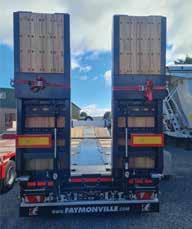


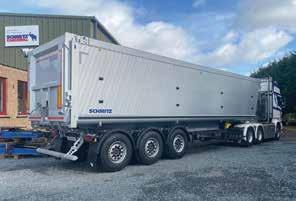
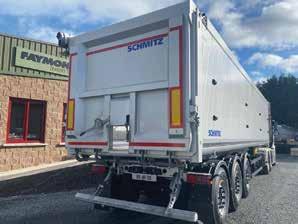




Jim Toner was described by his family as a “mild mannered man”. A redeeming quality that the road haulage industry can sometimes knock out of the best of men, but not Jim. The origins of Toner Transport go back to 1933, when, from humble beginnings, Jim’s parents, James and Margaret established the business at Newport Street in the Liberties, in the shadow of the Guinness Brewery.
In those days things were simpler, freight and goods were delivered by horse and dray. Jim’s arrival in the business coincided with a major step-up, the arrival of a Commer truck with a platform body. While the Commer brought protection from the weather, it brought also brought about a bigger change in the operation of the business, allowing the company to expand its horizons at a time when the Irish economy was starting to grow and prosper.
Toner Transport was going places, flowing with the tide that came with an expanding economy. As the family firm increased trade, so too did the requirement for a bigger premises, resulting in a move to Cookstown Industrial Estate in West Dublin. By then Jim’s sons were getting involved in the business and while they might not have been aware at the time, they were

learning from a master. Jim’s values were simple, he liked people, worked hard, and similar to many transport operators, enjoyed driving. All he needed was a bottle of Lilt and a packet of cigarettes to take to the road.
In business, he kept things informal as much as possible, meeting customers as he delivered to them, building solid business relationships. One significant client, The Smurfit Group, is a perfect example, where his professional and personal relationship with the Smurfit family has passed through the generations.
In that great Dublin tradition, Jim met Ann, his life partner, at Clerys dance hall, and throughout his life his family were the centre of his world. Jim enjoyed the odd game of golf, and with Ann, they were regular attendees at the IRHA Conferences over the years, forging many long-time relationships.
Jim was very proud when he saw the family business relocate to Greenogue, although by then he had somewhat taken a back seat. Still, his influence was to be seen everywhere, and he was always interested in what was going on. Some called him James, others Jem or Jim, but everybody respected and learned from him. For those that called him Dad, he imparted simple values, not always seen. Jim saw the best in everyone, closing every conversation with simple words: “Thank you, you’re very good”. (RIP) - SM
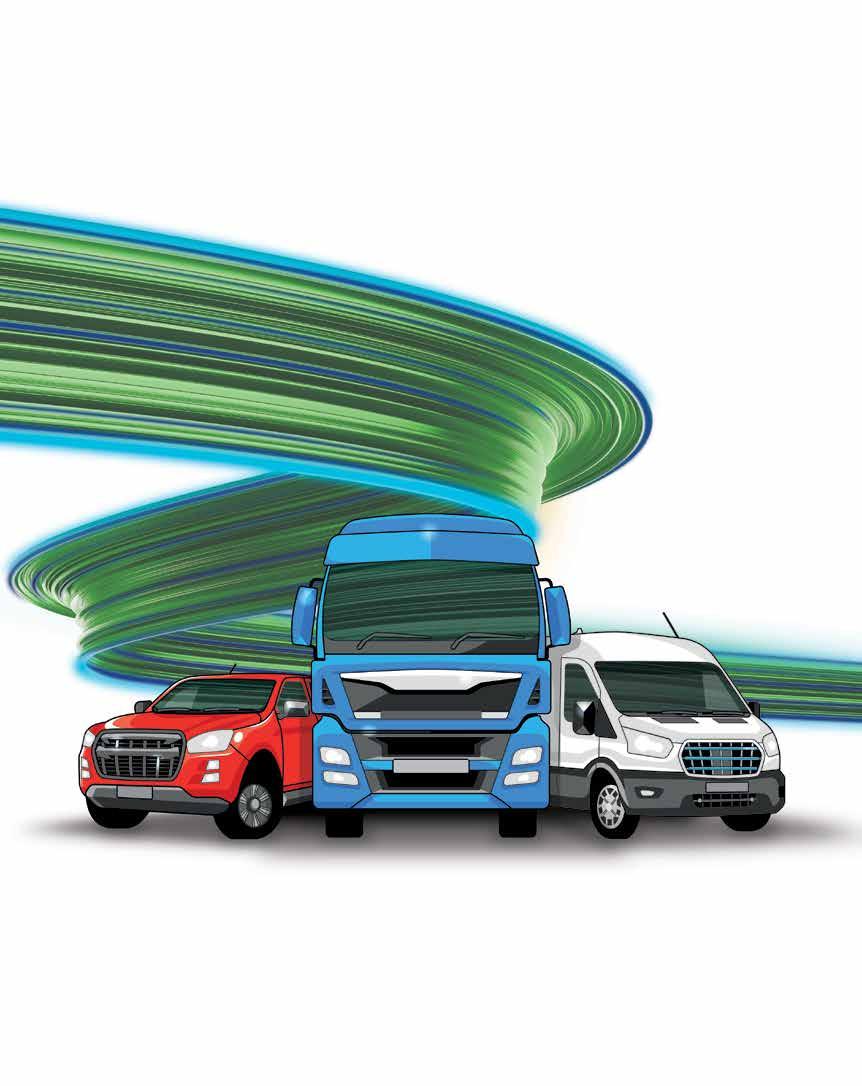
Harald Seidel (55) succeeded Harry Wolters as Chief Executive Officer of DAF Trucks NV., in August last year. He has worked at DAF for 21 years, mostly in financial positions. For the past five years, he was based at DAF’s HQ in Eindhoven.


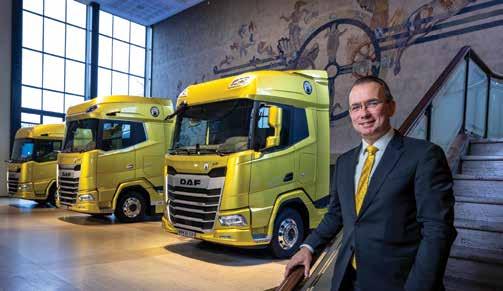
How do you look back on the business year 2022 for DAF Trucks?
It has turned out to be a fantastic year. We launched new DAFs, recorded production and market share highs, and won the International Truck of the Year Award again this year. DAF Trucks is doing incredibly well.
the customer doesn’t get the ordered vehicle.
Outside Europe, we sold 7,400 units, less than in 2021 (8,800), but that is mainly due to the Russian market falling away. The 200 trucks delivered there this year were from January and February.
How is the business in Russia doing? That is at a complete standstill. We no longer deliver trucks or parts, our offices are effectively closed. Whether we will ever work in Russia again? Nothing to say about that at the moment.
Where will DAF finish at the end of 2022 in terms of market share?
Year-to-date, as of week 47, we have a market share in Europe of 17.4%, an absolute record. And with tractor-units it’s at 20.5%. That’s the market leader in Europe, from an overall market size of 275,000 to 295,000 truck units. In all European countries we are gaining market share, while in Germany and France in particular, we are scoring record numbers.
How many trucks does DAF currently produce?
cannot keep pace. The big shortages are behind us though, but when you produce as much as we do, you have to look for creative solutions. Yes, we have
Whether it can do better? There is always room for improvement, but what we are seeing now is the first reflection of the excellent products and services we have in the marketplace. And I see that success as a result of real, optimal teamwork. Incidentally, that really comes into its own in crisis situations, such as the chip shortage. That’s when walls between departments fall away and everyone works together to find a solution. It won’t happen to us that
About 250 units per day. Never before has DAF made so many trucks per day. Are we at the top of our capacity? No, we can always make more. We are constantly looking at how we can improve our procedures and produce just that little bit more. No, I’m not saying where our maximum capacity is at. But there is always room for stretch.
Talking about chip shortage, what is the current situation?
The supply chain situation has improved, but it is still incredibly tight. For all suppliers, they have had to scale up after Covid and there is always one that
parked unfinished trucks because a part wasn’t there. We only did that if we knew a part would be there in the foreseeable future. All those trucks that were once parked have now been delivered.
How many units of the NGD XF, XG and XG+ have been sold now, and how many of the new XD?
Of the XF, XG and XG+, from the beginning we have sold more than 60,000 units. And of the XD several thousand, but we have only been selling them since September. Without exception, the trucks are very well received. Customers are very satisfied. The XG and XG+ are real premium, the XD offers so much visibility like no other truck in its class. Delivery times? That has depended a bit on the country and specification, but generally customers should be able to get a DAF truck in the second quarter of 2023. They will have to order quickly though!
DAF has now won the International Truck of the Year Award twice in a row. That’s a great accolade, but what’s the practical use of it?
Winning the IToY award means independent confirmation, from the best international commercial vehicle media, that your truck is the best new truck. Dealers can do a lot with that towards their customers. Also important is the confirmation for us at DAF internally. DAF has traditionally been a modest company, and the awards are confirmation of what we can achieve with our products and our team. We should be proud. And yes, shaking off that modesty, we are getting better at it.
Is the new Electric Truck Assembly section open yet?
That one is just operational now. It is currently building field test trucks that will start driving to customers from January. From April/May, the first trucks will be produced to order. The chassis and cabs will be built alongside other trucks here. In the Electric Truck Assembly, they will get the electric motor, control module and battery packs. We deliberately chose to build this new generation of e-trucks in-house. That’s what we do at DAF, build trucks. Previous generation versions, which we developed together with VDL as a start-up phase, was an exploration. Dozens of the CF Electric have been sold. With this new assembly hall, we can scale up considerably, building thousands of electric XD and XF units.
currently, the European commission is piloting the Euro 7 standard. How does DAF view this?
We have always said that there is a future for the combustion engine. Its role is far from over. But at the same time, we wonder whether the step to Euro 7 is the right one. From Euro 6 to Euro 7 only very small gains in NOx and
particulates can be made, but it costs a lot of money. We think it would be more effective for air quality if the Euro 3, 4, and 5 trucks were replaced by the latest generation, clean Euro 6 trucks. And yes, it is true that several truck manufacturers have expressed this view. We are fairly harmonious about that.”
From your earlier career in finance, are you really into numbers and is that an advantage in this new position? I am always looking for the connection between the figures and the people, the business processes. Therefore, I’m not a pure finance guy. After my studies, I started working in organisational consulting and that was because even then I knew that figures are the end result of what people create as a team. At DAF, for instance, I have always found pleasure in working with different departments. How can we work together so that we achieve a good result, but also so that the customer is satisfied and the business process is good. I enjoy that, it gives me energy. The financial background is an advantage, by the way. We also steer on KPIs other than just profit, but the fact that you can quickly comprehend figures is definitely an advantage when you are in this position.”
What do you see from the current global crisis in the markets where DAF operates?
We were already suffering from high raw material costs before, to which we are now adding high energy and personnel costs. So there will be higher cost pressure. There is uncertainty in the market, also for next year. At the same time, we also see that the need for transport is not declining. Fleet owners have held on to trucks longer because of
Covid, now they will renew or expand. There is more demand than we can produce. So yes, there is uncertainty, but we are currently very happy with the transport market. What the world looks like next year, however, is unclear for everyone.
on linkedIn, you posted a post about teamwork, with a Bible text attached. Is the Bible an inspiration?
Those who follow me on LinkedIn know that I often use aphorisms. ‘Two are better off than one, for they can help each other to succeed’, this one came from the book of Jesus Sirach, a wisdom book thousands of years old. He also refers to working together, to teamwork. I find it beautiful and inspiring that such an old saying still applies today.
What will 2023 bring DAF Trucks?

We want to expand our market position, to 18% in the heavy-duty segment and 11% in medium-duty. In building and construction, we can grow with our new trucks. The Electric Truck Assembly will really start up and running next year, which is an important milestone. And also very important: continuing an open culture within DAF. I try to do that myself by not just sitting behind my desk, but also joining teams. Work shoes on and into the factory. And I have lunch once a week in the company canteen. I learn a lot from that.
Your predecessors were Presidents of DAF Trucks and all left for PAccAR in the US. What are your ambitions?
Ha, I have just been PresidentDirector for four months! My ambition in the coming years is to be of service to DAF Trucks, to the customers and our employees and to achieve great results together. Helping employees getting better and making great strides in innovation. Until now, every job I’ve had, I’ve done well because I liked it. I never looked too far ahead. Don’t look too far ahead in your life, you only have today.
Are we finishing with an adage then?
“Yes indeed. Let me phrase it properly: Yesterday is history. Tomorrow is a mystery. Today is a gift. That’s why we call it the present.”
Text: Arjan Velthoven – IToY Photos: Koos Groenewald
Interesting times in the truck industry as all manufacturers take the electrification propulsion route, in some shape or form. It’s a case of having to, in order to meet new European Union zero emission targets and facilitate interest and growing demand from customers. The biggest issue with the transition to electric powered road transport is not related to the ability of manufacturers to build vehicles, rather it is the gross lack of battery charging infrastructure. Plans and programmes are in place, but one wonders just when ‘the Twain shall meet’.
Hats off to the manufacturers collectively on investing heavily in the zero-emission powertrain technology that has entered the marketplace already, with more to come. In addition, a number of start-up companies are entering the fray with their own takes on national and urban distribution together with offerings for waste management operators.
Volvo Trucks has fully embraced the zero-emission technology and is now marketing a full range of medium to heavy duty electric trucks, including multi-axle rigids and tractor-units, from its selection of standard FL, FE, FM, FMX & FH model lines.
4x2

According to Martin Tomlinson, Head of Media & Truck Demonstration, Volvo Trucks UK & Ireland, enquiries are coming from all sides; hauliers, own account operators, couriers as well as consigners and freight forwarders - all seeking more information on what’s on offer and how they may best suit their needs.
Some are looking well ahead, while others are making the environmentally friendly statement now. In Ireland, the take up is gaining ground, with Diageo putting four Volvo eFE Electric 19-tonners on deliveries around Dublin, while one of the most prominent Irish transport companies, Dixon International, based at Swords, has ordered the first Volvo eFH Electric tractor-unit to operate in the country, with delivery expected within a few months.
This investment continues Dixon’s carbon footprint reduction path, having dedicated a portion of its truck fleet to natural gas power in recent years.
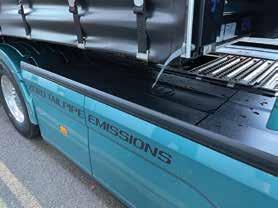
“We have decided to invest in the Volvo Electric truck as part of our overall sustainability strategy. Having already been running several CNG powered trucks since 2018, we believe that the move to electric is the next step in the journey to running a more environmentally friendly fleet,” explained Michael Dixon, Managing Director, Dixon International, commenting on the company’s latest truck fleet purchase. “Initially the Volvo Electric truck will be servicing our domestic collections and deliveries in and around the Dublin area. On any given day, our domestic fleet is collecting and delivering anything up to 120 loads
around the country. This means that we will be able to slot the Volvo Electric truck in seamlessly without having to worry about range issues, as the mileage offered will be more than enough to do a normal day’s work of a domestic truck.”
The Volvo FM Electric 4x2 Globetrotter tractor-unit features the same drivetrain, wheelbase and cab options as its FH electric sibling. To carry the load are six 99kW batteries, all nicely tucked in along the chassis rails. Each
weighs 250kg and 80% of the power available from the lithium-ion packs can be used at any one time. The overall power is rated at 666hp with 2,400 Nm of 100% torque. Up to 300km is achievable on range distance, that is when fully loaded and driving on motorways at less than 90kp/h. Compared to its diesel compatriot, the eFM BEV tractor-unit version, with Globetrotter cab spec, weighs in two tonnes heavier. As test driven, the eFM was combined with a twin-axle rear steer Krone box trailer, enabling up to 17 tonnes to be loaded on board. Both the eFM and eFH electric trucks are fitted with alloy wheels and air suspension to help reduce weight, with the FH weighing 150 kg heavier than the
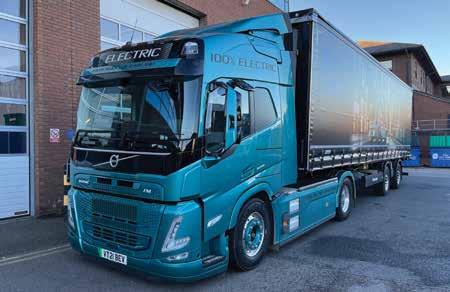
FM. A 6x2 tag axle tractor can also be specified, configured to the same 3.9m wheelbase as the others.
On a trial drive around Warwick and on to Coventry, the articulated, supermarket-friendly delivery unit progressed smoothly though the streetscapes, gliding to a stop at traffic lights and setting off again effortlessly. Martin explained that due to the efficiency of the I-Shift gearbox, the eFM BEV starts off in 7th, moves on to 10th and up to 12th in seamless movement.
The move to electric requires a change of mindset from the driver’s perspective, something we’ve discovered driving electric vehicles in general, and this eFM 4x2 tractor-unit is no different. The alternative energy system takes a bit of getting used to in order to gain maximise travel distance. Initially the experience is surreal, as the silence is deafening! Where has all the throttle roar gone, up and down the gears? One thing that is not missing is the power
- though gauging the deceleration level takes a little getting used to. Martin recommends that to achieve the best traction in this direction, leave the engine brake on stage one. On hilly terrain, the engine brake, through its various stages can provide the slow down, while recharging the electric battery packs and the truck’s batteries also. Mated to the 540 kWh 3 motor (of which 378 kWh – 70% is usable) is the standard Volvo I-Shift 12-speed automated transmission, that also has a manual function.
Mentioning the silence previously, indeed it’s noticeable, both inside and out. To counteract any danger to vulnerable road or street users, a fake audible noise is emitted at speeds around 10km/h. Even when stationary after a journey, it was noticed that the fan based cooling system still operates to bring down the high temperatures of the working drivetrain.
Helping to eliminate blind spots, the mirrors on both sides have a side collision warning system which shines a small red boomerang shaped light to alert the driver of obstacles or overtaking vehicles.

For urban deliveries, the eFM with its two step entry cab, is ideal for drivers who have to constantly jump in and out. The higher mounted eFH cab has three entry steps and a flat floor for more convenient moving around inside. Incidentally, eFM has the same cab as the diesel version, with its engine hump and all, even though
there is no engine block underneath. Martin explained that the battery electric (BEV) variant is assembled on the same production line as the diesel and gas versions and to change this modular design would knock the system out of line and cost more!
When it comes to charging times, this depends on the charging point power connection and on tap availability. For instance, with a 250kW DC fast charger, the eFM’s battery pack can be rebooted from zero to 80% in 1hr 25min, with another 30 minutes taking it up to 100% charge. Otherwise, a 43kW AC system can take up to 10 hours to get back the maximum range distance.
Volvo Trucks is committed to driving the progresses and shaping the future landscape of sustainable transports
and torque. The acceleration is amazing and with strong regeneration from the deceleration modes, a one pedal system is all that is needed to move the electric truck along, whether accelerating or slowing. By easing off the throttle when needing to stop in a traffic situation, for example, the driver can stop without having to actually press the brake pedal
together with its partners, i.e. its customers. The examples experienced clearly demonstrate that the Swedish brand is on the right road.
Text & Photos: Jarlath Sweeney - editor@fleet.ie
V olV o eFM El E c TRI c 4X2 T RAc To R - UNIT
cab type: Globetrotter

Engine: 3 x Electric Motors, Power; 540kW (70% usable)
Torque: 2,400 Nm
Gearbox: I-Shift 12-speed automated
ESS Batteries: 6 x 99kW Lithium-ion batteries (540kWh useable)
Range: Up to 300km
Wheelbase: 3,900mm
Rear Axle & Suspension: Air, Ratio 3.36.1
Front Axle & Suspension: Air, 8.5 tonnes
chassis height: Medium
Gross combination Weight: 32 tonnes
Tyres: Front; 385/55 R22.5. Rear; 315/70 R22.5
Trailer: Krone box, twin axle with rear steer

The recent addition of five new Mercedes-Benz Actros tractor-units sees one of Ireland’s largest transport companies, Perennial Freight start its New Year on the front foot. Forming part of a larger order, the new units arrive hot on the heels of five Actros’ delivered late in 2022, and will be followed by a further ten similar ‘tri-
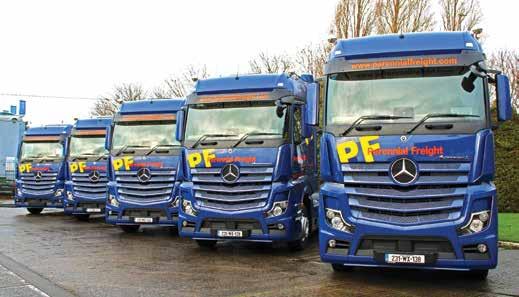
ple-pointed-star’ heavy-duty units to be delivered over the course of 2023.
These five new Mercedes-Benz Actros 1845LS, 4x2 tractor-units feature 2.5m BigSpace cabs and Actros ‘L’ packages – the most luxurious product offering in the model series. Chief amongst the driver comfort elements are luxury bunk beds, sliding fridge, night
heater, passenger table, ambient interior lights and glass sunroof.
Supplied by Motor Distributors Limited, of which Perennial Freight is a long-standing customer, the new tractor units will operate from the company’s Taghmon base in Wexford, servicing daily routes across Ireland, the UK and mainland Europe.
Quitmann O’Neill Packaging Ltd., based at Portumna, County Galway, a recent winner at the Fleet Transport Awards 2023, is now the proud owner of another new Renault T.480. 4x2 tractor unit, purchased from Martin Hough, Sales Executive at Dennehy Commercials Ltd, Limerick. Pictured with Martin at the key handover is one of Quitmann’s experienced drivers, Donie Clarke.
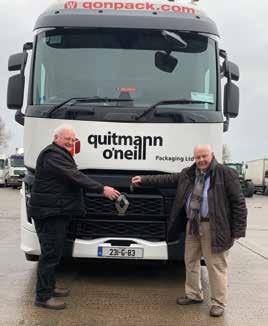
Ross Bourke of Bourke Waste, Westport, County Mayo is pictured with Martin and the company’s new MAN TGM 18.250 rigid, with Skip Loader bodywork. The Multilift ( HIAB) skip gear was fitted by GBL.
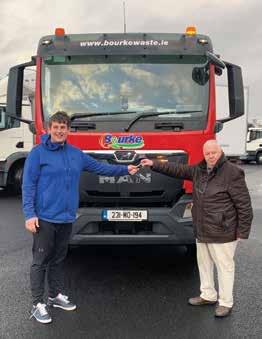
Three new versions of the International Truck of the Year 2022 Award winning DAF XF 530 4x2 tractor-units have entered operations at Hayden Transport. Based at Tullow, County Carlow, the new trio, sporting special in-line number plates, feature a High Sleeper Cab, extra fuel tank capacity, and many additional comfort items.
DAF Trucks Ireland Sales Manager, John McCann, pictured left, conducted the deal with Ollie Hayden (MD, Hayden
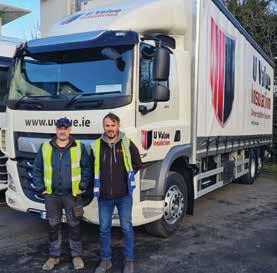

Transport), pictured centre with Daniel Miro, driver.
John McCann also concluded a deal with Yasmin Okic from U Value Insulation (Ballycoolin, Dublin) for this new DAF CF 290 6x2 rigid, with 6-speed ZF AS-Tronic transmission. Behind the Day cab is a 27’ curtainside body, built by Monread Truck Bodies, Naas. SignFx was assigned to do the livery.
n New Renault C.440 8x4 Mixers & Tippers
n Conveyor & Mixers available
n New Renault 8x2 rear-steer chassis, suitable for plant or curtainside body
n New Renault Rigid Curtainsider in stock

*New Renault T High 6x20 with new Turbo Compound engine, many extras incl. front air
n New MAN Trucks - Tractor-units & TGS 510hp 8x4 rigid with Sleeper cab and Gleeson Tipper Body

n New MAN TGM rigids with Lecapitaine fridge bodies in build
n New & Used Krone Box semi-trailers
n Used SDC Curtainside semi-trailers
n New Goldhofer 3-axle low loader with winch, neck ramps, outriggers
For your one stop shop visit Dennehy Commer C ials, Do C k r oa D, l imeri C k all vehicles with full warranty. recovery/ 24/7 Call out

*In aid of Cystic Fibrosis Ireland and Corrib Mask Search & Rescue
85 TRUCKS AND TRACTORS LIT UP THE SCENIC CONNEMARA ROUTE AROUND THE M AAM VALLEY AND J OYCE COUNTRY

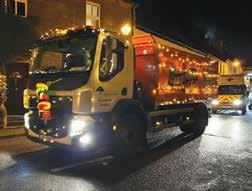


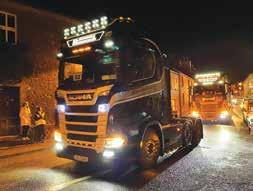
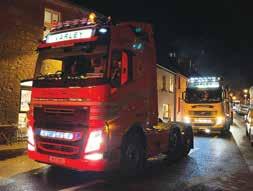
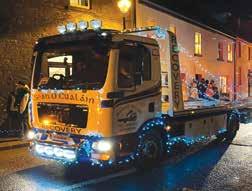
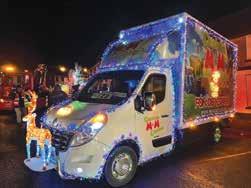

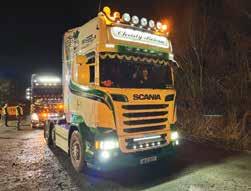

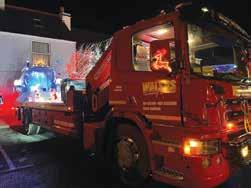
With 4 depots, over 40 skilled people & decades of experience we can look after all your fleet needs. We’re good at what we do. Let us handle it so you can be good at what you do.
As Sales Executive for Schmitz Cargobull trailers at Shaw Commercials, Kevin is an experienced member of our team Kevin uses his knowledge to provide you with solutions from the many options that Schmitz Cargobull Trailers provide, to meet your requirements. Kevin has strong connections with the production plant in Germany, ensuring the smooth progress of customer's trailer production, through to final delivery, with regular updates Kevin is your best resource to find the trailer that fits your needs with the Schmitz Cargobull badge of quality


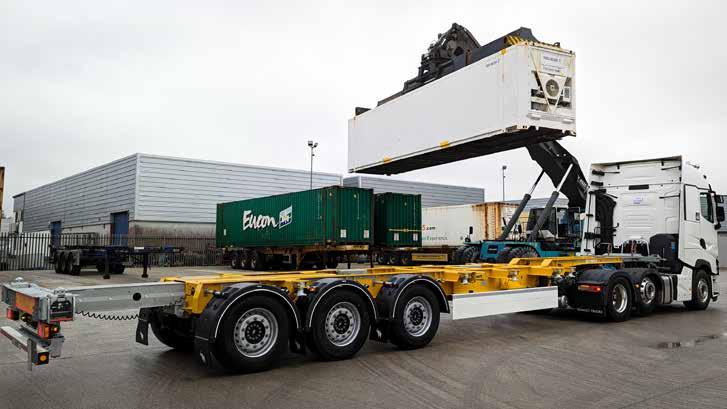
We have new stocks of Schmitz Skelly trailers which are ready to go. These trailers are available in different choice of colours.The Schmitz Cargobull Skelly trailer provides a versatile and safe solution for transporting containers It is capable of accommodating containers ranging from 20 to 45 feet in length and features sturdy locking systems to securely hold containers with extended tunnels and angled corners. With its focus on flexibility, safety, and efficiency, the Skelly trailer is a top choice for transporting containers with ease.
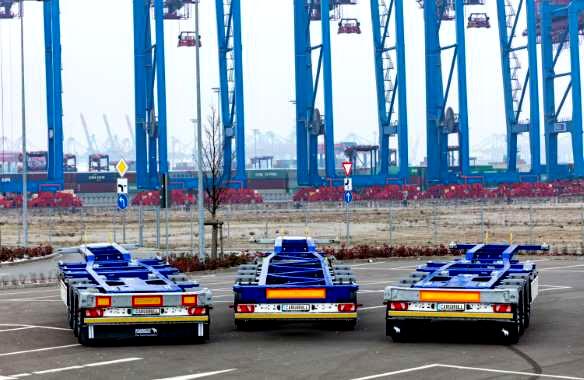
www.shawcommercials.com

With the S.CS FREEPOST, you can rest assured knowing that your goods and your drivers are safe. It is available in different heights from 4,200 mm to 4,800 mm, and doesn't require any sliding posts. Contact Kevin for more details. 10 -12 weeks delivery time.
New Schmitz Single / Multi Temp Fridge New Schmitz Single / Multi Temp Fridge trailers available in stock trailers available in stock

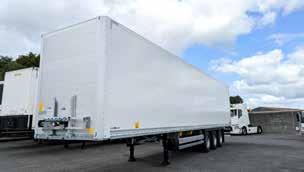


At Shaw Commercials we have new Schmitz, Carrier, Thermo King - single and multi temp fridge trailers which are in stock and ready to go. We also have pharma spec trailers available. We can customise the trailers based on your requirements.
New Schmitz Dry Freight Boxes In Stock New Schmitz Dry Freight Boxes In Stock & ready to go & ready to go
At Shaw Commercials we have a broad selection of Box vans with or without taillifts in stock We also have box vans with rollerbeds designed for companies who provede air freight services
Kevin O'Grady 087 100 6211

The recent addition of the CF Electric to the DAF Trucks range led to this second edition of the unusually titled ‘Buy a DAF!’ by Rob Appels. In essence, the subtitle of this coffee table sized 232 page hardback, ’The promotion of more than 90 years of innovative transport solutions’, suitably explains just what this fine book is all about.
Author Rob Appels, is head of communications at the Eindhovenheadquartered manufacturer, which once made cars too!
The Dutch manufacturer, owned by the US-based Paccar Corporation since 1996, has made steady progress over the years, with product and drivetrain developments bringing sales success, while DAF has also been honoured with
Maurice, an enthusiastic brochure collector, to share his precious possessions. Adding to the overall colour from the vast array of photos are standout illustrations from Charles Burki.
As a form of introduction, Rob brings us back to the 1930s and to the origins of the firm, when in 1928, DAF’s founder Hub Van Doorne, set up a small engineering business. Today, DAF offers a most modern truck range, together with a range of services, backed up by a 1,000 plus strong dealer network around Europe. However, perhaps surprisingly, it was semi-trailer manufacturing that Van Doorne specialised in initially, with innovative concepts such as the forerunner of today’s container transport. By 1950, a new factory facilitated market expansion and a diversification into truck and van building. Military vehicles for the Dutch Army were also developed and produced. 1956 marked the 20,000th truck unit manufactured.
also featured.
The book’s middle section features a broad selection of trailer and trucks catalogues, with most of the detail in Dutch with English translation on side panels.
Another interesting avenue explored in the book was the development of dedicated bus and coach chassis as well as the DAF ‘tool car’ pick-up. Then there was the Liefernagen, a compact panel van (1962). Also in the 1960’s era was the Pony utility vehicle and the legendary 33 car, combi and pick-up. During the 80’s and onwards, DAF panel vans based on Leyland products were marketed, a production that continued on as LDV in due course.
numerous awards. But the foundation of where the company is today stretches back over previous decades, as explained in detail in the book. Rob utilised assistance, co-operation and contribution from catalogue collectors, together with various documents from the DAF Museum when putting together this history, even roping in his brother
The term ‘Mother of International Haulage’ was created on the launch of the 2600 heavy duty truck, the forerunner of subsequent well regarded and ground-breaking models such as the 2800, 3300, 3600 and 95 which firmly established DAF as a trusted truck brand in a very competitive world. By then the collaboration project with British Leyland resulted in DAF taking over the once dominant English brand, a merger not without its challenges. Over time DAF successfully turned around the fortunes of its new acquisition, and today Leyland Trucks Ltd (Lancashire) still produces DAF Trucks for RHD markets plus others.
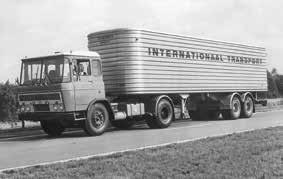
One of the first references to DAF cars in this book is the 600 model beautifully drawn by Charles Burki. In the chapter dedicated to his decades of artwork, DAF cars and trucks feature prominently, as well as intricate engine and axle details. DAF buses and futuristic concepts were
By the end of the 1990’s and into the noughties, DAF developed and launched a renewed series of trucks ranging from light duty LF models, the CF medium to heavy rated truck, and the XF95 and 105, all featuring a revised look and latest technology.
The renowned ATi engine line was superseded by the ATe, based on the 12.9-litre PACCAR MX driveline. It was fitted to both the CF and XF. Other innovations included the CF Silent and the latest CF and XF distribution, construction and long haul trucks. These were replaced by a whole new model series from 2020-2022, namely the XD, XF, XG & XG+, but Rob doesn’t touch on these new series. That’s a job for another day.

Even without these latest models, this mostly pictorial history is a different and interesting insight into the iconic DAF brand. Rob’s vast knowledge on the subject is evident, and this well put together chronicle is one for all truck enthusiasts to discover and enjoy.
Text: Jarlath Sweeney - editor@fleet.ie

www.fleet.ie
www.fleet.ie
Engaging Connectivity
Engaging Connectivity
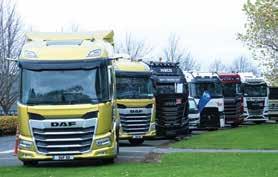



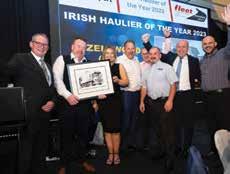


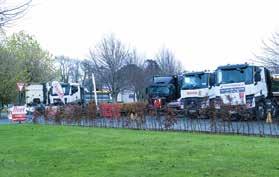




SAVE THE DATE:
Date: Thursday 9th November 2023
Venue: Johnstown Estate Hotel, Enfield, County Meath
SPoNSoRSHIP oPPoRTUNITIES:
n Create opportunities, build your brand and achieve a return on your investment
n Most valued and respected Awards programme in the transport industry
n Be associated with a high quality, popular event
n Widen customer contacts through networking at the event

n Meet and network with the key decision makers from the road transport industry
n Be part of an ongoing social media campaign
For further information on sponsorship opportunities please contact: Orla Sweeney - +353 86 2439239 orla@fleet.ie Mary Morrissey - +353 87 2178495 mary@fleet.ie
www.fleet.ie




The most anticipated off-road adventure of the year, the 45th edition of the Dakar Rally, widely regarded as the toughest event since the competition moved to Saudi Arabia, came to a close with a success for IVECO’s new teams. The IVECO Powerstar trucks, powered by Cursor 13 engines specially engineered by FPT Industrial, passed this test of extreme endurance with flying colours, having driven over 8,500 km of perilous terrains, including vast expanses of sandy dunes.
On his fourth Dakar, Janus van Kasteren jr (#502) in the Boss Machinery DeRooy prepared Iveco capitalised on his previous Dakar experiences to deliver a consistent performance, collecting several podium positions and ultimately first place in the final standings. He was followed by veteran driver, the legendary Martin van den Brink, in the Eurol Team DeRooy Iveco who finished third. Martin’s son and teammate Mitchel van den Brink also drove an impressive race, collecting several second places and becoming the youngest special stage winner on SS6, eventually closing the competition in fourth place. The runner-up position went to Czech driver Martin Macik, in a similar but privateer Iveco Powerstar. The other Powerstar pilot, Vick Versteijnen (Boss Machinery DeRooy Iveco) had to retire on Day 4 of the competition.
Unfortunately, early leader Alez Loprais in the Praga V4S DKR #508 had to withdraw, following a tragic accident involving a spectator, while conspicious
by its absence was the previous all dominating Russian Kamaz squad, which is run by the Kremlin’s military.
Fabio Santiago, Head of Marketing & Product Management IVECO Truck Business Unit, stated from the winner’s podium: “We are very pleased with the results achieved by our teams and our Iveco Powerstar trucks, although the victory is tinged with sadness for what happened during the ninth stage: first and foremost, our thoughts and solidarity go to all those involved. We nonetheless need to show our gratitude to our pilots, who pushed themselves and their vehicles to the maximum, and delivered a fantastic performance in the toughest of the Saudi Arabian Dakar rallies. We are so proud of all our crews, who took on this challenge with grit and determination, making our trucks shine with winning performances.”
In the T1+ car category, Qatar’s Nasser Al-Attiyah and his French co-driver, Mathieu Baumel, successfully

defended the Dakar title they won for Toyota Gazoo Racing (TGR) in 2022, bringing their GR DKR Hilux T1+ over the finish line on the final stage of Dakar 2023 at the coastal city of Dammam with a margin over their nearest challengers of 1 hour and 20 minutes. This was Nasser’s fifth car class win in the Dakar Rally, while Mathieu’s tally is now four victories. The pair have won three times for Toyota, with the latest back-to-back victories highlighting the Japanese manufacturer’s quality, durability and reliability. The pair took over the lead of the event on Stage 2, and never relinquished that position.

Team-mate South African Giniel de Villiers completed his twentieth consecutive Dakar Rally in 4th place in the overall standings. This result brings his total number of Top 5 finishes to 15, including one victory in 2009. Toyota dominated the Dakar 2023 results, with the works TGR crews finishing 1st, 4th and 5th.
Second to Nasser was multi-WRC Champion Sébastien Loeb, who
recovered well after losing significant time early on. The Frenchman also added his name to the Dakar record books with a string of six consecutive stage wins (seven in total), in the Prodrive Hunter BRX.
Commenting on the continued success, Glyn Hall, TGR Dakar Team Principal said: “What a day for our entire team! Winning Dakar is something memorable, but winning the world’s toughest race twice in a row is simply extraordinary. My sincere thanks to every member of our team, every one of our sponsors and, of course, our drivers and co-drivers, who delivered a stunning result. I’m really proud of our GR DKR Hilux T1+, which has proven yet again that it is reliable and durable enough to not only complete the world’s roughest automotive race, but to do so two years in a row.”
The bike category went right down to the wire, with Red Bull KTM Factory Racing’s Kevin Benavides winning by just 44 seconds ahead of fellow KTM rider Toby Price. Kevin’s journey through the 14-stage race was one of outstanding consistency. Even though the Argentinian didn’t pick up one single second in bonus time for opening any stages, he finished inside the top 10 every day for the whole two weeks of racing. It was this skilful and calculated approach to the event that earned him his second career Dakar Rally victory after previously winning the event in 2021. The result also marks KTM’s 19th win at the Dakar.
Norbert Stadlbauer – Rally Team Manager was quite pleased: “It’s been an incredible Dakar – one of the toughest in history and definitely the closest! It’s been such a close battle inside the Red Bull KTM team with Toby and Kevin separated by just 12 seconds going into the final day today. Thankfully, the

performances of both riders gave KTM a one-two in the race, with Kevin earning his second win and the 19th for KTM. Of course, you can’t have two winners, but Toby claiming second place is still an incredible achievement and down to the hard work he has put in over the two weeks. The team have also done an amazing job, not just at the event, but also over the whole of the past year building up to this race. Now it’s time to celebrate before we look ahead to the next race in the season.”

235 of the 355 vehicles that started the 2023 Dakar made it to the finish. They included 80 motorbikes (out of 121), 10 quads (18), 46 T1 and T2 cars (67), 38 lightweight prototypes (47), 39 SSVs (45) and all 22 trucks, along with 80 out of the 88 crews in the third edition of the Dakar Classic, the regularity race for 20th-century vehicles.
Text: Jarlath Sweeney - editor@fleet.ie
If tailboard goods lifts have been fitted to vehicles they must be risk assessed to determine how they are to be used safely. All tail-lift operations are potentially hazardous and should be planned to make sure that all foreseeable risks have been taken into account. Poor planning is one of the major causes of accidents arising from tail-lift operations. All risks associated with the use of the tail-lift safely must be identified and assessed, and written down in a safety statement. Using a tail-lift usually involves working at a height, that is, on the body of the vehicle or on the platform itself, and the hazard of persons falling should always be a consideration in this risk assessment process.
Tail-lift accidents are generally caused by one or more of the following factors:
n Persons falling off the vehicle body or the lifting platform
n Loads falling off the vehicle body or the platform
n Loss of control of the load
n Crushing or shearing of body parts between the moving platform and the vehicle or ground
n Failure of the mechanism of the platform
n Failure of the structure of the platform or the vehicle
It is vitally important that tail lift operators are trained and competent to operate these lifting platforms and they need to follow documented procedures

*Is it time to renew your tail-lift risk assessments?
in relation to their use. Training for an operator should, at a minimum, cover the controls, working load limits, load charts, any operating limitations of the type of tail lift they operate, as well as step-by-step safe working procedures.
A vehicle-mounted tail lift should not be taken into use for the first time unless it has been examined and certified by a competent person, or it is properly CE marked. In order to ensure its continued safe functioning, the tail lift must be thoroughly examined by a competent person at least once in every 12 months, thereafter. The competent person should complete a report of thorough examination. The employer should ensure that the tail lift is strong and stable enough for the particular intended use and marked to indicate safe working loads. Records of the training, regular maintenance and inspections, and the thorough examinations must be kept.
A daily pre-use inspection regime should be implemented, and planned maintenance should be organised depending on the use of the vehicle-mounted tail-lift and the environmental conditions in which it typically works. A good way of doing this is to follow the manufacturer’s maintenance instructions. In addition to maintenance requirements, daily pre-use checks should ascertain, for example, that markings, warnings, decals, and reflective material are in good condition.
In addition to the mechanical considerations above, care must be taken with regard to safety in the use of the tail-lift. The employer should consider the slip resistance of the surface of the vehicle body and the lifting platform, as well as the need for slip resistant footwear for the operator. Some tail-lift manufacturers have developed guard-rail solutions and increased slip resistance of surfaces, and while it is not a legal requirement that tail-lifts are supplied with these, there is
a legal duty on the employer to decide, through risk assessment, whether these safety measures should be provided. The area in which a vehicle-mounted tail lift is to be used must be carefully assessed to ensure that it is suitable before the lift is put into service, and consideration should be given to the unloading operation at the end of the delivery cycle. The operator should be involved in these assessments. During such an assessment the following points should be considered by the employer:
n Is there space to lower the tail-lift safely?
n Can the vehicle be parked safely without causing an obstruction?
n Freight presentation – is the freight in a suitable condition to be moved?
n How heavy is the pallet, can it be manoeuvred without causing injury or losing control of the load?
n Is the ground surface suitable and are there any slopes or inclines?
n Is there pedestrian activity and is it appropriate and possible to restrict pedestrian access to the area?
n Are there other vehicles and vehicle movements in the work area?
n Can a suitable route to the point of the kerbside delivery be planned and agreed?
Tailboard goods lifts are very useful items of equipment, but they must be given careful consideration to prevent adverse incidents associated with their use. For further information and practical advice on the safe use of tail lifts visit the HSA website and download the Safety with Tail lifts information sheet. (at http:// www.hsa.ie/eng/Publications_and_ Forms/Publications /Latest_Publications/ safe_Vehicle_Tail_Lift_Operations_ Information_Sheet.79778.shortcut.html)

The Transport Operations & Commercial Driving Apprenticeship provides the academic qualification and practical training and work experience that supports a vibrant and exciting career in the freight distribution and logistics sector. Apprentices will also receive expert driving lessons and training in advance of completing their C/CE driving test and attaining the Driver CPC qualification.
The academic award for this apprenticeship is a Higher Certificate (NFQ level 6) in Business in Transport Services and is the first qualification on the national framework of qualifications (NFQ) linked to the profession of commercial driving!
✔ QQI Level 6 Award ‘Higher Certificate in Transport Operations & Commercial Driving’.
✔ Internationally recognised qualification.
✔ Earn as you Learn.
✔ Two year employment contract leading to permanent position.
✔ Gaining valuable on the job experience and workplace skills.
✔ Excellent Career Opportunities in the vibrant sector.
• Hold a Full ‘B’ Driver Licence.
• Be at least 18 years of age.
• Meet medical requirements for driving.


✔ Attracts new entrants into the business.
✔ Increases pool of qualified people within the business.


✔ Help with succession planning.
✔ The programme is built around work related experience and work specific projects.
✔ Apprenticeship State Grant for employers of apprentices €4,000 funding.
• Minimum entry requirements are a grade H7/O6 or above in five Leaving Certificate (or equivalent) subjects. A minimum of grade O6 must be obtained in English. A minimum of grade O6 or a B2 or above in Foundation level must be obtained in Mathematics.
• Holders of a QQI Level 5 or Level 6 (or equivalent) in cognate areas (eg business, logistics and distribution, supply chain management, etc.) can apply for entry onto year 1 of the programme.

• A mature candidate, over the age of 23, who does not hold qualifications as set out above, but who:
Has a minimum of two years’ experience working as a commercial driver. Is recommended by their employer. Demonstrates the correct attitudes, behaviours and literacy skills.
The Coordinating training and education provider for this apprenticeship programme is Atlantic Technological University Sligo (ATU Sligo) The lead proposer us the Freight Transport Association Ireland (FTAI)







According to Society of the Irish Motor Industry (SIMI) figures, new Light Commercial Vehicle (LCV) registrations in 2022 saw a decrease of 17.7% (23,653) compared to 2021 (28,742) and were down -6.6% on 2019 (25,336). New Heavy Commercial Vehicle (HGV) registrations recorded a decrease of 8.1% (2,494) in comparison to 2021 (2,715) and -6.2% on 2019 (2,659).
Commenting on the figures, Brian Cooke, SIMI Director General said: “2022 was another challenging year for the industry with both commercial vehicles and car sales being impacted by supply constraints. A similar picture was also seen at a European level with ACEA reporting in November “new commercial vehicle registrations across the EU were down by 15.5% to nearly 1.5 million vehicles”. We would be hopeful that 2023 will see stronger growth for the sector which is all very much dependent on supply and economic circumstances.”
“Despite strong demand, persistent supply chain issues continue to impact production, which is a global challenge. We would expect to see the supply issues continue in 2023 and it is difficult to determine when this issue will correct itself as there are so many external factors at play that influence production for the various manufacturers. It does appear that there has been a significant
improvement in the supply of semi-conductors, while China appears to have moved away from a COVID lock-down approach. These factors should allow for improved supply of components for vehicles, but there will be a time-lag before this feeds into vehicle production and supply.”
With inflation hitting all business sectors, Brian outlined that there are many factors to take into consideration when purchasing a new vehicle. “Purchase cost is of course one of the main considerations, so too is the savings to be made from vehicles that are more economically efficient, and with the increase in fuel prices, vehicle performance is a very important consideration. Demand for commercial vehicles is there, however supply continues to remain challenging.”
On dealers meeting the challenges of electric CVs, he stated: “The journey towards electrification for Commercial Vehicles begins with production. Manufacturers face the biggest challenge, as persistent supply chain issues have restricted production globally. The uptake of electrification technologies for the commercial sector remains some way off that of the new car market, as CVs differ with additional considerations in manufacturing, such as payload, space of vehicles body, total vehicle weight, range and charging infrastructure. Commercial vehicles are often custom-built professional tools involving multi-stage production processes and the final result must ensure that the
vehicle meets the requirements of the end users. When it comes to their use, time is a serious consideration, as any down-time due to charging impacts on overall profitability and efficiency, so fast charging is essential to reduce their down time. SIMI Dealers have the challenge of helping to educate their customers in the new technology and assessing the needs of their customers to ensure that they sell the product that best meets their business requirements.”
There seems to be no stopping the Scandinavian truck brands who continue to dominate the HGV sales league, with the Dutch, French, German and Italian brands fighting for what remains of just over half of the remaining sales market. Some brands offer from 7.5 tonnes to the maximum 46 tonnes allowed here, while others start at mid-duty weight range. For example, Scania only competes in the 18 tonne+ GVW market, while Volvo’s range starts at 12t. All of the other brands offer models under the 12t GVW level.

Thomas Diffley, Scania Marketing Manager, Westward Scania remains upbeat despite the current challenges:
“Our segmentation calculated a virtually unchanged market, perhaps down by a handful of registrations. That said, invoiced sales for Scania showed a healthy increase, largely due to delayed units, most of which arrived in Q4. These will inflate Q1 registrations whilst


“We would be hopeful that 2023 will see stronger growth for the sector which is all very much dependent on supply and economic circumstances.”
the actual market for 2023 is likely to soften somewhat. This of course will be skewed by delayed deliveries by all manufacturers, so Q1 will undoubtedly be strong overall. Input costs have driven truck prices to unprecedented levels, and while we are hoping that they may stabilise this year, there is no sign of abatement.”

be launched in 2023 for 2024 delivery, while continuous improvements to the current product portfolio will also be implemented.“
VolVo T RU ck S
Martin Tomlinson, Head of Media & Truck Demonstration, Volvo Trucks UK & Ireland is optimistic too: “The marketplace is still very strong and shows no signs of slowing down. 2022 was a very good one for us and the order books for 2023 are still very strong. Used stock is still a challenge as lots of customers are still keeping trucks they would usually return and extending contracts due to supply challenges with new trucks. Component shortages have improved but lead times are still fairly long depending on model.
exceptionally strong order book for 2023. Last year as a whole continued to prove difficult for the industry due to supply chain disruptions. We have also seen the effects of Brexit with a limited supply for used HGVs available in Ireland. We will still see component shortages in 2023 and potentially in Q1/Q2 of 2024 but we are adapting to a new way of doing business in the short term. Availability will be key and thankfully we have seen improvements in lead-times,” explained John McCann, Sales Manager, DAF Trucks Ireland.
On the ongoing component shortage issues, Thomas said: “We are still experiencing supply chain issues, and lead times are sporadic. We have not yet returned to traditional lead times, and given the disturbances in the world economy we do not envisage doing so for some time to come. That said, we are working with our existing customer base to try to satisfy their requirements, and they will remain our priority.”
Looking at the growing interest in alternative fuelled vehicles, Thomas added: “In parallel with the general automotive sector, I believe that early forecasts by manufacturers have been extremely optimistic for the adoption of EV’s. The haulage industry is an extremely competitive and cost conscious one, and aside from some own account operators and a few early adopters, most hauliers are adopting a ‘wait and see’ approach. The TCO has yet to be proven but discussions with customers are ongoing and we will contribute to this market segment as it develops. Gas is still important, and we have much more interest in this sector given the more widespread availability of Bio-gas. Our Regional BEV will
Volvo Trucks now offers a full selection of electric models, with increased interest and sales: We’ve seen a big order intake for electric trucks and certainly in Ireland. Big names such as Diageo and Dixon International along with several other companies across Ireland have placed orders for Electric Trucks. LNG is still a non-starter for us in the ROI due to having no infrastructure.”
Of note is the overall GVW of the heavy-duty Electrics: “It’s limited to 44 tonnes as we have to fit the RS1352 axle to get to 46 tonnes in Ireland on a diesel truck, but the spec for Electric trucks is locked down to the RS1344 axle which is limited at 44t.”
DAF Trucks continues to perform well and with the arrival of the IToY 2023 winning XD series, (replacing the CF), increased demand for the Dutch brand’s range is bound to happen during this year. “DAF finished the year with 13.8% market share and very importantly an

Commenting about the road ahead, John said: “We have continued to inform potential customers regarding DAF’s alternative fuel offerings in EV and Hybrid. The interest has been steadily increasing and we expect a number of electric units rolling out this year. 2022 saw the launch of the all new DAF NGD range in XF, XG & XG+, these are the first trucks on the market to fully benefit from the new European masses and dimensions regulations.”
Renault Trucks grew its market share by almost 1.5% in what was a difficult year, which was pleasing to Harry Nash, Managing Director, Setanta Vehicle Sales, Renault Trucks Importers & Distributors. “2023 has seen a strong start from the industry up almost 55% at time of writing on 2022 but this increase is likely to be more of a hangover of sales from 2022 rather than being indicative of a return to norm. Renault Trucks is tracking well with a strong start for 2023. With most manufacturers not out of the woods yet in terms of availability and lead times, I think the market will steady itself by Q3/4. Sales of HGV EVs will pick up this year into next, but I think we will see a wane in the market for Natural


“There seems to be no stopping the Scandinavian truck brands in dominating the HGV sales league, with the Dutch, French, German & Italian fighting for what remains of just over half of the remaining sales opportunity.”
“ Big names such as Diageo and Dixon International along with several other companies across Ireland have placed orders for Electric Trucks.”
Gas powered trucks until this fuel price stabilises.”
Regarding the second hand market, Harry noted: “The used market continues to be hampered by Brexit and the Duty position on imported vehicles. It has left a short supply across the country and has resulted in higher values on used trucks than ever before. We also see customers willing to buy higher mileage vehicles as a result. Setanta, however continues to have a strong Used Vehicle offering maximising its cross-Border dealer base with depots in Northern Ireland and now in the UK in Warrington - this will bolster our Used Vehicle stock availability. We have also taken Customs Clearance in-house to assist with imports.”
Meeting the move to electrification is also high on Harry’s agenda: “We are seeing a lot of State and semi-State Government body interest in these vehicles through tenders recently. We also see the larger hauliers looking to decarbonise their fleets, particularly where they have partnerships with larger organisations also looking to improve their sustainability. It will be vitally important for the dealer networks across all the manufacturers to be able to facilitate charging of these vehicles and we see a big move towards a rental model in this sector including the charging infrastructure.
On new additions to the Renault Trucks range, Harry concluded: “We will see the introduction of the First Turbo Compounding T Range Demos (4x2 & 6x2) hitting the road in the first Quarter.

We also eagerly await the launch in Ireland of the Range C and T E-Tech Fully Electric heavy-duty series towards the end of the year.”
Fergus Conheady, Sales Manager, Mercedes-Benz Commercial Vehicle Ireland is a little more cautious about the year ahead: “While the med-heavy duty sales result for 2022 was only 7% short of 2021, it’s fair to say that there is a far greater appetite for new trucks across the board than can be facilitated. We don’t envisage this getting any better this year and as a result are predicting a static national market this year, with maybe a modest growth.”
It seems the interest in alternative drivelines is stemming from the


blue-chip operators: “There is an increased interest in Electric for sure, however it’s fair to say that this is being driven by much larger organisations with a corporate environmental agenda. The simple fact is that eTrucks currently do not make financial sense in a traditional business case and as yet, no operators are opting for them as a genuine competitive solution over ICE vehicles.
We will be introducing eTrucks to Ireland from Q2 this year, starting with the rigid eActros, with zero-emission tractor-units set to follow by the end of the year.”

“ The used market continues to be hampered by Brexit and the Duty position on imported vehicles. It has left a short supply across the country and has resulted in higher values on used trucks than ever before.”
“ It seems the interest in alternative drivelines is stemming from the blue-chip operators.”












Ireland’s leading independent haulage company Nolan Transport has taken a major step forward, with a significant investment that will enable it to meet its customers’ supply chain requirements into the future.
Wednesday 11th January was a landmark day for Nolan Warehousing & Logistics . It marked the official opening of its new €12 million, 150,000 sq.ft warehouse facility, phase one of a planned five at the company’s 35-acre site just off of the Rosslare Road, Drinagh in County Wexford.

Ireland, along with the wider world, has seen unprecedented demand for warehousing facilities caused by changes in customer needs and disruption in the supply chain stemming from Brexit and Covid-19. Recognising these disruptions and changes, Nolan Transport is putting itself and County Wexford forward as a global leader for transportation and logistics services to its customers, both locally and internationally.
Founded by Jimmy Nolan and his wife Joan (christened Johanna), Nolan Transport celebrates 60 years in business this year. Starting out in 1963 with a single truck and a milk collection trailer, today the business, which remains family run, has grown to provide a broad range of supply chain services to its customers, including Transportation, Warehousing, Customs and IT Systems. It prides itself on being one of Wexford’s leading employers,
with over 1,000 staff and operating over 700 trucks, 2,000 trailers and other equipment within its owner asset-based fleet.
With its headquarters at Oaklands, New Ross, this new warehouse is Nolan Transport’s second County Wexfordbased facility. In addition, it operates offices and depots internationally in the UK, France, and Spain. Additionally, this month it opens its new branch in the Netherlands, with further expansion plans into other European locations planned over the next 5 years.
The new €12 million 150,000 cu.m. 22m high bay warehouse is the first of five planned similar facilities under its €50m vision for the Nolan Warehousing & Logistics Global Logistics Park. It has been specifically designed to facilitate customers’s needs and already is in high demand with global customers seeking high-end warehousing requirements. The new warehouse facility, named ‘Johanna 1 Building’ in honour of the Nolan family’s dear mother Joan, who sadly passed away suddenly on 16 December 2022, has been engineered and constructed to meet the most exacting international standards, and offers specialist sections for bioscience, clean room facilities and a containment wing. Additionally, it incorporates a sustainability plan, as the building will be powered via solar roof panels coupled with in-built smart controls for energy. The company is also looking into options to add railway connections and on-site wind turbines in the coming years.
At the official opening event, attended by public representatives, dignitaries and guests, Noel Nolan, Director of the Warehousing Division of Nolan Transport said: “This first phase of our facility and €12 million development will initially create and sustain 30 jobs.

I am very proud and excited about this venture. The ground floor measurement is 80,000 square feet with nine storeys of racking sitting within that space. [There are] 22,000 available pallet locations with a bespoke state-of-the-art smart
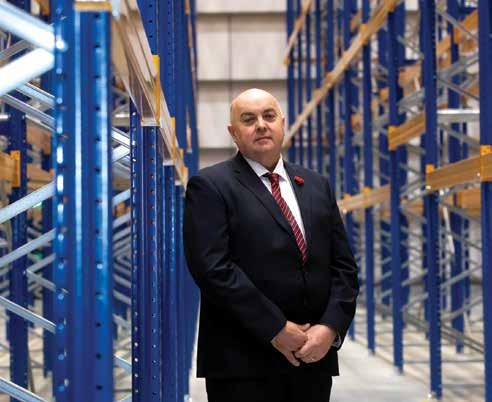
warehouse management system. This enables us to offer a complete end-to-end logistics and warehousing solution to suit a range of occupiers from SMEs to large manufacturing and distribution companies, and we are delighted to have exchanged contracts with a number of international brands already.
As the UK and European markets continue to adapt their supply chain and distribution models following Brexit, the market is experiencing record levels of demand and take-up. The market circumstances, coupled with our new facility and our 60-year-old Transportation Company, Nolan Transport, means that we are ideally positioned to unlock
opportunities to deliver high-quality and sustainable warehousing solutions, deliver more jobs and deliver more economic benefits for Wexford and the wider region, all the while, working even more closely with Rosslare Europort with its new direct to Europe and UK ferry operators. This is just phase one of five phases and we are already looking forward to continuing to re-invest in the region and build capacity for further job creation through the next development phases in our €50 Million anticipated sustainable development in our Global Logistics Park.”
Nolan Transport is currently ISO credited and is status pending for Seveso licensing and full AEO Customs status which enables the company to work even more closely with international operators managing high-value goods, and offering a bonded warehousing service.
Noel Nolan, who has worked in the company from an early age, chronicled the history of the family business which all began by accident. His father Jimmy had started work as an electrician in Birmingham with his brother in the late 1950s. Married to Joanna and with two children, he came home to New Ross to attend a family funeral and never went back. Following a conversation with a local milk collection haulier who was about to give up the job, Jimmy took on the role with Wexford Creamery in 1963. With a strong work ethic, dedication, investment and ambition, the business
has grown exponentially over the six decades. All of Jimmy and Joanna’s 13 children as well as some of the next generation are involved in the day-to-day activities of the business.
Asked about Nolan Transport’s ethos, Noel highlighted four main areas that have made it a successful business –innovation, attention to detail, looking after employees and ensuring that the customer remains king.
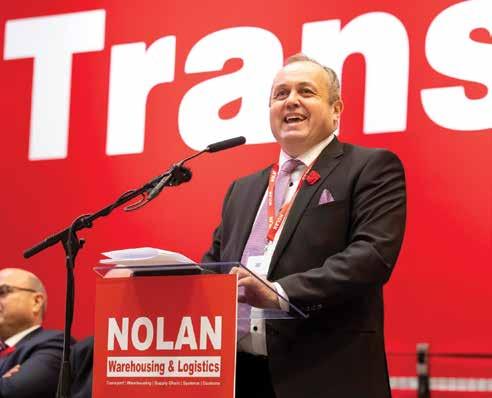
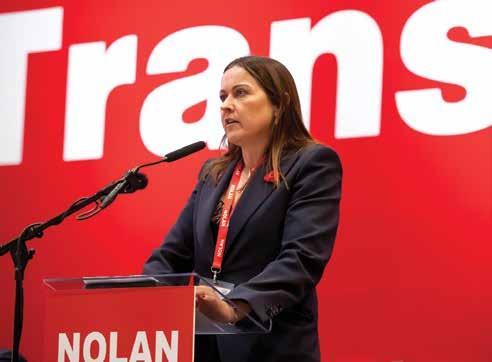
With over 35 years’ experience in working in the family firm, Kevin Nolan, who specialises in business expansion projects overseas, outlined the progress and extent of the company’s increasing penetration into and throughout Europe, including creating its own strategically located depot network and establishing like-minded regional partners. Along with six bases in the UK, which have seen increased trade since Brexit, two branches are situated both in France (Cherbourg and Fougeres) and Spain (Valencia and Bilbao). The most recent addition is a branch in the Netherlands at Roermond. A new office will also be located at Rotterdam, with over 100 new hi-cube trailers on order to meet these additional pan-European load schedules.
Tom Enright, CEO, Wexford County Council highlighted the vast contribution that the Nolan family has made economically to the country and to County Wexford, noting the company’s investment in infrastructure and employment. As the main transport operator in and out of Rosslare Europort,
the developments at the port will further enhance Nolan’s expansion programme that were highlighted at the event. Tom paid special tribute to the company for its part in helping to set up Covid-19 test centres for truck drivers near Rosslare in order to enter France during the lockdown period. “Over 1,700 PCR tests were conducted, which is notable and they also accommodated UK based drivers who availed of the opportunity to travel to France this way and avoid the long delays at English ports.”
Richard Nolan, who as Commercial Director, is probably the best known member of the leading transport
company, observed that without investment, growth cannot happen. He said that the company’s philosophy to make further progress is to look forward while learning from the past.
A number of transport company acquisitions in Britain over the past decade have provided for increased turnover, and are set to be followed by expansion in selected European counties. Other future plans include investment in sustainability, with wind turbines providing electricity to its warehouse facilities. Nolan Transport also hopes to supply green hydrogen to power its truck fleet. In the meantime, alternative fuels such as HVO are being trialled successfully. In a further move towards sustainability, over 300 acres of forestry have been sown on lands in the south east to date. A firm believer that problems and issues can present opportunities, Richard cited that Brexit created a great opportunity for company expansion in its cross-channel business, by enabling it to provide customers an all-in service that met the additional legislation requirements including providing all documentation.
Famed for its ‘Movin-On’ on-truck branding, which originated from a young member of the family some years ago, that slogan could now be changed to ‘Movin-On and Up’ – to accurately reflect the ongoing upward and onwards movement of this progressive company.
Text: Jarlath Sweeney - editor@fleet.ie Photos: Brownes Photography
Automotive Group Stellantis is launching a new maritime logistics service in partnership with Spanish based Suardiaz Group and Peel Ports, with the objective of supplying parts to its Ellesmere Port vehicle manufacturing plant and reducing carbon emissions in line with its “Dare Forward 2030 Strategic Plan”.
The former Vauxhall Plant, located two miles from the Manchester Ship Canal and River Mersey, is currently undergoing a major transformation to manufacture compact electric vans (Vauxhall/Opel Combo-e, Peugeot e-Partner, Citroen e-Berlingo and Fiat E-Doblo) from Spring 2023. The other Stellantis Plant that manufactures these electric light commercial vehicles is in Vigo, in Northwest Spain, and a number of the sheet metal parts and components required for production will be supplied from partner companies located close to that plant.
Peel Ports and Suardiaz have invested a combined £10 million in recommissioning a berth at the Queen Elizabeth II Eastham Dock at Ellesmere Port,
Compiled by Howard Knott – howard@fleet.ieand installing the infrastructure needed to support the processing of the Ro-Ro ships and their cargo. Suardiaz will use the facility, along with its Ro-Ro vessels and facilities located at Vigo, to operate a twice weekly service from June this year. Following an initial production ramp-up, the new 891 nautical miles maritime route will remove an estimated 14,700 truck journeys from European and English roads annually. That will save around 17.5 million kms of road travel, while giving CO2 emissions savings reduced by 30% and energy consumption reduced by 37%.
Each sailing will take up to 95 trailers with cargo comprising around 47 different part lines of sheet metal parts and components. The packaging used to transport these parts is then taken back to Vigo Port for re-use. The planned vessel sailing time is just over two days which, the promoters say, is a comparable time to the current road journey between the two ports.
Speaking about this supply chain development, Paul Willcox, Senior Vice-President, UK Country Manager, Stellantis, said: “With Ellesmere Port set to soon re-open manufacturing all-electric light commercial vehicles, we are


Following completion of service with Brittany Ferries operating its Rosslare/ Bilbao and Rosslare/Cherbourg services in October 2022, the Ro-pax vessel Connemara was immediately sold by Stena Ro-Ro to the New Zealand based Bluebridge Cook Strait Ferries. The 2007 built ferry was then docked at Dunkirk for an overhaul, and re-paint in the new owner’s livery.
On arrival in New Zealand, interior renovations will be completed, and the vessel is expected to enter service on the
company’s Cook Strait route linking the capital Wellington and Picton. She will sail opposite Strait Feronia, a very similar vessel which had operated on Irish Sea routes for most of the period from delivery in 1997 until 2011 when the then Dublin Viking was sold out of DFDS service and that company moved off the Dublin/Birkenhead route.
The Wellington/Picton route has similarities to the Larne/Cairnryan route, sailing through an often-rough channel between the two islands of New Zealand.
looking at all aspects of our value chain in order to improve sustainability and efficiency, in line with our ‘Dare forward 2030’ strategic plan. I’d like to thank our partners at Suardiaz and Peel Ports for their collaboration on this new maritime logistical supply route that will enable us to ensure increased efficiency of service to the plant while removing congestion and emissions from Europe’s roads.”
Peel Ports have also played an active role in putting in place the Liverpool City Region Freeport Development proposal. Final Government approval has now been secured for the Freeport which is designed to attract inward development and drive economic growth with a £25 million seed funding boost from the UK Government over the new few years. Peel Ports also says that businesses located within the Freeport area will benefit from generous tax incentives and simplified customs procedures.
Peel Ports will host the 2023 “Coastlink” Conference, taking place on 3rd and 4th May at the Royal Liver Building in Liverpool. The Coastlink organisation claims to be “A neutral pan-European network dedicated to the promotion of short-sea and feeder shipping along with the intermodal transport networks that support this sector”. Fleet Transport and the Irish Exporters Association will participate in this event.
Bluebridge’s competitor, Interislander also operates vessels that had seen extensive Irish Sea service. These include the former Irish Ferries, Isle of Innisfree, the former Merchant Ferries, Dawn Merchant, and the recently acquired former CLdN Valentine. This latter vessel is noteworthy for having opened the CLdN Zeebrugge/Rosslare route in 2009.
Following the introduction by Brittany Ferries of the E-flexer Cruise Ferry Salamanca last October, Stena Line has announced the deployment of Cruise Ferry Stena Vision onto its Rosslare/Cherbourg route.
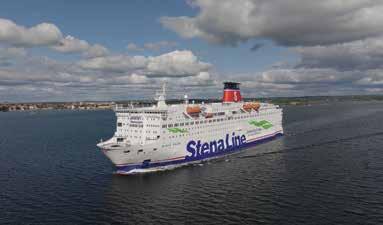
The 1987 Polish built vessel will transfer from the Baltic to take station at Rosslare on June 1st replacing the chartered-in freight ferry Seatruck Panorama which will be returned to her owners. The vessel change, along with the retention of the Stena Horizon, will facilitate six round trips a week passenger service on the Cherbourg route. The Stena Vision has a freight capacity of 2214 lane metres, 400 more than the vessel she replaces, a passenger capacity of 1300 and could accommodate 550 cars.
Brittany Ferries will exchange the Salamanca for sister ship, Galicia in April. It will become its permanent ship on the twice weekly Rosslare/Bilbao route and once weekly Rosslare/Cherbourg service. The company is now accepting foot and bike passengers on these routes.
Brittany Ferries will continue to operate the once weekly Rosslare/ Le Havre route throughout 2023 and will accept a limited number of passengers from March 2023 onwards.
At the time of writing there is still some doubt about the deployment of vessels on the DFDS Dunkirk/Rosslare service for the summer season. Currently the company is carrying a limited number of passengers with cars aboard its five rotations a week service.
Irish Ferries plan to operate its Dublin/Cherbourg route on a similar schedule to that used in 2022, using the WB Yeats on seven round trips a fortnight schedule.
In April Tourism Ireland will launch a significant advertising and other media promotion in the French market, highlighting the ease of access to Ireland on the routes from Dunkirk, Cherbourg,
Le Havre and Roscoff this year for passengers with their cars and motor homes.
Both Stena Line and Irish Ferries have indicated that they expect to operate similar schedules to 2022 for their Ireland/Wales routes.


P&O Ferries has reduced its fleet on the Dublin/Liverpool route to two vessels, the sister ships Norbank and Norbay, giving a steady schedule of a morning and evening sailing in each direction. The chartered Seatruck Pennant has been returned to her owners. On the North Sea, P&O has also reduced its active fleet by returning the long-term chartered freight ferry Bore Song to her owners.
In a press statement, the company claims to have reduced itscarbon footprint by 85,000 tonnes during 2022. This is a 9% reduction on the 2021 figure. Commenting, Peter Hebblethwaite, Chief Executive of P&O Ferries, said:

“I am delighted that we have made outstanding progress in reducing our carbon footprint in 2022 and can
promise that we shall do everything we can to eliminate another 40,000 tonnes from our operation in the next three years. The lion’s share of the reduction is attributable to our innovative space charter agreement signed with our competitor DFDS 18 months ago, whereby we make freight space on our Dover-Calais ships available to one another to maintain customer service levels on the route and ensure its continued resilience. We are determined to make P&O Ferries the best ferry company in Europe. That means: the best ships, the best routes and the best value for tourist and freight customers. I can assure everyone that a vital part of our plan for the future is reducing carbon emissions in cargo and logistics supply chains.”
The space charter agreement means that P&O will sail 9,000 times on the English Channel in 2023, down from 16,000 times in 2019.
Other efficiency measures which reduced carbon emissions in 2022 included the fitting of new propellers on an Irish Sea ship, which saved 7 percent of carbon emissions, and changes to the Larne-Cairnryan timetable, which led to 370 fewer sailings in the year and a 3.6 per cent carbon reduction. Future sustainability initiatives include a hull
painting programme and replacing propellers on other ships. Another factor reducing the CO2 emissions from the P&O Fleet was the disruption to the company’s services following the March 17th decision to replace the crewing arrangements aboard several vessels in the fleet with a lower cost model. This led to vessels being out of service for an extended period.
In late Spring P&O expects to take delivery of the first of a pair of dou-

On January 16th Haropa Ports conducted a press briefing on progress to date and future plans for the eighteen-month-old port complex that combines the Ports of Le Havre, Rouen and Paris. The three Haropa Ports share location along the river Seine, with Le Havre being a significant deep-sea multimodal and container port, Rouen being a specialist in bulk cargoes, particularly grain, while Paris Port operates a network of terminals and distribution centres with 70 quay sites stretching from Le Havre to Central Paris.
The major investment focus over the
coming years will be on multimodal, low carbon distribution. At Le Havre, Deep-Sea carrier, MSC is, along with the port, investing €700 million in developing a terminal with integrated rail and inland barge links using the river Seine and network of canals. During 2022 traffic on the river was not affected by the summer drought conditions that had significantly affected operations on the Rhine, Danube and elsewhere, due to the network of reservoirs close to the Paris region. Hapag Lloyd and Marfret launched new services on the river, feeding containers through to Paris region distribution centres.
During 2022 IKEA launched a distribution service in the Paris area, taking goods from riverside distribution centres by barge into Central Paris and doing the last mile delivery by electric vehicle or cargo-bike.
While carryings on the Le Havre/

ble-ended ferries for the Dover/Calais route. The hybrid diesel/battery powered, P&O Pioneer and P&O Liberte, though significantly larger than the vessels they replace, will consume 40% less fuel. The double-ended design will enable a much faster port turnaround to be achieved than is the case with conventionally designed vessels. Each vessel will have capacity for 1500 passengers and garage space of 3658 lane metres.
Portsmouth ferry route remain low, the introduction by Brittany Ferries of its weekly Rosslare service is proving to be very successful. Haropa will also facilitate the establishment of a floating LPG terminal at Le Havre in 2023. While the trade car activity was 11% less than the 2021 figure, with a total of 260,000 vehicles handled, the reduction was mainly due to production difficulties at the manufacturers’ plants. The latter months of the year saw a significant increase in this activity as production ramped up and as Zeebrugge began to experience congestion.
Haropa Ports show a good outcome from 2022 and ambitious plans for future development
The switch of terminal locations within Dublin Port between Seatruck and P&O Ferries has now enabled the new owners of Seatruck, CLdN to commence to integrate the two operations. The Seatruck vessels, sailing between Dublin and Liverpool and Dublin and Heysham, now operate within the same control area in the port as do the CLdN, services linking Dublin with Zeebrugge, Rotterdam and Santander.
This has allowed CLdN to change its Santander service from a once weekly,
Ramsey, Isle of Man based, WS Mezeron Shipping has re-opened its general cargo shipping service linking its home port with Belfast. The 500 grt. Silver River will sail weekly, carrying a wide mix of cargoes including building materials to the island.
The Silver River also operates a regular service to Glasson Dock, close to Lancaster and is the smallest and oldest vessel operating regular services on the Irish Sea.
The Mezeron service is the only year-round direct service from the island of Ireland to and from the Isle of Man. The Isle of Man Steam Packet Company operates a high-speed craft with passenger services to Dublin and Belfast during the summer months, while the main route for freight traffic operates from Heysham Port, linking with Seatruck services from Dublin and Warrenpoint.
The French Neoline Armateur company has commissioned the building of the first Neoliner Ro-Ro vessel which is expected to enter service in 2024. The 136-metre cargo ship will be powered mainly by sails mounted on two 75 metre masts giving a fuel saving of 80% compared to a conventional vessel of similar capacity. The ship will have a service speed of 11 knots and will operate on a loop linking St. Nazaire, Halifax in Nova Scotia, and Baltimore in the USA. The company, which is now

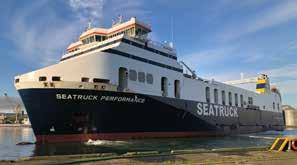
triangular Santander/Liverpool/Dublin/ Santander operation, to a twice weekly, Santander/Dublin sailing. Trailers and containers destined for Liverpool are now being off-loaded in Dublin and transhipped onto a Seatruck vessel. Traffic from North-West England is now being shipped to Dublin, connecting with the Santander vessel.
Seatruck has deployed the recently returned from charter vessel, Seatruck Pennant, onto its Dublin/Liverpool service, allowing it to increase the schedule to four sailings a day from each port. This extra capacity should enable Seatruck to accommodate the Santander/Liverpool traffic along with traffic growth following the reduction of competitor P&O’s service.
In two unrelated events, CLdN is currently in the process of installing rotor-sails aboard the jumbo ferry Delphine. These are expected to significantly reduce fuel consumption and if successful will lead to a similar adoption

aboard other vessels. The company continues to build its fleet size, not only with the building of new vessels but through the purchase of second hand tonnage.
backed by, amongst others, CMA-CGM and Corsica Ferries, has already secured freight commitments from the Renault Group, Michelin, Hennessy, and several other environmentally aware manufacturers.
In reporting its December 2022 carryings on its ferry operations, DFDS reported continued challenges on its English Channel and Baltic Sea services. Overall freight volumes were down 15.2% compared to December 2021, but when the English Channel figures were taken out the decline was 4.7%. The reduction in Baltic Sea volumes is a consequence of trade disruption caused by the Russian invasion of Ukraine.
In a statement issued with the figures, DFDS said that the freight volumes drop on the English Channel were due to continued weakness in trade following Brexit, as well as increased competition on the Dover routes, following the introduction by Irish Ferries of their three vessel service on the Dover/Calais route.
The Uk Department for Transport has awarded a 12 month contract to the disaster response charity, RE:ACT, to provide food and water to HGV drivers trapped in queues in Kent while attempting to reach Dover or Folkestone
to cross the Channel. The £200,000 contract covers all of Kent’s roads, but the County Council said that: “the focus, perforce, in recent years has been on the regular disruptions to the road networks leading to the Channel tunnel and the port of Dover”. Delays of longer than one or two days will trigger a response from RE:ACT.
The Port of Dunkirk mounted a trade mission led by Deputy CEO, Daniel Desehodt, to Dublin and Rosslare in December. The visit was prompted by the success of the Irish connections recently established by DFDs and Containerships, and focused strongly on the opportunities for the establishment of Distribution Centres for traffic moving to and from Ireland.
Desehodt also took the opportunity to talk about the plans that are in place to massively increase the size of Dunkirk Port through dredging of a large cargo basin, and the addition of on quay rail connections to the European network.
Study by Simon Kucher & Partners revealed that 71% of customers around the world are making changes to live more sustainably. Two thirds of customers rank sustainability as one of the top five drivers behind a purchase decision, up from 50% in 2021. A further report predicts a growth in freight transport activity of over 40% by 2050, setting real challenges on the CO2 emissions front for an activity that currently accounts for 8% of such pollution.
Those survey figures show just how quickly attitudes can change and how the ‘impossible’ can become straightforward in a very short time. It seems to be only a couple of years ago that battery powered heavy duty trucks were never going to happen, but then you read that a few months back DFDS took delivery of the first batch of a 125-truck fleet of Volvo eFH Electric trucks to operate out its Benelux port bases. Within a couple of years DFDS expects to have 25% of its truck fleet battery powered.

Another indication of rapid de-carbonisation comes in the end of year figures issued by the Port of Antwerp-
Bruges where the star performer has been the movement of unaccompanied trailers. The figures, which exclude containers carried on trailers, show a year-on-year growth of 10%, with the Irish element of this growth increasing by 35%. This traffic is being carried by CLdN, Finnlines and Grimaldi, while DFDS, which operates from the nearby Port of Dunkirk, also reports strong growth. Taken together with the strong development of the Ireland/Continental Europe Ports container business, we can see traders switching strongly to low carbon supply chains.
The announcement by Iarnród Éireann in early January of the €65 million contract with John Sisk & Son to prepare the Foynes/Limerick track-bed for the reinstatement of the permanent railway following the recent delivery to Foynes Port of the necessary rail line, is surely an indication that the ambition to shift freight traffic from road to the more environmentally friendly rail mode, is becoming a reality. The work on the ground also gives credibility to the plans set out in the Government’s Rail Freight Strategy document. The completion of the Cork Port Container Terminal at Ringaskiddy must now enable the port to seek out further direct deep-sea shipping services which would enable Irish exporters and importers to avoid the use of routes with trans-shipments at Continental ports and the associated environmental costs involved.
The first fruits of Dublin Port Masterplan initially launched some ten years ago are now becoming evident, not only with the shifting of empty container storage and other lower priority facilities off the Port Estate, but also with the
development of new quay facilities enabling the rationalisation of services to be transferred to other locations, thereby enabling smoother and quicker movement of goods through the port. 2023 will also see significant technical development in the maritime sector. Some of this, such as the re-fitting of some P&O Ferries with high efficiency propellors, or the bottom re-painting of several vessels with low-drag paints, may not be immediately apparent, but port watchers will notice the masts fitted to a few Ro-Ro vessels operating in European waters incorporating wind powered generators. Any of these developments can reduce the vessel’s operating carbon footprint by 10% or more.
The promoters of the Codling Wind Park have now announced an agreement with Eirgrid to take the power generated by the one hundred turbines located off the County Wicklow Coast through the Poolbeg facilities in Dublin. Receipt of a Maritime Area Consent will enable them to participate in the first Offshore Renewable Electricity Scheme auction in the coming months. The wind farm will be serviced from a new facility to be developed in Wicklow Harbour.
Over the coming twelve months several similar projects will be progressed off the East and South coasts, all with significant servicing requirements. The recently implemented fishermen and fleet retirement programme may, it turns out, be timely in enabling many fishermen to deploy their skills in this area.
All of these developments should combine to move the Sustainable Ireland project up several gears.
with Volvo FH featuring I-Save
Cut fuel costs, without compromising on productivity and performance. The Volvo FH with I-Save is the ultimate long haul truck, delivering cutting-edge fuel-saving features like I-See predictive cruise control, improved Economy Mode, extra torque at low revs, and more.
Contact your local Volvo Trucks dealer about the full Volvo Long Haul range
Volvo Trucks. Driving Progress.
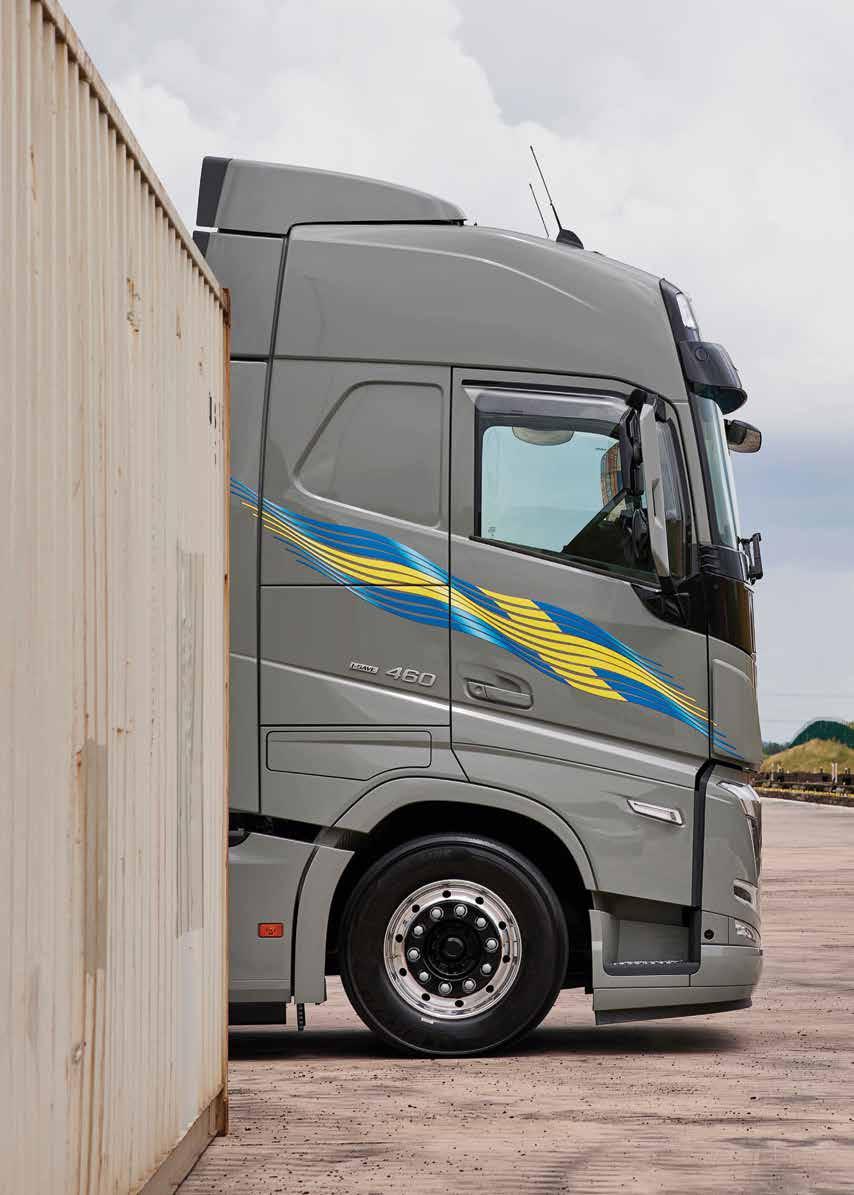
Data released by the court services shows a sharp decline in the number of claims and the amounts paid out by insurers. The next logical step, therefore, should be to see premiums being reduced.
Well, there has been some evidence of minor decreases, but little sign of the significant reductions promised. Alliance for Insurance Reform (AIL) has stated that the Government must now put pressure on insurers to pass on the significant savings being made. In the past insurers have been slow to pass on these savings. In reality, the problem is that competition has been stifled, and for whatever reason the market exists between a very limited few.
My own private insurance came up for renewal at the start of the year which saw a slight increase in the premium, albeit nothing that would break the bank. On enquiring with the broker if any other company showed any interest in the business, she said ‘not really’. I then sheepishly asked about the likelihood of the recently reported savings filtering through, to which she replied that it could take a few years for it to get through to premiums. Not very
encouraging.
Of course, the insurers keep telling clients to go on-line for better deals. I am always nervous of making such a transaction on-line, because of the potential problems it could cause down the line. Let me explain why.
If I buy a concert ticket or an airline ticket on-line, the worst that can happen is that I will forfeit the ticket and possibly miss the event or flight. In the case of insurance, you leave yourself open to the possibility of an inadvertent non-disclosure, possibly finding yourself without cover or facing a massively hiked premium. Unfortunately, I know too well the problems that can arise here from personal experience. Using a broker or adviser to conduct the business on your behalf is the best way.
But back to the insurers, in the past there was an element of insurance costs going through cycles. Premiums fluctuated up and down, while competition was prominent in the market place. One time in the early 1990s we had two brokers, representing five insurers competing for our business. Of course, our premiums were reduced significantly, in spite of some outstanding claims.
My memory of this time is that there was a period of about five years where there was intense competition. What happened? Premiums started to increase after 9/11. Some road transport
companies reported that their annual renewals doubled in price. In fact, it put a number of operators out of business. I remember a particular Council meeting of the Irish Road Haulage Association (IRHA) that was addressed by Niall Hickey. His business, CON Transport had closed the previous week. A well run and professional operator, the firm’s insurance premium had doubled with little or no explanation or apparent negative risk rating offered. At the time some insurers were saying, off the record, that the price war had brought them to their knees, and they would never let it happen again. A clue perhaps, that the competition has gone off into the sunset.
So, what does the future hold? There are some positive signs on the horizon. In recent times some court judges have dismissed cases that they felt were spurious and fraudulent. Following the introduction of new guidelines for insurance claims, the amount paid out has almost halved. In addition, the number of cases going to the High Court have reduced by 12%. It is also being reported, anecdotally, that there is a reluctance on the part of some solicitors to take personal injury claims.
So, while it may be another year or two before motorists have their pay day, the fight to make insurers user friendly and customer focused is not over yet.
Text: Seán Murtagh - sean@fleet.ie
Insurance offers no real assurance on premium reductions
The new Actros L
For anyone who wants more than just a truck. More innovation. More efficiency. Benefit from up to 4%* less consumption thanks to third-generation OM 471 engine technology, plus access to our full range of services. Information on the new Actros L available at mercedes-benz-trucks.com #GetMore
*Compared to the previous engine, the second-generation OM 471.

As we continue into 2023, for those in business there is a need to set out the financial goals for the new year. Many will say because of economic uncertainty, the War in Ukraine, plus the fact that Covid is still present, that planning is not a feasible or productive exercise at present. But in truth, the most successful transport firms in Ireland and internationally operate to detailed financial plans, and alter and adjust these figures as circumstances change. Here are a number of simple goals that can leave businesses financially better off in 2023.
Profit Margin: Most businesses will obviously seek to maximise their profit margins but doing so requires detailed reviews of key factors including: a) The businesses’s customer base and knowledge of the sector it is operating in; b) Undertaking rate reviews on a continuous basis, supported by strong negotiation techniques that allow the business to retain or increase margin in a rising cost environment; c) Undertaking cost reviews on a continuous basis and

benchmarking the business against the best in the sector; d) Reviewing productivity of management, administration staff, drivers and workshop. Is the business still hungry for margin or has complacency crept in at some or all levels?
cash Management: We all know that cash is king, especially if there is any downturn in the economy. While there may be a strong relationship with the bank, with Invoice Discounting and an overdraft facility, there is nothing like a reserve of own funds to mitigate against the potential bad debt of a large customer, or having the ready cash to pounce on a purchasing opportunity. Having a cash reserve is also a benefit in these times of higher asset finance rates - with manufacturer rates currently topping 7%, own funds finance becomes all the more attractive.
Debt Ratio: The reduction of the debt ratio of the business through prudent purchasing decisions and use of own funds leaves the business less exposed to any unprecedented events with the customer base. If a business is not willing to borrow for a good margin strategic investment, it leaves the door open to opportunities.
Strategic investment opportunity: This could be the opportunity to purchase a premises, invest in driver accommodation, construct additional yard space or develop that office block, but prudent planning is needed and strong finances need to be available to
do so without incurring undue business risk.
In 2023 just make sure that the company is on top of all Revenue taxes and clear any warehoused debt. It’s one liability no bank or customer wants to see. Revenue is a creditor which can close the business if it is not tax compliant. Just keep up to date and do not rely solely on external experts.
If, in 2023, the aim is to retrieve all personal guarantees to create a strong financial plan, the company needs to be strong financially to do this so that banks are prepared to rely on the business Balance Sheet.
To add margin and status to the business why not seek business accreditations such as ISO or industry lead accreditations. It gives pride to all members of the business, shows customers the standards the company is operating under, and sets the business apart from the pack when tendering for new contracts.
Finally, during 2023 look to develop the business so that its ultimate value is increased. Examples of this include getting contracts with blue-chip customers, ensuring good management and control systems are in place, and having added logistics capabilities like warehousing or storage/packing/ distribution, freight forwarding or freight management for clients. Develop the business so that it has strong margin in a niche that it is dominant or secure in, and the overall value of the business increases dramatically.
Text: Donal Dempsey - donal@fleet.ie
When their future depends on our actions today, now is the time to make the difference. Choose the all-electric Renault Trucks E-Tech range with zero tailpipe emissions to help everyone enjoy cleaner air today and tomorrow. For more information visit our website.
#SwitchToElectric
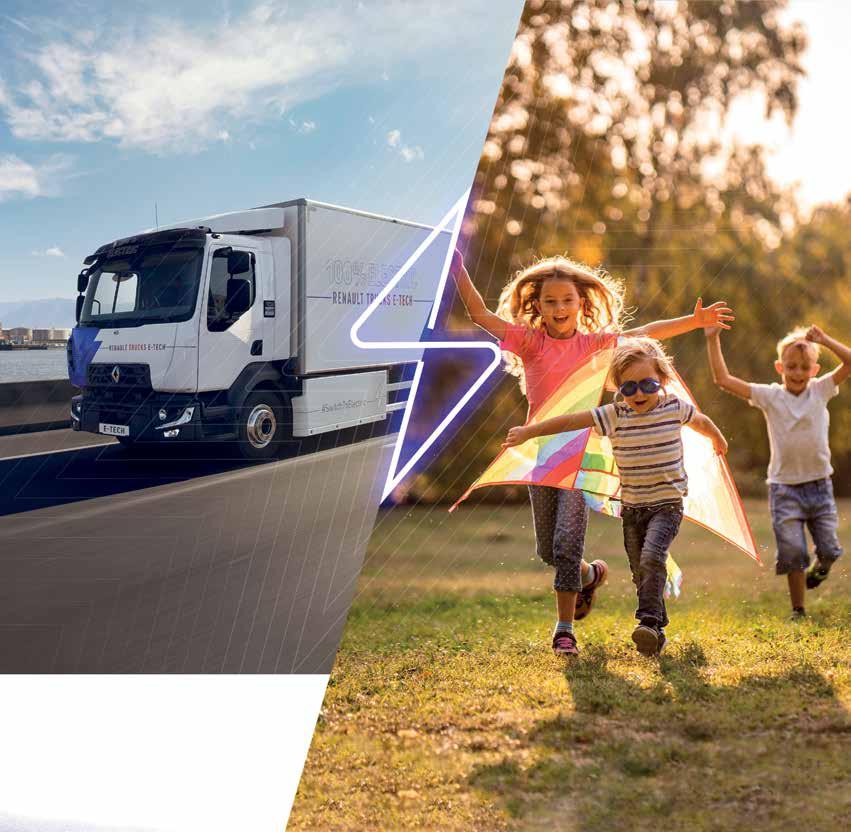
It would appear that the Irish trailer market in 2022 held up well with stronger than expected registration numbers. However, several external factors can quickly influence the marketplace with many of these factors outside the control of the trailer producers. As an example, ‘Fleet’ reported late last year that several manufacturers were experiencing some difficulties sourcing raw materials and warning that the cost of both materials and energy would increase production costs significantly, resulting in higher prices. Yet, at the same time, the same manufacturers were reporting strong demand for trailers from companies operating across many different industries.
One of the best-known names in trailer making is Krone, which recorded a successful trading year in keeping with others in the industry. It stated: “Despite a market that remains tense, the Krone Group generated sales of €2.5 Billion in the financial year 21/22” - up 15% year on year”. With all things considered these are very positive results coming on the back of the disturbances caused by the pandemic, especially when the core global workforce at Krone Group increased by 6.1% to 5,768 employees. Commenting on the future, Bernard Krone, Chairman of the Supervisory Board of Krone Group highlighted the “increasingly fragile supply chain in a globalised economic world and the rapid pace of technological development.”
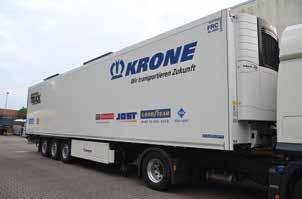
The pace of technological development is an area where Krone and other volume producers are keenly focused and invest significant sums. Areas receiving particular attention are
decision to withdraw from the Russian market, which accounted for over 20% of its sales. All other Schmitz markets performed strongly, and this was especially true in Ireland, where, according to Cargobull’s Paul O’ Ceallaigh, the best is yet to come.
Paul expects some significant new product launches for different sectors through 2023, including the arrival of the Schmitz Cargobull ‘Freepost’ trailer. In addition, Schmitz has invested heavily to further develop its range of telematic offerings to customers. What makes the Schmitz offering particularly attractive is the ease of use and compatibility with other software systems. The Schmitz telematics system has recently been the deciding factor in securing a number of significant orders from Irish operators who specialise in pharmaceutical
the application of autonomous machinery for the agri-sector, and the increased integration of digital services, telematics and the electrification of temperature-controlled trailers.
Developing for the future, or in some cases creating it, is one way to ensure a company’s longevity, and creating the future is where Schmitz Cargobull AG increasingly sees its role. As previously reported the company did post a loss in its last financial year, but this was simply attributed to several factors ranging from Covid, supply chain issues and in particular the
transport, and interestingly these trailers will be equipped with Schmitz Cargobull’s own temperature control unit.

Since last year product lead-in times have greatly reduced as the supply chain difficulties have stabilised, and the production plants are now back to full-time working. Importantly, once an order for a trailer is placed, Schmitz will maintain that price through the building and delivery time period, although the customer can opt out if there are any unforeseen changes in the agreed pricing before delivery. Certainly with current sales volumes, which are expected to increase as the new models are launched, all appears to be well at Schmitz Cargobull.
The trailer marketplace differs greatly for many manufacturers with some specialising in servicing one industry or sector. The ‘Walking Floor’ trailer has seen a dramatic increase in popularity in recent times. While primarily designed to service the agri-sector, the flexibility offered by Walking Floors has widened its appeal with operators as it can be used to transport many different types of cargo. The Dutch-produced Kraker brand is one we are familiar with and a tour of its production facility would impress anyone with an interest in trailer design and methods of production and assembly.
The Kraker brand is a quality product and one gaining in popularity. Kraker is supported in Ireland by Setanta Vehicle Sales, based in Ballycoolin, Dublin. In addition to the truck
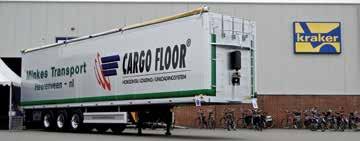
division, Setanta is fast becoming a ‘one-stop-shop’ for trailers with several off-the-shelf variants from a diverse range of high-profile brand names such as the German Meiller Kipper range of tippers, and French fridge trailer and bodybuilder Frappa. Furthermore, Setanta is also the main dealers for Dutch manufacturer D-Tec.
While the D-Tec name may not be that well known in Ireland, the company is well regarded throughout the Benelux and beyond for its series of container carriers, tippers and liquid tank trailers. Many of these are available with unusual bespoke multi-axle combinations to suit individual customer demands, especially in the vacuum tank sector. Setanta’s Alfie Barker believes that the D-Tec range of vacuum tanks will set a new benchmark for the future in this sector, and this is not just an opinion as it’s based on feedback from customers’ experiences.
Another company that specialises in meeting the specific requirements of its customers is Ashbourne Truck Centre with a good selection of Faymonville, Max Trailers, and Schmitz



member of the Faymonville Group. As an example, Cometto was recently charged with delivering a bridge for the Luxembourg rail company - a bridge that was 200 metres long, 18.5 metres wide and 40 metres high! The ‘Self Propelled Modular Transport’ units can cater for loads up to 15,000 tonnes.
Cargobull tipping trailers. The company has recently added the well-regarded Felbinder range of silo and liquid tank trailers to its offering. All brands are recognised as premium products both in design and build quality.


In the world of machinery moving, every job is a unique consignment, and selecting a trailer that will be all things to all loads requires a knowledge and understanding of the industry born from experience. This is what the Faymonville and Max
A brand that has been a regular sight on the road for well over 45 years now is Montracon. Producing trailers since 1977, and part of Ballyvesey Holdings, Montracon has expanded its production facilities in line with its customer base. Montracon’s clients work in as wide and as diverse areas of operation as the range of trailers produced. Interestingly, the company claims to produce the widest range of trailers of any European manufacturer.
In recent years, Montracon realised a gap in the trailer business, that is, in the area of refurbishment. It is accepted that a Montracon trailer is well-built and once looked after will last. However, all trailers will benefit from some additional care with a full refurbishment. This is especially true of trailers that work remotely and get dropped at ports and customers’ premises. Montracon can take the trailer and bring it back to showroom condition, thereby giving the trailer a new lease of life. Getting a second life out of a trailer could bring immense benefits to a company. Importantly, Montracon can refurbish any make of trailer and does not solely restrict its service to the in-house brand.
Trailer marques deliver. The efficient flexibility of the trailers is the secret to the brands’ successes, and this can be seen with the increasing numbers of both on the roads. And an operator needing to move the largest of large loads can choose the specialist in self-propelled vehicles, Cometto, which is also a

Although the name Tiger Trailers is relatively new, the foundations of the company go back quite a bit further. From its modern purpose-built production facility in Cheshire, Tiger has earned a reputation for its forward-thinking and innovative approach to trailer making and bodybuilding. This reputation is attracting new customers to the brand, and many of these customers are from Ireland.
In addition to Ireland, Tiger Trailers has increasingly exported its products to Europe. often fitted with specialist bespoke equipment specifically designed for each end user’s operating environment. In 2023, Tiger will take a further significant step through manufacturing bespoke trailers for other continents, offering significantly increased load capacity, environmental benefits, and cost savings to operators. Tiger has also strength-
ened its partnership with Spanish OEM Lecitrailer to continue meeting the need from the industry for an expedient supply of trailers and other products, offering reduced lead times of as little as twelve weeks for standard builds.



original and aftermarket parts for a vast range of vehicles and trailers - and not just SDC models.
Another company with decades of trailer-making know-how is Gray & Adams. The company was founded in 1957 and has always been popular with Irish operators. In keeping with others in the industry Gray & Adams has developed and expanded its product offering to now include all manner of bodywork to cater to all operators from straight single-compartment reefer trailers to multi-compartment and double deck trailers and bodies, down to small van bodies and units for the home delivery market. Arguably the possible range of models available today could not have been envisaged back in 1957. Yet Gray & Adams have continued to grasp the opportunities and move with the times.
Tiger’s load restraint systems have been tailored from the outset and in the coming weeks the manufacturer is set to launch its new-generation system. Towards the end of 2023 with its multimodal customers in mind, Tiger will also be expanding its swap-body range with the introduction of curtainsiders and with updated chassis, enabling its end users to reduce CO2 and maximise both capacity and usability.
While some manufacturers develop and build a wide variety of trailers, others prefer to remain within a particular area of production. BMI Trailers could be described as one of those, as the company has built a reputation for quality ejector, walking floor, and waste trailers. This type of specialist knowledge and skills can be invaluable when designing and constructing a customer’s unique trailer. Arguably it is even more important when the trailer will operate within the waste industry, where conditions can on occasion be described as hostile. BMI’s reputation has grown, and in line with its reputation so have its export markets.
Gray & Adams is not the only company with a long history of serving Irish operators. A name that one time had a spell in truck assembly is now synonymous with the world of trailer production, namely Dennison Trailers. For over 50 years the company has earned a reputation for manufacturing trailers that were tailored perfectly to Irish roads and served Irish operators exceptionally well. Its reputation enables the company to claim an 80% share of the container chassis market to the UK. Nevertheless, the family firm has also earned a deserving reputation for other trailer models such as tippers, flats, trombone trailers, and machine carriers. Now in addition to serving the Irish and UK markets, it is not unusual to ‘Spot a Dennison’ travelling some of the far-flung roads across Europe and Scandinavia - and for good reason.
Figures from last year show what could be considered a surprising number of registrations going beyond 3,000 units. Allowing for the possibility that during the pandemic the uncertainty that abounded business circles meant few companies were willing to invest, this may have led to a build-up of demand for 2022. Nevertheless, even when the small volume
Export markets are vital for a trailer manufacturer to grow and expand. This is a relatively small island with a relatively small population, so the market is limited. Nevertheless, by developing a good reputation earned from building good trailers, a small company can, over time, grow into a market leader. Such has been the case with SDC Trailers. What began as a very small company is now a major player, and while SDC is now part of a global organisation, it continues to remain true to its historic methods of operation concerning build quality innovation and customer service. SDC has further expanded into the area of parts supply, creating a new business profile for the company, one that has gained a respected reputation for the supply of
and one-off special-purpose trailers are excluded the market is appearing to be resilient and would be a good indication of a positive outlook for 2023.
Text: Paul White - paul@fleet.ie





30 Years

























The International Van of the Year Jury is a non-profit-network of independent Editors and Journalists from leading publications and web platforms, representing 25 countries across Europe and Russia. Each year they honour the best new Light Commercial Vehicle with the unique and prestigious title of International Van of the Year (IVOTY). That means: 30 years of testing, measuring
and objective criticism. Offering expertise to improve the product and the sector in general. Always looking for the challenge, always looking for the best choice in Light Commercial Vehicles. For you, for your daily work, for your company’s success! International Van of the Year: Electrifying boost for your Business! See more: van-of-the-year.com







Fleet Van & Utility Magazine,

D’Alton Street, Claremorris, County Mayo, Ireland.
Tel: +353 (0)94 9372819
Fax: +353 (0)94 9373571
Email: enquiries@fleet.ie
Subscription Hotline: 094 93 72827
Printed in Ireland
Disclaimer: Fleet Van&Utility Magazine management can accept no responsibility for the accuracy of contributed articles or statements appearing in this magazine and any views or opinions expressed are not necessarily those of Fleet Transport management, save where otherwise indicated. No responsibility for loss or distress occasioned to any person acting or refraining from acting as a result of the
Editor: Jarlath Sweeney
contributors: Rob Van Dieten, Cathal Doyle
Photography: Jarlath Sweeney, Rob Van Dieten, Cathal Doyle
Administration: Orla Sweeney
Advertising: Mary Morrissey, Design: Crackerjack Design House
material in this publication can be accepted by the authors, contributors, Editors or publishers. The Editor reserves the right to make publishing decisions on any advertisements or editorial article submitted to the magazine and to refuse publication or to edit any editorial material as seems appropriate to him. Professional legal advice should always be sought in relation to any specific matter.
Mercedes-Benz Commercial Vehicles
Ireland is preparing to add to its van line-up with the launch here of the second generation Citan. The 2022 International Van of the Year Award joint-winner (with the new Renault Kangoo, with which it shares development and technology), boasts a sharp new design and a stylish interior. It is now available to order by customers, with first deliveries expected in May. An electric variant will follow.
Mercedes-Benz vehicles are renowned for their exacting safety credentials and premium specifications. The Citan is no exception, with standard specifications including Active Brake Assist with pedestrian recognition
technology, Attention Assist, which detects drowsiness in the driver and encourages them to take breaks when tired, and Hill-Start Assist to prevent rolling back. There’s also a speed limiter, an emergency breakdown assistance call button, rear parking aid with a reversing camera and no fewer than six airbags. Blind Spot Assist, Active Lane Keeping Assist and Speed Limit Assist can all be specified as options.
As with all Mercedes-Benz vans, the new Citans come with a two-year warranty and round-the-clock roadside assistance.
Multimedia functions, including a seven-inch touch screen and a multimedia system with ‘Hey Mercedes’ voice assistant and smartphone
A pool of high-powered chargers every 60 km on our motorway network, part of the Government’s New Electric Vehicles Charging Infrastructure
Strategy 2022 – 2025, will see €100 million spent on public charging infrastructure over the next three years.
According to the statement, the 3-year strategy presents an ambitious pathway and practical steps for delivery of a national EV charging network which will also see home/apartment charging, residential neighbourhood charging (including new mobility hubs), destination charging and en-route
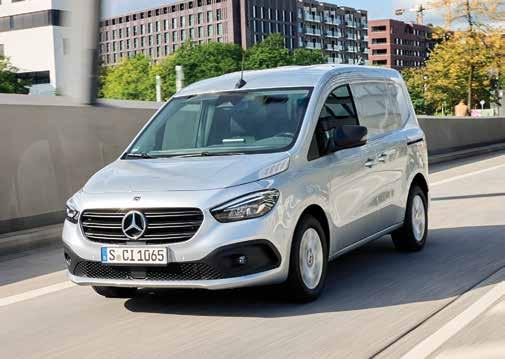
charging.
At the launch, Minister for Transport Eamon Ryan said that while this was a national plan, its success also hinges on the enhanced supports and collaboration planned with Local Authorities: “In all of this, our Local Authorities will play a vital role. The key anchor for this Strategy is the specialist ZEVI unit. Within this unit, we have the expertise, the knowledge, the guidance, the resources that Local Authorities will need to be able to make the best decisions on the procurement, leasing and location of EV chargers. One of the initiatives I really
integration via Android Auto or Apple Carplay, are standard features on all Citan trim lines.
The Citan panel vans are available to order in two sizes, L1 & L2, and will be powered by a 1.5-litre Euro 6 diesel engine generating 110/112hp, delivering WLTP combined fuel economy of 4.33 L/100km (54.3 mpg), which is helped by the ECO start/stop function. Drive is to the front wheels via a six-speed manual or optional seven-speed automatic transmission.
For example, the Citan in L1 format, has a load length of 1,806 mm and a payload capability of 667kg. It is rated to tow trailers up to a maximum gross train weight of 3,500 kg.
want Local Authorities to embrace are the mobility hubs where people can charge their own vehicles, charge their e-bikes or e-scooters, or use a shared EV, for example.”
Currently, the majority of EV charging (c.80%) is done at home, and access to and installation of home charging infrastructure is relatively well established. The focus of this Strategy is the provision of publicly funded charging infrastructure for electric cars and light-duty commercial vehicles, the demand for which will grow as EV uptake increases.
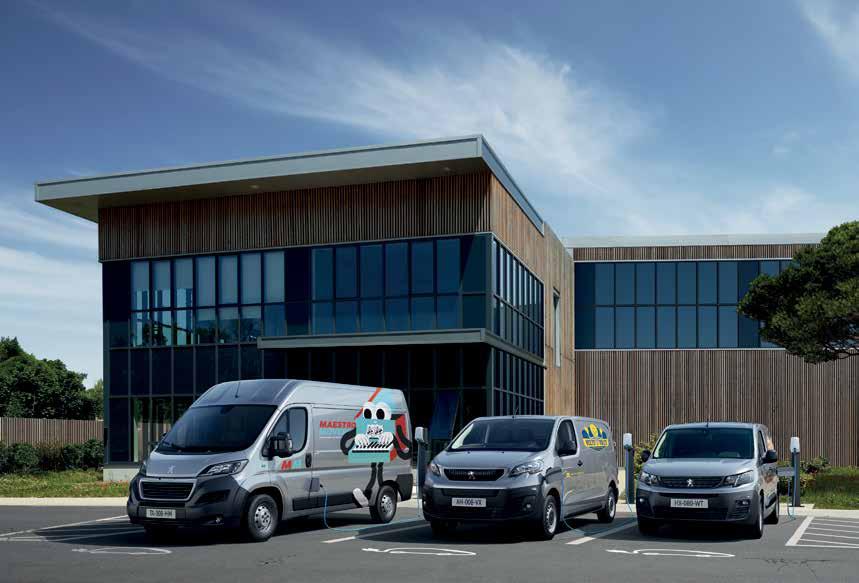




































A review of Irish Light Commercial Vehicle registrations in 2022 and those in the UK reveal that both marketplaces suffered a decrease in new sales and deliveries. In the case of Ireland, the 17.71% decline, according to the Society of the Irish Motor Industry (SIMI) is put into perspective by figures from 2021, which recorded an upturn that year (see chart). On the other hand, on the other side of the Irish Sea the British market has been reducing annually since 2019 – down 20% year-on-year and 22.9% in 2021 (from 2019). Due to similar issues, the lower figures were not down purely to demand but to supply and delivery delays.

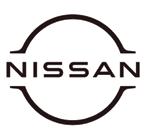

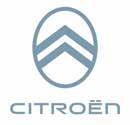
Ford led the way in the annual sales table in Ireland, recording 5,885 units (24.88% of the overall market). The Ford Transit Custom topped the sales charts with 2,274 units sold, while its bigger counterpart, the Ford Transit, was third on 1,483 units. In between was Toyota Ireland’s Land Cruiser Commercial, its 1,644 units sold helping the Japanese brand to third in the overall light commercial sales league. Completing the top ten were the Renault Master (1,209 registrations), Volkswagen Caddy (1,094), Renault Trafic (1,023), Peugeot Partner (996), Ford Transit Connect (948), Citroen Berlingo (921) and Mercedes-Benz Sprinter (904).

Fleet Van & Utility asked representatives from the LCV brand importers and distributors for their overall view with regards the marketplace heading into 2023. From the various contributions, there seems to be light at the end of this business tunnel, despite recessionary talk and other ongoing matters.





Chief executive Mike Hawes of the UK’s Society of Motor Manufacturers and Traders said: “While demand for new vans remained robust throughout 2022, replicating last year’s high levels of fleet renewal was always going to be a challenge with relentless supply chain disruptions and wider economic malaise. A return to growth is expected in 2023, but if this crucial sector is to deliver for the economy, society and the environment, action is needed from all stakeholders, particularly in the areas of electric vehicle charging infrastructure and fiscal frameworks, enabling more van buyers to make the switch.”


John Manning, Market Lead, Henry Ford & Son Ltd., began his overall view of the LCV & pick-up marketplace during 2022 and into 2023, by saying:
“It was another tough year for the industry, still suffering the aftershocks from the Covid pandemic and difficulties with vehicle supply that affected all of the key players. This is reflected in the 17.7 per cent drop in new LCV sales during 2022 (versus 2021). It was heartening to see Ford retain its traditional
leadership of the LCV sector in Ireland during 2022. In a tough trading environment, our new vehicle sales tally dropped by 15.9 percent but we still managed to grow our market share from 24.3 per cent to 24.9 per cent in 2022. The Transit retained its crown as the most popular CV on the Irish market.
In the pick-up segment, with a total of 669 units sold, the Ford Ranger was again top of the class in spite of sales dropping by 50 per cent year-on-year which was as a direct result of the vehicle supply issues. The good news is that for 2023 we have new Ranger models arriving here, including an exciting new version of the Raptor and we are very confident that supply issues will not have as adverse an impact as witnessed during 2022.
Similar to the past couple of years, the used CV market is very buoyant at the moment. Of course, a key driver in this regard is the new vehicle supply issue that the industry is facing but equally, the boom in e-commerce is having an effect too. Many companies are having to not only renew their fleets but are also needing to increase the number of vehicles on the road thus increasing the demand for new or used vehicles.”
John is optimistic that improvements will be seen during 2023 in relation to the component supply issues and feels that the increase in the purchase cost of vehicles has not affected new sales.
With regards to the programme of electrifying its LCVs, John added that Ford’s EV transformation plans are continuing apace: “During 2022, the all new E-Transit arrived in Ireland and very quickly was pressed into service with customers across the country. Ireland’s largest parcel delivery company, DPD, is relying on a broad fleet of E-Transit models to help it meet its zero emissions targets. Ford Ireland has also secured orders for the vehicle from a range of private and public companies and organisations. Overall, Ford will introduce seven new electric vehicles in Europe by 2024 – three passenger vehicles and four commercial vehicles, uniquely designed to meet the mobility of a modern Europe.
Regarding pending arrival of new models, John mentioned that the all-new electric Transit Custom one-tonne van will arrive later this year, to be followed by the electric Tourneo Custom multi-purpose vehicle. 2024 will see the launch of the smaller next generation Transit Courier with an EV powertrain.
“In addition to the new models mentioned above, in 2023 we will be launching Ford Pro in Ireland,” explained John in conclusion. “It’s a global business and brand within Ford that is dedicated to delivering an always-on, one-stop shop for all commercial and government customers – powering their growth and productivity – today and tomorrow. Ford Pro is effectively a comprehensive suite of software, charging, financing, services and support on Ford and non-Ford products, helping to reduce fleet downtime and overall total cost of ownership. Ford Pro makes the complex transition to electric easy – providing ICE and electric vehicles seamlessly paired to intelligent Telematics tools, charge management software, hardware, services and customer support that enables mixed fleets to operate without disruption and help E-Transit and soon to be launched E-Transit Custom, reach maximum productivity and capability within electric fleet operations.”

Alan Bateson, Managing Director, Volkswagen Commercial Vehicles Ireland noted of the outgoing year: “The overall market was somewhat curtailed by component supplies that restricted production, the market should have reached circa 26,000 for a second year but was nearly 6,000 short of this or -23% year on year (excluding car derived vans). The used market is also curtailed by the decreased new total market, as a result, used supply is short as a knock on and process and residuals are strong.
Component supply issues are improving but logistics (road, rail, sea transport) are now adding to the lead time of production and supply of new vehicles. This will most likely continue through 2023 with no clear end in sight, albeit plans are developing to remedy issues where possible.”
Asked about the ongoing increase in CV purchase costs, Allan replied: “Inflation is across all business sectors and we have seen price increases linked to materials costs and production costs, however, with our own financial lender, Volkswagen Financial Services we have been able to manage the costs for customers through leading lending rates and methods along with TCO programmes which also manage service and repair, i.e. monthly lease with no deposit.”
VWCVI’s entry into the BEV landscape is progressing well, he added. “Launching the ID Buzz Cargo was our first big step and has proven to be a huge success. This success will be further developed with the launch of the Transporter 7 1-Tonne BEV in 2024 and the E-Crafter shortly thereafter. Our mission is clear with our ‘Way to Zero’ focus and this will see even more new models launched to support this in the years ahead. We also look forward to the all new Amarok in May.”
All good on the Killeen Road, Dublin, where Toyota Ireland is pleased with its overall LCV sales performance according to Cathal Ryan, Corporate Sales, Toyota & Lexus. “Toyota commercials performed exceptionally well in 2022 with registrations increasing by 34% year on year, with the Proace City and Proace models selling particularly well. Customer demand in 2023 continues to be strong for both diesel and electric models. While new model supply remains challenging for the coming year, Toyota expects to fulfil many orders within 16 weeks. As in 2022, used commercial vehicles (particularly Toyota commercials) continue retain strong trade-in values.”
In relation to the components shortage challenge, Toyota was well placed. “In 2022 Toyota had some of the shortest lead times in the market for commercial vehicles, and within reason this is expected to continue for 2023. Placing orders early remains key to a positive customer experience. As a result of global component parts scarcity, all manufacturers have been forced to increase vehicle retail prices. In the short term thankfully, in many cases, the increase has been offset by
increased trade-in values, meaning the cost to change remains good value. This can be a little more challenging where a customer doesn’t have a trade-in.”
“Consumer appetite for Toyota EV commercials (City & Proace) is particularly strong, and the user experience has been very positive. Toyota Ireland’s EV strategy very much focuses on matching the appropriate EV to the customer’s requirements. This has been a learning process for both Toyota and our customers and so far, it’s going really well,” concluded Cathal.

Citroën Ireland, which increased its share marginally (by 0.5% to 6.8%), aims to increase its presence in the LCV market with a broader offering of electric powered light commercials and car derived vans (CDV) this year. “We have recently brought C3 Aircross SUV Commercial to the range, adding to our very successful C5 Aircross and C4 CDV models. Our CDV selection now offers a comprehensive range of load dimensions and volume capacities to suit the needs of our customers,” explained Cathal Lanigan, Senior Marketing Executive, Citroën Ireland.

Fiat Professional, now distributed by Gowan Auto, is basically starting with a clean sheet of paper. A number of dealers have been signed up already as the resurgence of the Italian brand continues. Now under the Stellantis umbrella, Fiat Professional has refreshed its flagship Ducato and recently added a reshaped Scudo and Doblò, the latter two vans based on existing Peugeot/Citroen vehicles.
Commenting on the road ahead, Alexis Moore, Marketing Head of Fiat Professional for Gowan Auto said: “While supply remains a consistent issue we are confident here in Fiat Professional that we will see healthy stock levels to enable us to promote the brands in the Irish market.”
She noted that with Stellantis moving all of its LCVs to common shared platforms, this is also true of the BEV variants of the LCV’s. Doblò-e, Scudo-e and Ducato-e will all hit the Irish market this year.
oPEl

According to Fergal Marron, Head of Fleet at Opel Ireland, there remains a considerable excess of demand over supply through 2022 into 2023, noting that as the economy grows, businesses and tradespeople are looking to expand and replace their van fleets. “The disruption to parts
supply and repairers’ businesses means maintenance and repair of older vans is being delayed, putting more pressure on van rental companies for short- and medium-term rentals, increasing their demand for new vans. Lower availability of used vans from the UK has reduced that source of vans too, also increasing demand.”
“We see some small improvements in vehicle availability but predictability is still quite difficult, we are having to accept more what we can get built for us instead of being able to reliably place orders with certain time-lines. Opel’s van sale performance in 2022 was very strong, finishing with a market share of over 9%, and we hope to build on this in 2023. Obviously the future is electric, and van users and owners are becoming increasingly comfortable with the electric experience, while businesses are moving to EVs to achieve their sustainability goals.”
PEUGEoT

Peugeot Sales Director at Gowan Auto, Luke Messitt is confident of an increased market into 2023: “Demand remains high with many fleet companies planning to renew their fleets. The component shortage and the war in Ukraine had a huge effect on LCV production, mainly affecting our Partner van range. Despite these difficulties, the Peugeot Dealer Network have done a phenomenal job in keeping our customers informed and managing their expectations.”
Luke added that the retail price increases have not really affected sales to date due to demand continuing to outweigh supply. He made an interesting point in relation to the move towards electric: “Peugeot already has a full electric option for each model in its LCV range, with demand for the Partner and Expert models particularly strong. [Sales of] our EV commercial vehicles have been mainly driven by Semi-State, Local Government and other tender-based businesses.”

Fergus Conheady, Sales Manager at Mercedes-Benz Vans in Ireland was happy enough with sales during 2022, despite facing constant challenges: “We hit our factory targets, however, these were adjusted to take account of lack of availability of product. There is general lack of supply within the market which has ensured that all available product is being sold, however there are more negative comments coming back from the market than in recent times so we’re very conscious of keeping a finger on the pulse to see how the market responds throughout the year. Our challenge with BEVs last year was lack of product. We are hopeful of this freeing up and being able to deliver more electric vans during the year. We look forward to introducing the new Citan, scheduled for a Q1 launch.”
Text: Jarlath Sweeney - editor@fleet.ie










A 565 kilometre, 8-hour round trip from Mayo to Wexford provided plenty of distance and time to assess the latest Fiat Scudo in its new body guise. But the journey was more of a recollection rather than a reconnaissance, as the van the Scudo is based on is already quite familiar - being the mass production model from the PSA Group that has given us the Peugeot Expert and Citroën Dispatch.
First launched in 2016, these two similar versions were subsequently joined by a version supplied to Toyota - the Proace, while more recently new sister brands in the PSA family, Opel and Vauxhall adopted the platform for the
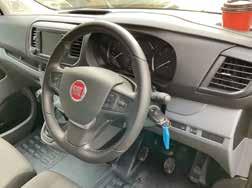

has been for owner drivers/ tradesmen to specify a higher trim level or specification to the base van, investing in additional equipment and technology to make journeys more pleasurable. It is often the case that the van is the second vehicle at home.

The Scudo tested here is the long-wheel base L3 versions with its 2.0-litre, 145hp Euro 6 diesel linked to a 6-speed manual gearbox and trimmed to the Technicolor Plus level.
Immediately notable upon sitting in is the leather steering wheel with its remote controls and the 7” audio/ navigation touch screen with Bluetooth connectivity alongside. The load area was also well finished, nicely coated with 9mm anti-slip wood floor fixed with aluminium rods and also coated 6mm wood flanks and neat wheel arch covering.
Regarding its exterior styling, the Centro Stile design house in Turin has turned out an eye pleasing and distinctive front end with the new Fiat logo dominating the grille. Other than the brand badging at the rear end, the body shell and underpinnings are the same as the Scudo’s siblings.
camera footage, which appears on the touchscreen. But sometimes this system can be less functional due to adverse weather, or when reversing into dark spaces.
Apple Car Play and Android Auto enhance the infotainment experience with mapping, music/audio and other functionalities, The Moduwork dual passenger seat with its fold-down top section that provides a work bench area is also a very handy and practical addition.
Although launched originally almost 7 years ago, the Stellantis mid sized van has stood the test of time and will continue to do so. Overall the Scudo version is a tidy package, and with a 5-year warranty is a good choice of van worth serious consideration.
latest generation Vivaro. Subsequently, the electric variants were honoured with the IVOTY 2021 award. And now, following the coming together of PSA and FCA (Fiat Chrysler Automobiles), to form Stellantis, the Scudo name has been revived, and the mid-sized panel van is being marketed by Fiat Professional.
Over the years the various brand versions of this van have sold well, with customers liking what they see, enjoying the driveability and practicality. Its compact shape belies its considerable carrying capacity, while its powertrain is second to none, not to mention the high levels of driver comfort and safety equipment fitted.
An ongoing trend in recent years
That goes for the drivetrain too. The group’s 2.0-litre diesel delivers the power efficiently - and economically too as from the long north-south, cross-country run realised 6.7 L/100km overall, (bearing in mind that the van was unloaded both ways), an excellent figure for a mid-sized van.
With good load volume and load length (enhanced by the Moduwork feature that provides usable space under passenger seats under the bulkhead), the general package gets the thumbs up all-round except for observation - the exterior mirrors are too small, in shape and size.
Ok, they are heated and can fold away, but they do not cover blind spots adequately, particularly on the off/ kerb side. When reversing, it’s not so much an issue, thanks to rear facing
M A k E/Mo DE l: F IAT Sc UD o l3 lEVE l 2 T E c NI co PlUS
Engine: 2.0-litre Euro 6 Diesel
Power: 144hp@3750 rpm
Torque: 340 Nm@2000rpm
Transmission: 6-speed manual
Kerb weight: 1692 kg
GVW: 3100 kg
Towing capacity: 2.5 tonnes
Fuel economy WLTP: 6.6 - 7.2 L/100km
Fuel tank: 69 litres
D IMENSIONS:
Load length; 2862/4024mm (Moduwork)
Load height;1397mm
Load width; 1628/1258mm (wheel arches)
Overall length: 5308mm
Overall width: 2204mm
Overall height: 1895mm
Price: from €30,122 incl vat

The new Ford E-Transit is arguably the most important new vehicle Ford Motor Company has launched in quite some time. Which might seem quite a big assertion - especially when one considers that on the surface at least, this electric version looks pretty much identical to the tens of thousands of current generation Ford Transits already on our roads.
But delve beneath the familiar looks and this van represents the start of the future of Ford Pro, the increasingly important commercial vehicle arm of the automotive giant, as it commences its journey to full electrification.

The E-Transit enters a large van electric market still in its infancy, but one that has struggled to make much of an impact to date, with offerings thus far coming with poor driving ranges and disappointing payload capabilities. Ford hopes its first all-electric commercial offering will change all that.
and the different front grille with blue horizontal stripes differentiate it from diesel models, with the CCS charging point neatly concealed in that front grille below the Blue Oval logo. Inside, the stand-out feature is the 12-inch infotainment screen running the latest SYNC 4 media system. Otherwise, slightly different dials apart, it’s pretty much standard Transit fare as regards layout and appearance.
Underneath the surface though, there’s a whole lot of different going on. Ford hasn’t simply plonked an electric motor and batteries in place of a diesel engine, instead it has thoroughly re-engineered the Transit. So, for instance, instead of putting the electric motor in the front where the diesel unit used to go, it resides under the rear axle driving the rear wheels. This has meant a redesign of the rear suspension so instead of the normal leaf springs and live axle, the E-Transit comes with coil springs and independent suspension. A dedicated high strength floor mounted cradle supports the batteries between the axles, helping to lower the centre of gravity. It means the load area floor is a little higher than on FWD diesel Transits, but is the same height as that found on RWD versions.
Another feature that demonstrates Ford has really thought through the possibilities offered by the new powertrain is one that will appeal to many operators needing to use electrical equipmentthe ability to provide 2.3kW of onboard power, complete with sockets in the front and rear, via the van’s battery pack.
ask about, price apart. Ford quotes a WLTP figure of 255km for this version (with up to 317km possible depending on model), which is significantly more than anything offered by rival brands to date. Test driving it for a week, I averaged about 200km from a full charge, returning a 32kWh/100km consumption figure (a figure which gives a theoretical 212km range). That was in a van that was unladen, though in fairness the driving was mostly over longer cross-country journeys on cold and windy days, so it’s likely that better figures could be achieved in more favourable driving conditions. Even at that, a 200km driving range will more than adequately cover the daily driving needs of many operators, making the E-Transit a far more usable option than any of its rivals to date.
The familiar looks are deliberateFord wants to make the switch to electric motoring as seamless as possible for van drivers, hence both inside and out, those acquainted with diesel models will feel at home. On the outside only the discreet E-Transit badging at the rear


As regards ‘engine’ options, there’s a choice of two electric motors driving the rear wheels, giving power outputs of 184PS and a rather whopping 269PS. Both versions come with a healthy torque figure of 430Nm. A 68kW battery pack stores the power. Rapid DC charging at speeds of up to 115kW is possible, or alternatively an onboard charger can take AC power at up to 11.3kW.
The range is probably the first question most potential customers will
There are few compromises on the payload front either, with the E-Transit able to carry up to 1,758kg on the heavier models. Our test drive L3H2 350 with the less powerful electric motor offers a payload figure of 960kg and a load volume of 11 cubic metres. Comparing directly with an L3H2 diesel model (in FWD) that model has a payload of 1,319kg and the load volume is slightly larger at 11.5 cubic metres thanks to the slightly lower floor. So the EV model is slightly compromised, but for many operators, an EV capable of carrying nearly a tonne is going to be a very usable tool.
Another area where it becomes apparent that Ford has gone the extra yard is that it has recognised the many uses that vans are put to - including that many are fitted aftermarket with racking systems, plumbing and electrical fitments, and other modifications that require drilling into the van. Something fraught with danger with battery packs in the structure, but unlike other brands who do not permit any such modifica-
tions to their EVs, Ford has put together a working manual for aftermarket converters that outlines where and where not modifications can be made.
The reality at present is that electric vehicles are expensive, and that applies even more to commercial vehicles than passenger cars that can avail of significant grants. Obviously compared to a diesel model, the E-Transit comes at a significant premium - speccing the nearest equivalent 130PS diesel L3H2 version in Trend spec on Ford’s website brings up a figure of €48,778 compared to the €72,468 of the E-Transit. But the Ford compares favourably price wise compared to rival electric vans, and of course operating and running costs can be expected to be significantly less than diesel vans.
The test van was fitted with the only Option Pack offered on the E-Transit. The Ultimate Pack 2 is priced at €2,287.80,

but for that you get a very extensive and worthwhile range of items - see Spec Check below.
Sitting in the cab of the E-Transit, one’s attention is grabbed by the centre mounted touchscreen. The SYNC 4 information system controls the usual multimedia functions, but other features unique to the E-Transit include Charge Scheduling which allows you to set times for the vehicle to change when plugged in, and Vehicle Pre-conditioning which preheats the cabin before departure. Also available is Pro Power OnBoard functionality allowing the vehicle to be used as a 2.3kW, 230V generator. Many of these functions call also be controlled via Ford’s smartphone FordPass app. Compared to earlier iterations, SYNC 4 is easy to use and is one of the better touchscreen systems presently available on cars or vans.
A multi-adjustable steering and comfortable and supportive seats ensure an ideal driving position. Engaging drive involves twisting the knob where the manual gearbox would otherwise reside. As well as Drive mode, increased regeneration is available by pressing the L button in the centre of the knob. It provides an increased level of deceleration when you lift off, albeit unlike some EVs that can be driven pretty much without recourse to the brake pedal, the E-Transit won’t come to a complete stop in L mode.
As for the actual driving experience, well it’s fair to say that it’s better than that on many upmarket cars.
A combination of no engine noise, seamless acceleration and the revised suspension removing much of the harsh ride one often associates with vans bring hitherto unknown levels of refinement to the segment. The steering is as
responsive as we’ve come to expect from Ford products, while the 184PS electric motor will be powerful enough for most applications.

The E-Transit won’t instantly replace every diesel Transit currently on our roads, and its cost will be prohibitive for some. But it comes closer to being a like-for-like replacement for large diesel vans than any electric offering we have seen to date. Certainly, anyone who drives one will not want to go back to diesel thereafter. All in all it represents a significant development in the move to electric van motoring.
Text and Photos Cathal Doyle - cathal@fleet.ie

The Peugeot e-Partner, together with its largely identical siblings, the Citroën e-Berlingo, Opel Combo-e and Toyota Proace City Electric (and soon to be joined by the Fiat E-Doblò), has narrowed the gap between diesel and electric light commercial vehicles. Is it worthy of serious consideration?
The e-Partner has been designed to be as close as possible to the diesel versions of the same product. Subtle external badging and and slightly different dials on the dash are about the extent of the visual differentiation.
It bears comparison with diesel models in other aspects as well, notably having the same load capacity volumes (4.4 cubic meters for the L2 version tested here). In this longer version the e-Partner has a payload capacity of 751kg. That compares quite well with the 974kg offered by the equivalent L2 100bhp 1.5 BlueHDi model - which is among the best in class for the small van category. The electric van suffers a bit more when comparing trailer towing capabilities, maxing out at 750kg compared to the 1200kg for the equivalent diesel.
A 50kWh Lithium-Ion battery is paired to a 136bhp electric motor. Acceleration of 0-100km/h in 11.2 seconds is faster than the 100bhp diesel’s 13.2 seconds, but slower than the 10.6 seconds possible for the 130bhp diesel version (all figures for L2 variants). Suffice to say that it is plenty fast enough.
Peugeot says that up to 275km is possible on a single charge, though driving it for a week I found 248km was the best I could achieve. Unless regularly undertaking long distance runs, that should meet the daily running needs of most operators. We did note though that range dropped away quite drastically on longer main road runs, even when going no faster than 90-100km/h. It performs better around town and a long term energy consumption figure of
17.9kWh/100km on the test van suggests it will be cheap to run, with the caveat that the van would have been unladen for most of that running.
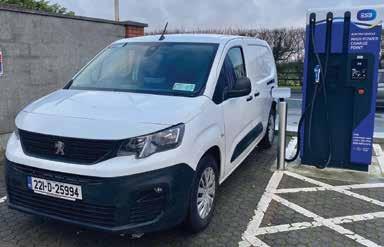
Importantly, you shouldn’t have to wait forever to recharge the e-Partner as it can accept fast charging at speeds of up to 100kW. That should replenish the battery to 80% charge from zero in around 30 minutes. Overnight charging from a 7.4kW wall-box will take around 7.5 hours to reach 100%, or 5 hours with a three phase 11kW wall-box.
Very like its diesel counterpart, if quieter, is the straightforward answer here. Anyone coming from the diesel model, particularly one with the automatic gearbox, will find it very familiar. The gear selector lever is the same as that found on the auto versions, with the addition of a B button which provides extra regeneration when lifting off, but won’t bring the van to a complete halt. There’s a choice of three driving modes including an Eco setting which limits the power to 81.5bhp and cuts back on the air-conditioning.
The display in front of the driver has an energy consumption gauge instead of a rev counter, while a second gauge displays how much energy is being used by ancillary equipment such as heating. Rather discouragingly, even turning the

heater on to level 1 out of 5, and with the aircon off, this shot the dial up to three quarters of maximum usage efficiency. Heated seats and steering wheel would be a useful addition here.
Other observations about the van not specific to the electric version are that the third seat in the middle is really only practical for occasional use by a smaller person, though the seat back folds down to give a useful work surface. The steering only adjusts for tilt, not reach, meaning I was unable to achieve an optimum driving position for me. The external mirrors also could benefit from having blind spot sections as found on other vans. Though I did like the pleasingly solid and most un-van like clunk when closing the doors!
Cost wise the e-Partner in L2
Professional Plus trim has an RRSP of €38,425 including SEAI grant. A diesel equivalent costs €29,295. That remains a significant margin, and probably means it remains an unrealistic option for many for now, even with significantly reduced
running costs. However for any LCV operator committed to going green, the e-Partner will meet expected requirements with minimal compromise.





Mercedes-Benz Vans, together with Austrian Post, is testing filter technology developed in cooperation with Mann + Hummel in real-life operations.
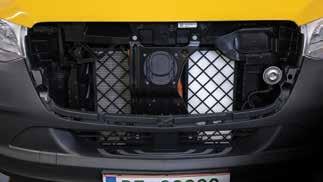
The technology, which is designed to reduce fine particle emissions in the immediate vicinity of the vehicle, including those generated from tyre, brake and asphalt abrasion, was first introduced in October 2021 via the Sustaineer (Sustainability Pioneer) technology platform from MercedesBenz Vans.
In August, two eSprinters operated by Austrian Post (Österreichische Post), the country’s major provider of postal services, were equipped with integrated fine particle filters in the front module. Since then, the all-electric vans have

After inspection and examination of the filters by the filtration specialist Mann + Hummel, it was determined that the filters were undamaged and without deformation. Since the start of the pilot project, the eSprinters were in use for almost 60 days and each filtered around 6.400 milligrams of dust from the ambient air.
This makes it clear, after just a few weeks of test operation, that the use of the filters in this urban delivery situation can be suitable for improving environmental air quality. The fine particles are filtered out close to the source, i.e. where the concentration level in the city is highest. Further results from the ongoing test operation are expected in mid-2023.

In addition to the durability of the filters, the pilot project will also analyse the effects on the vehicles.
The Institute of Energy & Environmental Technology (IUTA) in the German city of Duisburg is providing scientific support for the project. The filters are regularly checked on site by both Mercedes-Benz Vans and Mann+Hummel.
platform Sustaineer which shows how the electrified commercial transport sector can contribute to liveable cities
been out and about in Graz every day and have to date covered a total of almost 10,000 km on their delivery routes. Initial findings indicate that the filters can be an effective solution in eliminating particle emissions.
On their daily tours, Austrian Post’s test vans travel an average of 60 km each. The routes lead from the postal logistics centre in Kalsdorf to the city centre of Graz and back. On a tour, each of the two eSprinter delivers an average of 160 parcels and stops just under 100 times.
The initiative fits seamlessly into Austrian Post’s smart overall concept, known as “Green Graz”. Since November 2021, the Austrian postal fleet in Graz has been exclusively using all-electric vehicles for the delivery of parcels, letters, advertising mail and print media, ensuring that these are delivered with zero local CO2 emissions while reducing noise emissions in the city. The pilot project is intended to show how these successes can be further optimised.
The technology for this pilot project comes from the development of the Mercedes-Benz Vans technology
and resource conservation. The technology platform, developed in conjunction with Mann+Hummel, is equipped with two fine particle filters that filter particle emissions generated by tyre, brake and asphalt abrasion, as well as other fine particle emissions from the outside environment in the immediate vicinity of the vehicle. Working in combination with the suction fan already in the vehicle, particles down to a size of ten micrometres (PM10) can be collected. The effectiveness of the filtration increases further with higher levels of particulate matter in the environment. This means that in urban areas with poorer air quality, far greater quantities of particulate matter can be filtered out.
In addition, the vehicle is equipped with a fine particle sensor that measures the fine particle concentration in the air and can control the filtration performance accordingly. This means that the vehicle can also be used as a mobile measuring station. The filter elements can be easily removed and replaced during the annual service.
A pre-production version of the new Mercedes-Benz eSprinter, due later in 2023, completed a special test drive late last year. With only one battery charge and without recharging, the long distance route took the eSprinter from the Mercedes-Benz Museum in Stuttgart to Munich Airport and back again, a total distance of 475 kilometres. The electric van returned an impressive power consumption figure of just 21.9 kWh per 100 kilometres for the drive, despite the fact that the route chosen was extremely demanding in terms of fuel consumption due to the high proportion of motorways and the climb up the Swabian Jura. If those figures can be replicated in full production models, it points to the new Sprinter being a class leader in the rapidly expanding large electric van class.
The new Mercedes-Benz eSprinter will be launched with three different battery sizes. A pre-production variant with the largest of the three variants was selected for the test trial. With a view to a practical vehicle configuration for CEP use (Courier, Express, Parcel service), an extra-long eSprinter with a high roof was selected for the demonstration run.
The new Mercedes-Benz eSprinter is set to be launched with numerous configuration options and a high load capacity combined with a long range, making it, Mercedes-Benz hopes, one of the most flexible large electric vans in the world.

In order to replicate real driving conditions for an express delivery between Stuttgart and Munich, the journey was not completed on a closed-off test track, rather on a route incorporating inner-city traffic as well
as national roads and motorways. The topography was not optimised either, with the trip taking in the challenging climb up the Swabian Jura.
From the Mercedes-Benz Museum directly at the Mercedes-Benz plant in Untertürkheim, the eSprinter travelled on the B10 in the direction of Göppingen and on to Ulm. There the run changed to motorway driving, leading to Munich Airport via the A8 and A99. Afterwards, the drive continued on the motorway back towards Stuttgart, where at the Wendlinger Kreuz junction the journey led back to the MercedesBenz Museum via the B313 and the B10. With a total journey distance of
certified that the consumption of 21.9 kWh per 100 kilometres was achieved was achieved with one battery charge and that the vehicle was in due order.
With a potential range more than double that on offer from the current eSprinter (depending on configuration), the new eSprinter will be an important element in Mercedes-Benz Vans’ move to electrification, and towards achieving its “Lead in Electric Drive” target.
Key elements of the new vehicle were defined in close cooperation with the brand’s customers, including options for three battery sizes, and several body variants from panel van to chassis for box bodies. It means the

475 kilometres, the lowest section was at 210 metres above sea level and the highest at 785 metres above sea level. Upon arrival, the instrument cluster showed a remaining range of about another 20 kilometres.
To ensure independent verification, an inspector from TÜV Süd sat in the passenger seat next to the MercedesBenz test driver during the entire journey. As an independent testing organisation, TÜV Süd has officially
new eSprinter will be significantly more flexible than hitherto, opening up the potential of new customer segments as well as markets - beside Europe, the new eSprinter will be sold for the first time in the USA and Canada. The new eSprinter will be produced successively in Charleston (South Carolina, USA), Düsseldorf and Ludwigsfelde, Germany from the second half of 2023.
Text: Jarlath Sweeney - editor@fleet.ie

The Caddy – originally introduced in the United States in 1979 as the Rabbit Pick-Up – first rolled off European production lines in November 1982, and has since established itself as a major player in the compact and urban van market.
Originally based on the Mk1 Volkswagen Golf, and adopting its front end, over the years the Caddy has proven itself as a flexible, robust and reliable vehicle for tradesmen, delivery firms, young families and many more, with successes spanning across four decades and five generations of the model.
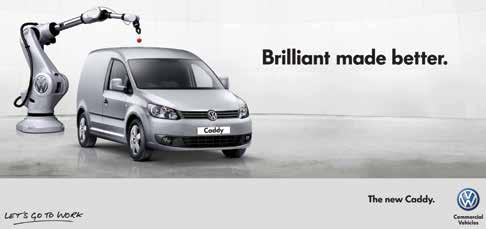
To celebrate the Caddy’s forty years of production, Volkswagen Commercial Vehicles is taking a look back over the history of this iconic van.
After the first-generation Caddy’s introduction in 1982, it remained on sale in Europe until 1993, before the introduction of the second-generation model in 1995. Available as a panel van
model, based on the Mk5 Golf platform, were substantial, with a greater variety of models including a flexible seven seat configuration that lent itself to young families for the first time, as well as improved payload and load space
The fourth-generation Caddy brought further improvements in vehicle safety and efficiency, as well as a range of two, five and seven seat configurations for complete customer versatility, making it practical for work and leisure, city driving or countryside excursions, family life and beyond.
Now into its fifth generation, the Caddy 5 is more innovative and versatile than ever, offering a host of driver assist systems and intelligent tech features designed to make driving simpler and more enjoyable, with features such as Bluetooth hands-free, a multi-function steering wheel, and an
The Caddy Cargo provides a wealth of space thanks to the van’s wide load bay, ranging from 3.3m³ to 4.0m³ – enough for two Euro pallets loaded sideways. Available with a choice of engines, the option of manual or DSG gearboxes,
and high-roofed estate, the Caddy Mk2’s versatility made it ideal for everyone from couriers to tradesmen and service providers.
Caddy ‘Mk3’ arrived in 2003, when manufacturing was moved to a Volkswagen facility in Poland that has been dedicated to producing the van ever since. Improvements made on this
emergency e-call system all included as standard.
Based on Volkswagen Group’s multi-purpose MQB platform, the Caddy range has been expanded to include the Caddy Life, Caddy Cargo and Caddy California.
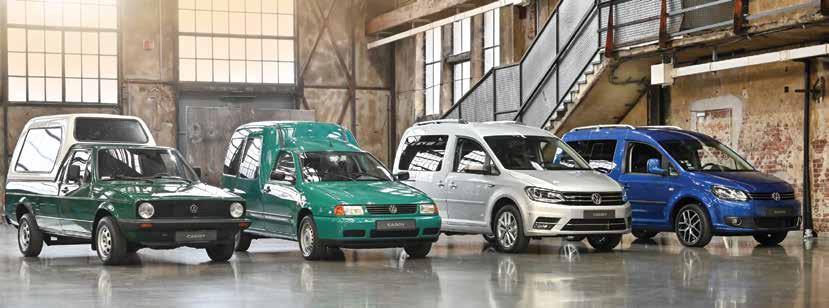
and 4MOTION all-wheel drive, the Cargo’s adaptability enables it to meet the needs of multiple commercial vehicle drivers, whether loading cargo, squeezing into tight spaces, or taking on longer trips.
A new variant with the 5th generation Caddy, the Caddy California serves as the perfect companion for those seeking adventure, offering a compact yet spacious living quarters including a foldout bed and mini-kitchen, while also remaining a practical five-seater passenger vehicle.
As the newest and most compact member of the Volkswagen campervan range, the Caddy California maximises on space, with the foldout bed doubling up as a rear shelf, while two folding chairs and a camping table make it a real home-from-home.
Packed with Volkswagen’s most advanced infotainment, connectivity, safety and driver assistance systems, the new Caddy California is the most innovative and versatile yet.
The S.KO COOL SMART EXECUTIVE is our top of the range reefer semi-trailer, and includes our exclusive S.CU transport refrigeration unit. Refrigerate more cost-effectively with our outstanding insulation system. Our services and TrailerConnect® telematics system are included to ensure lower maintenance costs and an impressive resale value. More Information on www.cargobull.com or contact Paul.oceallaigh@cargobull.com & mobile 0035387-7415512
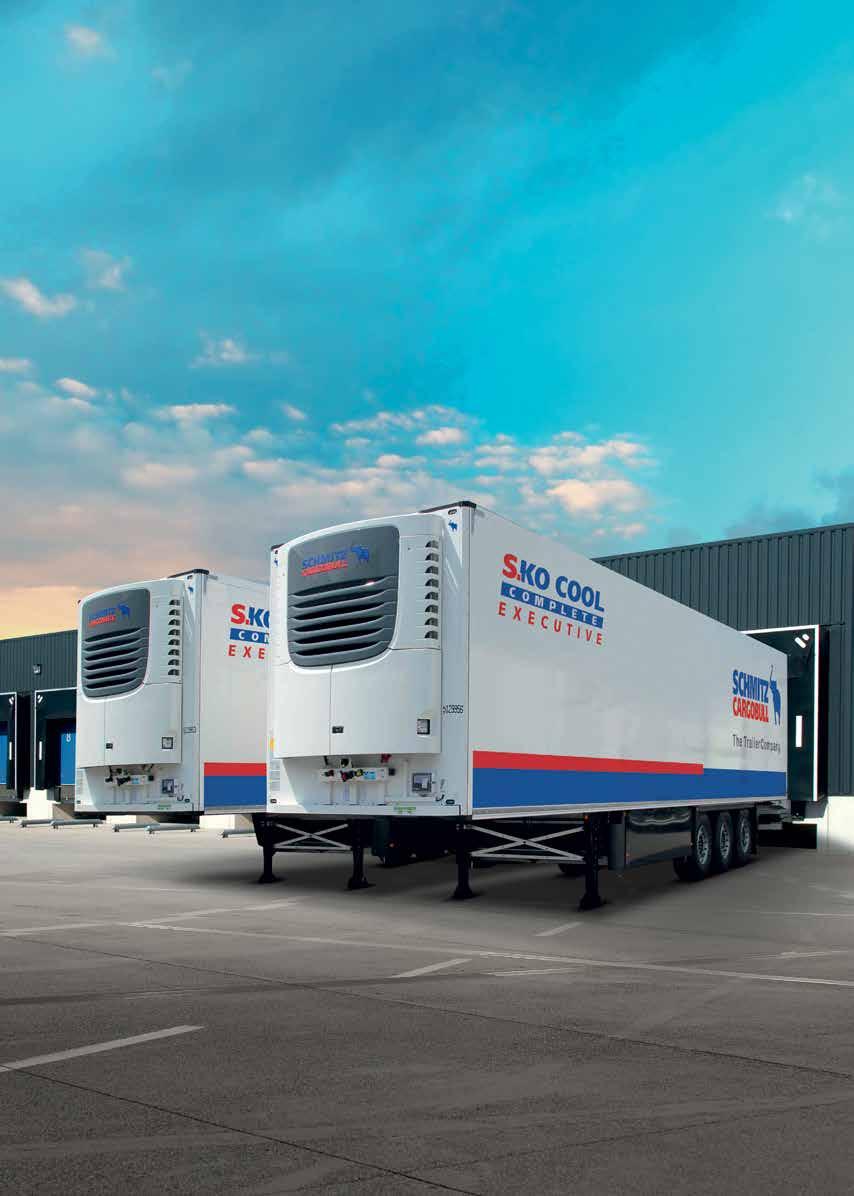



*25 Products & Solutions from 23 intralogistics providers from 7 countries nominated
*7 Start-ups in the final for the IFOY audit at Test Camp Intralogistics end of March
The International Forklift & Intralogistics Awards (IFOY) organisation has announced the finalists for the IFOY AWARDs 2023. Among a total of 39 applicants, 23 intralogistics providers from seven countries are shortlisted, including seven start-ups, featuring with 25 products and solutions. They will compete in the IFOY audit at the end of March, which will again take place at Messe Dortmund as part of the Test Camp Intralogistics.

“The audit of the IFOY finalists promises a spectacular setting this year. With their selection, the jury has lined up the best of the best in intralogistics. They show where the journey of intralogistics is heading in the future: classic warehouse technology is becoming increasingly sophisticated, quick commerce, robotics and AI (Artificial Intelligence) are making their way into logistics, and innovative details are making warehouse life more efficient, easier and more productive,” emphasised Anita Würmser, Chairperson of the IFOY jury. She expects a tough discussion in the jury sessions for the seven trophy winners, which will be announced and presented in the summer in Dortmund.
Intralogistics specialists AGILOX, Combilift, Continental, Crown, DS AUTOMOTION, HIKROBOT, IdentPro, Jungheinrich, Kemaro, Libiao Robotics, Mobile Easykey, NIMMSTA, Raymond,

STILL, Volume Lagersysteme, and Youibot Robotics are all vying to be among the prestigious title holders for 2023.
So too are the Start-ups, which include 1MRobotics, Chemovator (Loady), ff Fördersysteme, HUNIC, Predimo, Sentics and sereact.
The innovations of the IFOY finalists will be available for self-testing by visitors at Test Camp Intralogistics on 29 -30 March. The hands-on testing event for innovations and new developments enables decision-makers from industry, trade and the service sector to extensively self-test selected innovations on 10,000 square meters of hall space. In addition to the IFOY finalists, a total of over 50 innovations and 1,000 participants are expected at this year’s Camp.
“Due to its expertise, the IFOY AWARD is considered the definitive innovation award in intralogistics. The selection is preceded by an extensive audit with nomination and test cycles. The equipment and solutions nominated for the final undergo the IFOY test and the scientific innovation check individually at Messe Dortmund. In addition, jurors and their teams of advisors from industry travel to assess the finalists themselves. The coveted trophies will be awarded in the summer. Until then, the results will remain a secret – both for the finalists and for the public,” concluded Anita.
P66 Interview 1 – With Martin McVicar, Combilift
P67 Awards – IFOY 2023 Contenders
P70 Marketplace – Forklifts
P73 Case Study - ORNUA
P74 Interview II - Anita Wuermser IFOY
P76 Supply Chain - Howard Knott
Published by: Fleet Publications, D’Alton Street, Claremorris, Co. Mayo, Ireland F12 E7P2
Editor: Jarlath Sweeney – jarlath@fleet.ie
Contributors: Howard Knott, Johanna Parsons Joe O’Brien
Advertising: Mary Morrissey
Administration: Orla Sweeney
Design & Layout: Crackerjack Design House
Contact Details: Telephone: 00353 94 9372826 Email: handlingnetwork@fleet.ie
WHO GETS HANDLING NETWORK?
Handling Network - the magazine of the Irish Handling & Distribution Industry - is produced bimonthly by specialists in the materials handling sector, with contributions by experts on topics of special interest to its readership.
Handling Network is distributed on controlled circulation; addressed to key personnel in Ireland’s top companies and organisations. Recipients include Company Directors, Purchasing Managers, Warehouse & Logistics Managers, Plant & Production Engineers, Transport Managers, Safety Officers and other relevant personnel.
Areas covered include forklift trucks, warehouse logistics, racking, storage & distribution, commercial vehicles, plant & equipment finance, lifting gear, loading bay and conveyor systems...together with information on health and safety issues.
Although every effort is made to ensure the accuracy and reliability of the information contained in Handling Network, the publishers cannot accept responsibility for the veracity of claims made by advertisers, manufacturers or contributors or for opinions expressed.
Copyright for all material contained in this magazine remains with the publishers.
Martin McVicar, Combilift CEO & Co-Founder says that the future is looking bright for the Monaghan forklift and materials handling manufacturer, despite a difficult trading environment.

“While 2022 delivered a number of global challenges, Combilift enjoyed another record-breaking year, in spite of concerns around energy supply, inflation and supply chain security. Already 2023 is off to a strong start and we are confident that we will see another record year.
We took a number of measures to counteract these challenges which will bear fruit in the future. To ensure that we can fulfil our workforce requirements we have partnered with a local educational establishment and offer in-house traineeships and apprenticeships. We have also extended our premises so that we are able to carry a larger amount of buffer stock to cope with any potential supply chain problems.”
“As a testament to the tireless R&D department, a number of new products were launched in 2022,“ explained Martin. “These included the Combi-MR4, a 4-wheel electric powered reach truck with extraordinary multidirectional capability thanks to Combilift’s new Dynamic 360° steering. This enables seamless directional change while on the move, allowing forward sideward and crab steer mode for speedy operation.
The Combi-FSE is an electric four wheeled, two directional sideloader with 5,000kg or 6,000kg lift capacity which features a patented traction system and
is ideal for longer travel distances. It offers powerful performance and ease of maintenance, combined with the quiet and emission free electric operation that more and more customers are demanding.
Social responsibility and sustainability were high on the agenda to help customers lower their carbon footprint by reducing emissions. Over 65% of the products coming off the production lines are electric powered. In our own manufacturing facility we are also committed to recycling and reusing materials to conserve natural resources, and 92% of all components used in the truck assembly are fully recyclable.”
Looking ahead to 2023, Martin sees growth in a number of areas. “As was the case over the past few years, demand for warehouse space will continues to outstrip supply, which is pushing up costs. This will be a driver for growth of our space saving range of warehouse products such as the Aisle Master articulated trucks and the pedestrian stackers. We are also seeing increased demand from the offsite manufacturing and modular build industries. These are experiencing growth as prefabrication in a factory controlled environment ensures consistent build quality and also addresses the skill shortage affecting on-site construction. This has helped to boost sales of our larger multidirectional trucks and the straddle carrier and mobile gantry ranges. We also plan to invest heavily in products that are suitable for the offshore wind energy sector.”
2023 is a significant year in the history of the business, says Martin. “Combilift reaches another milestone this year when we celebrate our 25th anniversary. We will be marking this with a number of events in various countries throughout the year including the launch of the 75,000th truck to roll off our production lines in the first quarter this year. We will be inviting international dealers and business partners to join us at these events, to enjoy Irish hospitality and our dancing forklift routines. Closer to home we will of course be receiving guests at our factory, and following the success of our Open House in 2018 with more than 3,400 visitors in one day, we will again be welcoming the local community to our global HQ in Monaghan later in the year.
We are looking forward to marking this company milestone with our customers, dealers, sales personnel, representatives from the international trade press and of course our workforce and local community. Their loyalty and support has been pivotal in enabling us to achieve the amazing level of growth and success that we have experienced during the last 25 years. We’re not going to rest on our laurels though. We plan to launch 5 new models in 2023, and you can expect more innovation from us in the next few decades to come!”
To kick-start the new year on a strong positive note, Martin and Combilift have once again been recognised for their engineering excellence with the news that the AM-OPE - an Aisle Master designed for Order Picking - has been shortlisted for an IFOY (International Forklift Truck of the Year) Award. More news on that elsewhere in this edition.
With Jarlath Sweeney’Jury members for the IFOY 2023 Awards have selected a total of five manually operated warehouse trucks for final consideration, three in the high-lifter category and two low-lifters.




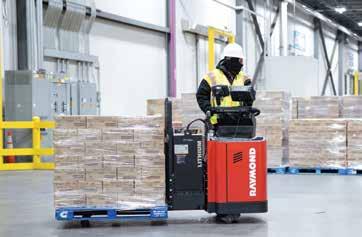
The Aisle-Master OP from Monaghan-headquartered forklift specialist Combilift, with a lift height of 12.1 meters and a load capacity of two tonnes, combines the advantages of a narrow-aisle forklift and an order picker. The forklift shows its strength in the high-performance segment, as well as in narrow
The jury also gave the green light to the manoeuvrable pedestrian pallet truck EHX 16 from STILL. With a load capacity of 1.6 tonnes, the low-lifter is particularly suitable for truck transport and last-mile applications. Advantageously, the lift truck features a unique tiller head with integrated display for intuitive handling. With an integrated lithium-ion battery, the shorter dimensions mean there is more room.
aisles for rack delivery and bulk order picking. The combi device can also be used as a conventional forklift truck with rubber tyres for indoor and outdoor applications, such as loading and unloading trucks.


The brand new SP 1500 from US supplier Crown received an IFOY nomination even before its official market launch. The completely redesigned order picker with a reach height of 11.2 meters and load capacities of up to 1.25 tonnes has been optimised in terms of all-round visibility, performance and speeds. With its ergonomic operator area and numerous innovative details, it is aimed not only at traditional order picking but above all at the requirements of retail and e-commerce.
Two final places were secured by the Hamburg intralogistics specialist STILL. The further developed PXV vertical order picker from STILL convinced the jury with its gripping height of 14.5 meters. Equipped with numerous safety and comfort features, an operator on the 1.5 tonne high-lifter can reliably pick loads in both wide and narrow aisles thanks to its compact and variable vehicle dimensions.
The final contender in the low-lifter category is US manufacturer Raymond with its 8910 End Rider Pallet Truck. The rugged 3.63-tonne capacity pallet truck was designed with a focus on energy efficiency and can be tailored to a variety of applications, including cold storage, wharves, loading and unloading, or long trips to handling centres. It also promises numerous options for better ergonomics and more productivity.
The bandwidth of IFOY applicants in the field of automated guided vehicles (AGVs) is traditionally large and international, with product offerings from a broad range of manufacturers, not just from the intralogistics sector. This time, four suppliers made it to the finals.
The new AGILOX ODM, short for omnidirectional dolly mover, from Austrian supplier AGILOX is an intelligent logistics robot for small load carriers weighing up to 300 kilograms. It does not require any additional infrastructure or navigation aids, can turn while stationary and allows parallel driving. The first vehicle can be programmed and implemented in less than twelve hours, with each additional one taking just 15 minutes. The core target group is the pharmaceutical and electronics industries.
The AMR IL 1200 from Continental Automotive Technologies is designed for use in warehouses or logistics centres as well as production logistics with heavy pallets, such as those found in the automotive and metalworking industries. With its integrated lifting system and various body options, the AMR IL 1200 transports pallets weighing up to 1.2 tonnes at a speed of two meters per second.
The F4-1000C Forklift Mobile Robot from Chinese manufacturer HIKROBOT, with a load capacity of one tonne, is an alternative to conventional warehouse forklifts and, with its positioning accuracy, is particularly suitable for 24/7 use in extremely narrow aisles and for material handling in the automotive, manufacturing and consumer electronics industries. Under the control of the in-house Robotic Control System (RCS), the F4-1000C works in tandem with other vehicles.
Also from China is the Automatic Trolley AT100 of Youibot Robotics, consisting of the brand-new AT100 AMR assistance picking robot and the YOUIFleet fleet management system. The intuitive combination of AMR and batch picking trolley for loads up to 100 kilogrammes manages a speed of 1.5 meters per second and was developed specifically for sorting and picking tasks in existing infrastructures as well as for workflows of retailers and 3PLs.
The three automated warehouse systems in the Intralogistics Robot category offer a strong starting field.
The automated, ultra-compact and scalable PowerCube compact warehouse system from Hamburg-based intralogistics company Jungheinrich adapts to almost any infrastructure and container dimensions. It can be used 24/7 across all industries and promises four times the storage density of shelf racking at room heights of up to 12 metres. The powerful lithium-ion shuttles can simultaneously pick up two 50-kilogram containers and load on the fly.
In the Airrob container handling robotic system from Chinese manufacturer Libiao Robotics, the robots can ‘climb’ up the shelves and store, pick, sort and move plastic containers weighing up to 35 kilograms. The simple and cost-effective solution is particularly suitable for micro-fulfilment centres or warehouses on a production line. Airrob focuses on e-commerce, footwear, apparel, cosmetics, pharmaceuticals and production parts storage.
Volume DIVE from Volume Lagersysteme is a sophisticated robotics-based storage and picking system for heights up to 14 meters. The robot can pick and deliver totes at any position without a lifter. Standard euro containers are stored as well as
beverage crates, which may also be used outside the system. Although DIVE was developed for quick commerce, it is also an alternative to energy-intensive miniload applications. Throughput can be scaled up to 4,000 containers per hour. In the smallest version, Volume DIVE takes up only 16 square meters.
The jury nominated a total of three solutions in the Intralogistics Software category. The Industrial Truck Key Performance Indicator (FFZ-KPI) developed by Mobile Easykey, as a component of the software, enables the determination of a manufacturer-neutral fleet efficiency of the intralogistics fleet with only one key figure and a visual traffic light system. The basis of the FFZ-KPI is the OEE key figure for the overall equipment effectiveness of immobile equipment. The FFZ-KPI adds further calculation parameters to the OEE, making the key figure for moving equipment calculable for the first time.
With the vehicle software ARCOS, the Austrian supplier DS AUTOMOTION enables devices to be used either as Automated Guided Vehicles (AGV) or Autonomous Mobile Robots (AMR). With the help of so-called ‘plannable autonomy’, the advantages of both technologies are combined. The user can use autonomous functions specifically where they bring advantages and prevent them where the disadvantages predominate.
The Warehouse Execution System from IdentPro promises up to 30 percent higher productivity. It uses IoT sensors on the vehicles to make all warehouse processes visible in the digital twin in real time (RTLS). The digitisation solution, which can be used indoors and outdoors, achieves centimetre-precise localisation (+/-10 cm) of goods and vehicles, collaborative use of autonomous and manned industrial trucks, and smart distribution of driving orders.
Three products are competing in the Special of the Year category. The Light Tags of NIMMSTA are a new pick-by-light approach that promises up to 80 percent more efficiency without integration effort. The intelligence is in the Industrial Smart Watch, which the worker wears on his body. In the NIMMSTA app, a storage location is assigned once to each light tag, to which it is simply attached with an adhesive strip. When the worker approaches, the Smart Watch and Light Tag light up in the same colour and pattern.
The world’s first fully autonomous K900 dry-cleaning robot from Swiss supplier Kemaro can save 70 percent of cleaning costs, which amounts to more than US$37,000 per year in a logistics company covering around 10,000 square meters. The compact robots with integrated dust extraction system navigate with the help of lidar and 3-D sensors and clean even the toughest industrial dirt. Their specialty is large indoor spaces.
Stacking, scanning and transferring results to any WMS ican be done by addedVIEW fork camera with barcode scanning function of Jungheinrich. The digital full HD fork tine camera with integrated image processing software for barcode scanning detects whether the correct or incorrect barcode is located in front of the tine, even at great heights, as it passes by. An acknowledgement button near the steering wheel eliminates the need for hand scanners and makes unnecessary unstacking of incorrect goods a thing of the past.

In the usual broad-based start-up category, the jury sent seven finalists into the final. The Israeli tech company 1MRobotics got the nod for its nano fulfilment centre of the same name for the last mile in omnichannel retailing. The modular robotic dark-stores are delivered worldwide in standard containers and are ready for immediate use. The business model is based on operational costs. Well-known companies are already relying on the technology.
The young German start-up ff Fördersysteme solves a ubiquitous storage problem with its patented 3D conveyor and drive system. The 3D chain adapts to the space and not vice versa. Whether it’s curves, ramps, elevators or inclines, different tasks can be solved in one track, eliminating the need for modular conveyor systems and saving space, but also opening up architectural possibilities. An application would be curved escalators, for example.
A return on investment (ROI) of six months is promised by AI software for autonomous pick-and-place robotics sereact of the supplier sereact. Picking processes that have already been trained in simulation can thus be transferred to new, unknown scenarios and integrated into existing warehouse management systems within one day without robot programming or time-consuming teach-in.

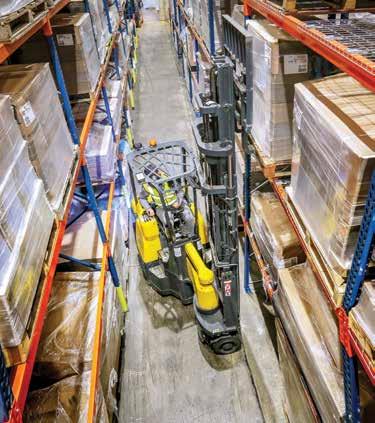
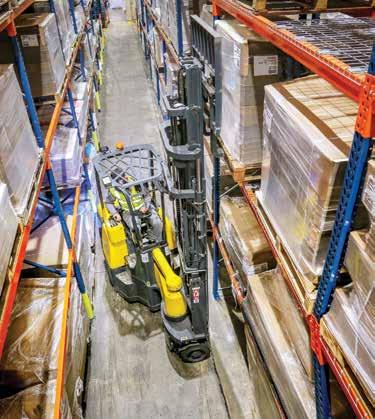
Munich-based startup Sentics enters the final IFOY round with the first optical, AI-based real-time localisation system ORTLS for industrial applications. Infrastructure sensors, which only need to be installed once in the industrial environment, detect and localise objects such as forklifts, people or machines and make this information available to fleet managers, as well as autonomous transport vehicles.

ComputerMyoGraphie by Predimo is a final contestant for evaluating workplaces in terms of ergonomics and process efficiency. With the help of cloud-based software and 17 IoT sensors over clothing, a digital human twin can be used to visualise which muscles and joints are actually under strain at work. This makes it possible to indicate physical overload as a key performance indicator and determine an ROI for ergonomics.
With its software-as-a-service solution Loady, the start-up Chemovator (Loady) is also entering the race for an IFOY AWARD. Loady provides standardised requirements for loading and unloading at industrial sites and serves as a central pre-product database. Equipment to be brought along, documents or processes on site are managed in a structured data model and serve as a source for all logistics partners. Free text fields or Excel files for logistics tenders, cleaning requirements and pre-products are no longer necessary.

An IFOY nomination also goes to the passive exoskeleton

SoftExo Lift from HUNIC. The extremely lightweight yet effective body-mounted lifting and carrying aid uses a spring principle to support the leg and back muscles when lifting and carrying loads by up to 21 percent, relieving the body of up to 50 percent of the load and positively influencing ergonomic posture.
Text: Jarlath Sweeney - editor@fleet.ie
The anticipated ‘bounce-back’ following the lifting of Covid-19 restrictions in the early part of 2022 was significantly impacted by a series of other challenges. The geopolitical environment resulting from the invasion of Ukraine, combined with inflationary pressures, created volatility which is likely to remain well into 2023. In addition, higher oil prices, supply chain disruptions, workforce constraints, and the challenge of matching capacity to volatile consumer demands are ongoing issues. The projected economic slowdown in Europe as well as China-Taiwan tensions could potentially exacerbate the uncertainty in 2023.
educational establishment to offer in-house traineeships and apprenticeships. Additionally the premises has been extended to carry a larger amount of buffer stock to cope with any potential supply chain problems.
As a testament to the tireless R&D department, several new Combilift products were launched in 2022. They included the Combi-MR4, a 4-wheel electric powered reach truck with extraordinary multidirectional capability thanks to Combilift’s new Dynamic 360° steering. This enables seamless directional change while on the move, allowing forward, sideward and crab steer mode for speedy operation.
2023 will mark the 25th anniversary of the company and the celebrations will include the launch of the 75,000th truck - set to roll off the production line, during the first quarter of the year. Combilft plans to launch 5 new models during 2023 and has just announced that the AM-OPE Aisle Master truck, designed for Order Picking, has been shortlisted for an IFOY (International Forklift Truck of the Year) Award.
David Goss, Technical Director of UK Materials Handling Association (UKMHA), highlighted the impact of geopolitical developments in 2022: “The economic outlook at the beginning of the year was extremely positive with a strong recovery expected. This was unfortunately disrupted by supply chain constraints, the war in Ukraine, political upheaval in the UK and rising inflation which combined to make market conditions unexpectedly challenging.”
According to the Industrial Truck Association, global equipment sales fell in 2022 to 2.25 million units compared to 2.34 million in 2021. However, many of the main manufacturers reported increased orders and revenues during 2022. The KION group, which includes Linde and Still forklifts, revealed order intake increasing by 2% from the previous year, and revenue rising by 9.4%.
Hiab has received significant orders in the USA for its Dundalk-manufactured Moffett M8 55 NX truck-mounted forklifts. Repeat orders worth €24.5 and 16.8 million respectively were placed by one of the country’s largest building materials supply companies. In addition, a record European order valued at €21.7 million for Moffett truck mounted forklifts was secured from Polish company Eko-Okna, one of the leading manufacturers of windows and doors in Europe. The company also extended its equipment portfolio, and showcased the latest additions to its all-wheel drive electric range at the IAA exhibition in Hannover.
Monaghan based Combilift reported another record-breaking year in terms of sales volumes and have implemented plans to mitigate the current challenges. To ensure workforce requirements are met, the company has partnered with a local
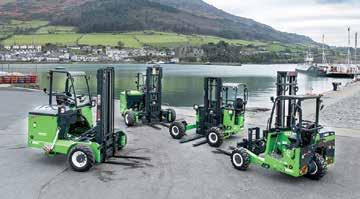
Jungheinrich reported a “solid third-quarter ”, with orders up 23% compared to the same period in 2021. The company celebrated its 20-year anniversary in Ireland offering over 600 different types of forklift trucks, warehouse automation solutions, warehouse design, pallet racking as well as used equipment options, short-term forklift rental, driver training and in-house finance options. Jungheinrich Ireland also supported Nolan Transport in the design and installation of a €12m investment at its recently opened new warehouse in Wexford, supplying an end-to-end solution including an extensive warehouse racking solution, wire guidance and a fleet of electric trucks.

Materials Handling industry reacts positively to challenging 2022co MBI l IFT M o FFETT
Another milestone during the year was the production of Jungheinrich’s 100,000th Li-ion truck. The ETV 216i reach truck was delivered to the Amazon warehouse in Leipzig. Key objectives in 2023 for Jungheinrich will include a continued focus on Electrification, Automation and Digitalisation.
Hyster-Yale also reported third-quarter growth in 2022, with revenues increasing by 13.1% from the same time last year. Both brands introduced several new products and trialled alternative fuels during the past year.

In May 2022, Yale launched the Series N truck range, enabling operators to customise their truck specification, to meet the demands of individual applications and driver requirements.
In November, the company introduced the MS20XD Platform Double Stacker which can be used in a wide a range of warehouse applications. The multifunc-
tional capability of the pallet truck enables it to transport goods directly from trailer to the first levels of racking, while the low lift function helps the operator to stack shelves or feed production lines without excessive bending.


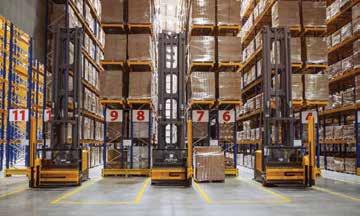
Sustainability and alternative fuel sources were very much to the fore in 2022 and this will undoubtedly continue to be the case in 2023.
Hyster announced testing of a Laden Container Handler powered by hydrogen fuel cells (HFC) at Fenix Marine Services in the Port of Los Angeles. The truck is powered by two 45kw hydrogen fuel cells and is designed to provide the zero emissions benefits of a battery electric option, with enough capacity to avoid the need to stop in the middle of a shift to refuel or recharge. The hydrogen fuel cell works in tandem with an onboard lithium-ion battery to either power the equipment directly or charge the onboard battery.
Meanwhile, Toyota Material Handling UK’s Sales Training & Product Development Manager, Sam Gray, has been promoting the benefits of HVO Fuel (Hydrotreated vegetable oil) - an alternative to fossil diesel, which can cut the CO2 emissions of engine-powered forklifts by up to 90 percent. Endorsed by a wide range of original engine manufacturers, HVO is synthetically produced using a complex refinery process that removes oxygen from vegetable oil and waste animal fat molecules,
creating hydrocarbons very similar to regular diesel. However, it is fundamentally different to bio-diesel and therefore doesn’t suffer any of the associated negative issues. One advantage of HVO is the fact that customers do not need to modify their diesel-powered forklifts to use it. Nearly all Toyota industrial IC engines will run perfectly with HVO fuel, with no changes required to the daily running or servicing regimes of the diesel engines.
The cancellation of the planned merger between Cargotec and Konecranes was one of biggest mergers and acquisition stories of 2022. The proposed deal failed to get regulatory approval, with the UK Competition & Markets Authority (CMA) finally blocking the proposed deal.
Closer to home, Briggs was on an acquisition trail, which included Aerial Platform Hire Limited, one of Ireland’s leading powered access hire companies, and Galway Plant & Tool Hire (GPT), which specialises in plant, commercial vehicle, and tool hire. The company ended the year by acquiring Blulift - yet
Component supply resulting in exceptionally long lead times were particularly challenging throughout the year and brought about an increase in demand for refurbished machines.
Toyota Material Handling UK noted that demand for its pre-owned forklifts was at an all-time high as companies looked to second- or third-hand machines to supplement their fleets, according to Stuart Reilly, TMHUK rental and used director.


In January, Jungheinrich opened its second used equipment refurbishing plant in Ploiesti, Romania, to help meet the growing demand for second-hand materials handling equipment and create capacity for further growth.
Combilift products help customers increase storage without the need to expand the size of their facility.
Understanding the available space and how it is being used is critical to running a more sustainable and profitable business.
To find out how Combilift can help you safely and efficiently load containers


combilift.com
The year also saw the resumption of the IMHX show in Birmingham, the first face-to-face event held under the guidance of the UKMHA, which was formed following the merger of the British Industrial Truck Association (BITA) and the Forklift Truck Association (FLTA).
Supply chain challenges were high on the agenda at LogiMAT 2022 which attracted exhibitors from 39 countries at the Stuttgart showgrounds. The war in Ukraine and the sanctions imposed on Russia caused a shortage in global steel supply which resulted in significant price increases, however, this appears to have stabilised in recent months.
In June, intralogistics specialist Linde Material Handling presented its extensive portfolio of products and solutions at an event for customers and dealers from around the world at its World of Material Handling (WoMH) event in Mannheim, Germany.
In addition to the economic sanctions imposed by governments on Russia in response to its attack on Ukraine, forklift makers rallied in support of relief initiatives. Combilift teamed up with the Ukrainian Red Cross Society, making an initial contribution of €50,000 to aid the supply of relief to the displaced civilians. JCB offered housing to 70 refugees, while KION donated €1 million to the German Red Cross.
Joe O’Brien - contributor@fleet.ie
Ornua Foods is Ireland’s largest dairy products business, exporting to 110 countries worldwide. Headquartered in Dublin, and previously known as the Irish Dairy Board, it has annual sales of over €2.5 billion, 15 global subsidiaries, and a global team of some 3,000 employees. Ornua operates from 10 business units globally, including 16 production facilities. Its brands include Kerrygold, Dubliner, Pilgrims Choice, Adam’s, Horlicks Farms, Forto, and BEO.
Ornua Foods owns and holds large stocks of butter, cheese and milk powders. Before the upgrade, it used over 80 refrigerated storage locations
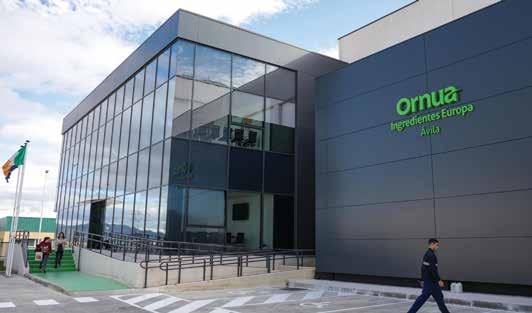
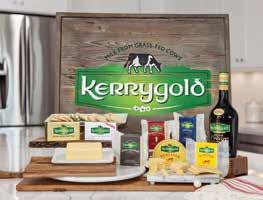

Freshness is key for Ornua’s dairy produce, and the storage and distribution methods are dictated by the original production date of each item. This means that it is essential that the business has full, real-time visibility of all of its product stock and locations.
Oruna required each warehouse to get automatic access to the Movex ERP system so that instructions and reports could be exchanged instantly and in real-time.
It selected In-DEX WMS (Warehouse Management Software) provided by Irish IT business Principal Logistics Technologies.
Since the cold stores came online, real-time stock information has become available for the entire company, reducing data input and improving product traceability throughout the supply chain.
“As far as we are concerned, they did an excellent job in a very short timescale,” explained Kevin Woods, business analyst, Irish Dairy Board/Ornua. “The warehouses using In-DEX were very easily and smoothly integrated into our Movex ERP system. After the first short period of testing and familiarisation there have simply been no software issues.”

Any transaction queries or discrepancies are flagged straight away, with no extra data input by the stores.
across Europe. Sales orders and stock movements were fully controlled from head office, with direct instructions being sent, at any time, to the various sites holding stock on its behalf. There would be about 7,000 pallet movements per day.

The In-DEX WMS also provides an error-reducing feature. It is no longer possible to despatch the wrong pallet because orders feed directly through to the pick list.

Warehouse and logistics partner feedback also confirmed that average
truck turnaround times were reduced because the relevant loading data is usually on the In-DEX WMS system in the warehouse before a truck has even arrived.
Paper based records and lists have been eliminated across the supply chain. Payments are faster or automated, with discrepancies flagged immediately. Errors have been reduced and truck turnaround times are faster.
Eoin Hennessy is Managing Director of one of Oruna’s facilities, Orchard Warehousing & Cold Storage in Cork. He describes the significance of the change: “No paper, no emails, the whole operation is streamlined. Errors are almost eliminated compared to the tedious chore of transcribing information from masses of documents, which in fact was a bit of a nightmare at peak periods. We hold up to 6,000 pallets at any time, with maybe 200 or so moving in or out daily. So the automated links between the Irish Dairy Board [Oruna] and our In-DEX system, which in turn is integrated with our Sage Line 50 ERP, have significantly reduced the clerical working hours needed.”
Text: Johanna Parsons - contributor@fleet.ie
While the corona pandemic forced many organisers to cancel trade fairs and congresses in the past two years, the International Forklift & Interlogistics Awards (IFOY) Test Camp Intralogistics continued to develop and evolve. For the 2023 programme the event is going to be all about testing, trying out, driving and experiencing live when it opens its doors at Messe Dortmund from 29-30 March 29. Up to 100 selected innovations and new products from ten countries will be available for self-testing on 10,000 square meters of hall space.
“Don’t call it a trade fair,” stated Anita Würmser, Managing Director of Test Camp Intralogistics, and Jury Chairwoman of the IFOY Awards and the Logistics Hall of Fame, in an interview with Handling Network.
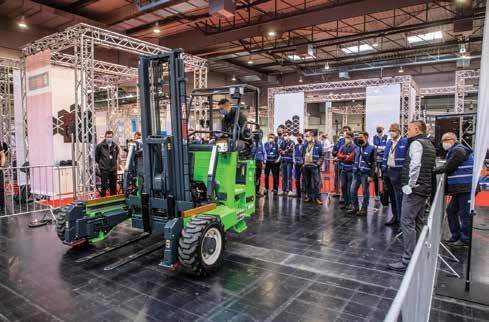

cancelled, was the buzz word of 2020, ‘21 and even at the beginning of ‘22. Yet Test camp Intralogistics attracted an attendance of almost 1,000 participants in the middle of a lockdown, how did you manage that?
I have been asked that countless times. We just did it. In a nutshell, it was 200% work, 100% courage, 0% planning security. The authorities were tough but helpful, the regulatory requirements gigantic, not to mention the risk. In the end, the momentum was the courage of everyone involved. Guests, exhibitors, testers, team, judges - they all came to test and feel the innovations and keep the business going. And everyone followed the rules accurately. It was a bit scary, though, when we were in the middle of the lockdown in 2021 with 650 people all alone in the hotel and on the exhibition grounds.
How was the response to your trade show?
The response was surprisingly positive. 960 media in 79 countries reported on us. After all, the Test Camp is not a trade fair, but a test event for the industry with limited access. Therefore: Don’t call it a trade fair. But you’ve got booths, exhibitors, visitors. Why do you say “Don’t call it a trade fair”?
The Test Camp is an interactive event of selected innovations for decision-makers. A trade fair is designed for a mass audience, with a goal of filling halls and aisles and the widest possible range of exhibitors. At a trade show, anyone can exhibit, with us it’s preselected. At a trade show one has to find their own way around, at the Test Camp, we guide visitors through the hall in highlight tours.
Not everyone can exhibit, not everyone gets in? How do you make the selection?
Besides a limited ticket contingent, we and the exhibitors invite top-level
B2B guests with a strong innovation and investment interest for hands-on testing. The target group is decision-makers who not only want to look at the best innovations, but experience them live, test them themselves, drive them and try them out. Those who want to know what’s next. We pay particular attention on an interesting mix and match. On the one hand, the finalists of the IFOY Awards already represent the best innovations of the year. In addition, we take care that only new and innovative products are shown and we research and approach companies worldwide that have innovations and new products to offer.
Was the Test camp was born out of the IFoY AWARD?
Correct, but the Test Camp is now an independent event. The IFOY audit of the finalists, the so-called IFOY Test days, remain as part of the Test Camp. For some time, only finalists, jurors, testers and IFOY partners had access to the IFOY Test Days, all in all no more than
150 people. During IFOY Test Days in 2017/18, some jurors invited contacts from their readership (the IFOY jury consists of editors-in-chief from leading logistics magazines worldwide, including Fleet Transport/Handling Network). A few logistics service providers were there, an automotive supplier and manufacturer, a DIY store manager, a furniture retailer from the region, and all were excited about the opportunity to test the IFOY finalists themselves. So why not allow a limited number of B2B guests? Then, in early 2020, we invited 50 guests as a test run, and by 2022 there were almost 1,000 participants.
Which industries do the visitors come from?
The strongest group is logistics service providers, especially contract logisticians. The automotive OEMs are also well represented. E-commerce and stationary retail, but also the consumer goods and beverage industry, mechanical engineering, chemicals and pharmaceuticals are well represented. This year, we also expect numerous employee representatives, which is due to our special test area - exoskeletons and ergonomics.
The Test camp positions itself as a sustainable event. What makes it different?
We didn’t want to claim sustainability as our motto and at the same time leave behind gigantic mountains of garbage after the event. That’s why, for example, the question arose as to whether and how much stand construction was necessary at all. We could also have invented a test fair with individual stand construction and show elements. That would have been more lucrative, but certainly not sustainable. The hall or the test areas don’t have to sparkle, they have to be functional. All stands are therefore centrally planned, set up
and dismantled. The branding is standardised and simple. Custom booth construction is not permitted, nor are shows or superfluous decorations that are not necessary for the functionality of the exhibit. Almost all materials are reusable. We use aluminium trusses, Mannesmann fencing, and rental furniture from nearby service providers. Carpet is shredded after the camp and reprocessed into carpet, and central catering saves water and resources. The hotel is 100 meters from the hall, and we use green electricity. It boils down to minimalism, but true innovation doesn’t need decoration.
humanoid robot, operate a horizontal order picker, try out an exoskeleton, drive a forklift or just look at it all.
Self-testing. How does that work?
We take visitors on highlight tours of all the exhibitors to give them an overview of the innovations. Each exhibitor presents its innovations in two or three minutes and then visitors can test drive or test individually. The test areas are cordoned off, and we also hand out high-visibility vests. And safety shoes are mandatory on the test areas.
In March, the next round of the Test camp Intralogistics at Messe Dortmund takes place. What innovations are on the agenda?

Up to 100 selected innovations and new products from ten countries will be there. They include warehouse technology equipment, forklifts, software, robot solutions, AGV and AMR, interesting special solutions and, of course, the finalists of the IFOY AWARD. Spectacular settings are also promised by the new edition of the AGV Mesh-Up of the VDMA Association for Materials Handling and Intralogistics,
Will exhibitors and visitors settle for less?

What is most important and at the same time most difficult for success in logistics? It’s technology. If you rely on the incorrect software and hardware, if you miss the crucial innovation, you’re out. That’s why many companies are open to new ways of doing things, and our focus on innovation and new products and the all-inclusive approach offers many advantages. And it makes a difference whether you work with a
the Exoskeleton & Co. Arena and the Order Picker Safari. It will definitely be an experience. The congress program also includes a whole series of talk panels on the subject of innovation.
What’s next? What are the plans for the future?
We will emphasise the self-testing character even more and expand the talk panels. We also want to show more visions of the future in addition to the new developments already available on the market.
The Irish Exporters Association (IEA), put together a webinar in conjunction with the Irish Revenue Customs Service last month. The event was attended by over 120 exporters and others involved in international Supply Chains, and focused on the introduction of Automated Export Systems (AES). The changes taking place are the final part of the introduction of the EU Union Customs Code and will give consistency of practice throughout the Community and with Great Britain, which, having been within the EU at the time of introduction of the Union Customs Code, has fully implemented it.
The AES system is operational from 1 February and replaces the long-established AEP system which will be taken out of service from 1 April 2023. Revenue has put full details of the new system and a user guide as to how it operates on its website, and will also issue guidance through organisations including IEA and Intertrade Ireland.
One specific goods category which will not need declarations will be goods of a value of less than €1,000 and less than 1,000 kg in weight. However, foodstuffs will always need a declaration.
Following the UK Government’s decision in 2022 not to impose the scheduled import controls on EU goods which would have proven to be too onerous for importers, it has devised a new Target Operating Model (TOM). This will be published within the coming weeks and will set out how it intends to deliver the 2025 Border Strategy. Following a period of consultation, the final document will be published in late 2023.
According to a statement from the Department for Environment Food & Rural Affairs (DEFRA): “TOM will set out our new regime of border controls, and create a seamless new digital border where the harnessing of new technologies, real-time data and better coordination will reduce friction and costs for businesses and consumers, and create a radically simpler yet secure experience for traders moving goods across the UK Border. Alongside the development of a world-leading border for trade, this Government remains committed to protecting and enhancing UK biosecurity”
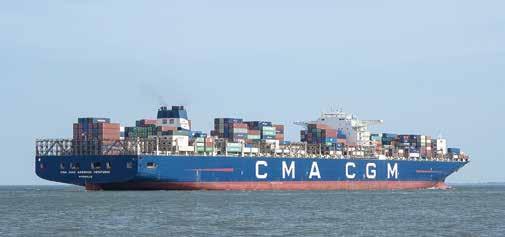
In the second quarter of 2022 the lives of Supply Chain Managers at companies trading in markets outside Europe became particularly difficult. Though it appeared that the COVID-19 effect might be tailing off, the Russian
invasion of Ukraine not only stoked great market uncertainty, but it also kicked off significant inflation of costs in every aspect of business.
Deep Sea shipping rates continued to shoot upwards, with the increase driven by container shortages, port congestion, and choked distribution systems in Europe, Asia, and the US. The on-time delivery of container shipping services plummeted to about 30%, further fuelling demand for goods to replace the late products.
As 2022 wore on world economies slowed, leading to a steep drop-off in demand for goods and raw materials. An immediate effect of this was that the queues of vessels waiting for entry to major ports disappeared, and cargo began to move much more quickly. This, in turn, led to a pile-up of product in warehouses and a lack of forward ordering from customers.
At the peak rates time, when the sea freight alone costs of a 40ft container from Shanghai to Rotterdam was in the order of $20,000, cargo owners were advised to take out annual rates contracts with Carriers and Forwarders which would give relief from further increases and stabilise their businesses. Now the situation is that spot rates on traffic to and from Asia have dropped by anything up to 85%, though rates on North Atlantic trades have dropped very little.
The advice now for any Supply Chain Manager shipping product to or from markets outside Europe must be to engage with their chosen carriers or Forwarders, to steer away from an annual contract rate towards an index linked one, and to seek to do business only with carriers who can be shown to deliver on what they promise.
Text: Howard Knott - howard@fleet.ie
Concerns have been raised that changes to benefit-in-kind (BIK) tax bands that came into effect in January will have a severe impact on the leasing car market, with employees who are currently driving company cars opting instead to switch to private vehicles.

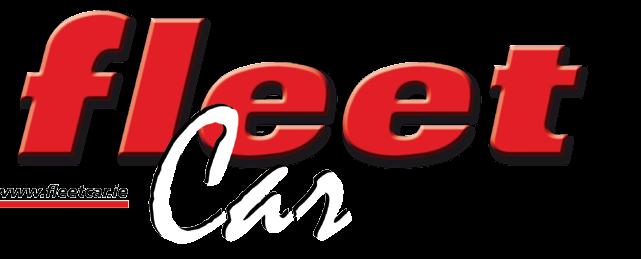
The new BIK tax bands take CO2 emissions into account for the first time, with the amount taxable as BIK determined based on the car’s original market value (OMV), the annual mileage covered, and bands based on CO2 emissions. Previously BIK was calculated from the OMV and the annual mileage.
The flat rate for vans has increased from 5% to 8%, while the OMV threshold for zero BIK rate applicable on electric
vehicles will be reduced from €50,000 to €35,000, with that threshold set to fall further to €20,000 in 2024 and €10,000 in 2025.
As a result, BIK rates on EVs will range from 9% to 22.5% depending on mileage, while ICE powered cars can be liable for BIK rates of up to 37.5%. While the Government said the approach was to incentivise companies to provide employees with low-emission cars, the leasing industry believes that the unattractive BIK rates will result in employees giving up their company cars, choosing instead to avail of a company car allowance and buy privately.
The industry fears that an increase in this so-called ‘grey fleet’ will result in an increase in older and more polluting cars being used for work purposes. Speaking to Fleet Car, Michele Hanlon, President of the Vehicle Leasing Association of Ireland (VLAI) called on the Government to rethink its approach: “We are continuing to seek a fairer way, specific to leasing, with a reduction in the BIK levies. We do
realise that there is a cost to cleaning up the environment, but increasing BIK is counter-intuitive.” (See the full interview with Michele on the following page).
Opposition TDs have also criticised the new BIK levies. Sinn Féin TD for Mayo, Rose Conway-Walsh said the changes will heap more financial pressure on people in the midst of a cost-of-living crisis.
“Thousands of workers with company cars will be hit with a massive tax hike in January. Many of these workers are already on very modest wages working very long hours each week. The benefit-in-kind (BIK) tax is going to soar by 40% for those who are provided with vehicles to do their job by their employer.”
She added: “The government is urging companies and business owners to make an environmental change but the tool they are using to try push them towards greener options is an additional tax on workers at a time when people are suffering the highest inflation for decades.”
changes will drive employees toward grey fleetEdited by Cathal Doyle - cathal@fleet.ie
“The fleet sector is ever changing and evolving,” said Michele Hanlon, President of the Vehicle Leasing Association of Ireland (VLAI), who is about to complete the first year of her tenure as head of the national body for the Irish fleet management industry.

BIK is very much on Michele’s agenda in her day-to-day activities as Sales Manager at HB Dennis Leasing. She notes that the latest Benefit in Kind (BIK) changes within the Budget Finance Act are possibly and probably the biggest issue and change facing professionals car drivers in recent years. It’s an issue on which Michele and Council members have been actively lobbying Government Ministers and officials on. “The changes to BIK are killing our industry,” she stressed, adding; “The phasing out of the zero percent BIK on Electric Vehicles over the next 4 years, under the Finance Act must be looked at again. The way the Government officials have dealt with the issue is pushing away the move towards electrification of the business car fleet, totally penalising drivers in moving to zero-emission vehicles. In addition, it is missing an opportunity for the motor industry to provide a clean, green, safer and fresher used car market.”
“A rethink is necessary, and we are continuing to seek a fairer way, specific to leasing, with a reduction in the BIK levies. We do realise that there is a cost to cleaning up the environment, but increasing BIK is counter-intuitive. But
being rewarded to cover more miles to reduce rates is counter-productive in terms of reducing carbon footprints. Another consideration is the fact that all cars (and vans) have increased in price substantially, especially BEVs that have longer range distances. Company cars are not a perk but a necessary tool to do business.”
Michele would like to see a broader selection of electric cars becoming available, especially in the smaller car segments: “Not everyone needs a long distance range, so a better line-up of smaller, cheaper cars are needed in the marketplace.”
The VLAI has enjoyed a growth phase in recent years, attracting more members, with many of the bigger fleet management companies becoming major stakeholders and active Council members. Michele stated that “with a full representation from this specialist sector, one strong and singular lobbing focus can be undertaken. There’s strength in numbers.”
Calculating residuals for electric cars is proving difficult, and a risky game. Also, many formulae are involved and taken into consideration. “Currently, the option of petrol/electric hybrids for our operators is not working. For one thing, there is no VAT rebate on the fuel and [they are] more expensive to run from a fleet operational perspective.”
With the Green Party stating that it wants to see less cars on our streets, the alternative options are car sharing or carpooling, developments that are already happening in Europe. It is something that the VLAI membership is looking to get involved in. The issue of actual car ownership, insurance cover, compliance and maintenance could be handled by an organisation like the VLAI, which has experience and expert professionalism in
this area.
Managing the grey fleet is becoming a bigger issue within the industry, and something that Michele and the VLAI are continually trying to address. “Over the years, the option of the driver to own their own car and use it for business or work purposes has increased. The concern lies between undertaking repairs and maintenance and the duty of care involved. We are aware of the cost of living crisis, but if a set of tyres are not replaced, for example, and an accident happens, the insurance cover could be negated. The RSA has issued guidelines but we need clear legislation to be initiated in this country in this regard. In the UK, duty of care comes under Corporate Responsibility, which is a serious matter with severe penalties. Overseeing the management of own account vehicles on behalf of companies is something that we may look at from our side.”
At the 2023 VLAI AGM in April, details of the makeover of the organisation, undertaken over the past few months, will be revealed. It includes a new chain of office, a restyled logo and a totally revamped website. “It’s time to create a new image and refreshed branding to meet our changing times and become more vocal within the business end of the Irish automotive industry.”
She paid special tribute to her predecessor Morgan McAndrew, for overseeing the organisation’s operations during the very difficult pandemic lockdown periods. “Morgan carried us all along during the most challenging period in the motor industry. He was also involved in putting the plan together to carry the VLAI into the future for all members to benefit from.”
With Jarlath Sweeney - editor@fleet.ieFor the executive corporate car driver who covers above average mileage, the big question is whether to stick with diesel power or move over to zero-emission electric. Eventually this will have to happen but for now to maintain the same premium level of motoring, diesel seems to be the most economical, convenient and viable option.
Take the Mercedes-Benz E-Class , for instance. Comparing the diesel E220d and the electric EQE 350, brings out interesting findings.
Talking with a loyal E-Class driver, a person who hasn’t time for any other car, this is a result of having had consistent love affairs with each generation of the E-Class. The excellent fuel economy of his E220d and numerous driver comforts are top of his conversation agenda every time we meet. Our last chat was on the merits of the new EQE, as the interest inside his head and heart is growing.
of 641km. The E220d, on the other hand starts at €68,850 and has a 2.0-litre Euro 6 diesel delivering 200hp/440Nm. With a full tank, it can travel over 1,200km, according to its driver’s figures that record an average consumption of 5.2 l/100km (though at times recording as low as 3.9l/100km).

Delving further into a back-toback analysis, based on the test EQE’s recorded long term average energy consumption figure of 17.5kWh/100 km, it would cost €7.57 for a range of 100km based on current 24 Hour Standard Rate ESB home electricity prices of €0.4327. Whereas the E-Class would cost €9.10 to cover that 100km based on its average fuel consumption figure and current average pump prices of €1.75/litre for diesel. Slightly cheaper for the electric car (provided it is charged at home) but that doesn’t factor in that the diesel car takes only minutes to refill, in contrast to the 32 minutes or longer (depending on fast charger speeds) needed to recharge the EQE up to 80% of the battery pack’s capability/capacity. Note also that it is considerably more expensive to charge at public charge points like those provided by IONITY.
annual motor tax - €120 for the electric versus €390 for the E220d, there is still a big gap between the overall costs associated with the electric over its diesel counterpart.


Granted there are less maintenance costs with electric motors compared to the need to regularly service diesel engines, (not to mention the ongoing AdBlue refills, which are proving more costly these days). But in favour of the diesel power the VAT rate charged can be rebated from Revenue. Changes to BIK rates may also make EVs less appealing than hitherto.
Two key elements are pertinent in the decision on whether to go electric –purchase price and running costs.
Having spent a week on board the EQE 350+ AMG Line late last year, the base price comes in at €85,980 for the similarly sized four door saloon that can be compared as a like-for-like with the E220d. Its 215 kW electric motor and 90 kWh battery pack produce 292hp and 565Nm of torque, while offering a WLTP measured stated range capability
Both are impressive looking machines to look at and drive. Similar in size, their shape differs, with the EQE more akin to the CLS model than its E-Class sibling. It certainly does stand out more on the road and in car parks. The illuminated pop-out door handles are cool and the dash board and large (12”) MBUK interactive touch screen is completely different and new to the E-Class family. The EQE comes loaded with advanced safety and comfort fittings, although we noted that the active brake assist system has a slightly unnatural feel to it initially, until you get used to it. ‘One pedal’ driving is achievable thanks to the variable regenerative braking available in four levels of off, low high and intelligent.
Considering it weighs in at over 2.3 tonnes GVW, the EQE handles surprisingly well, travelling smoothly on all surfaces.
Space inside is not compromised, with plenty of leg room evident and the boot space is adequate at 430 litres.
Even with the difference in the
Up against rivals that include the Tesla S, Prosche Taycan and Audi e-tron GT, the EQE is a well packaged, competent and attractive all-rounder capable of travelling a distance on a single charge that should allay any range anxieties. The only concern is its affordability. And the fact that we could not convince the E220d driver to switch allegiance any time soon!
Text & Photos: Jarlath Sweeney - editor@fleet.ie
Drivetrain: 215kW Electric motor/ 292hp/ 565Nm torque (90kWh battery pack)
WlTP range: 641km
Transmission: Automatic; single-speed; RWD
Road Tax: €120 (7% VRT/ Band 1)
Base price: €85,980
Plus extras: €106,404
If the past couple of years have been anni horribiles for the motor industry, as a result of the Covid pandemic and follow-on supply chain difficulties, there are hopes that 2023 will see things change for the better. However many challenges remain, not least for the fleet sector. Fleet Car asked representatives from three different car brands, Audi, Kia and Opel, what their thoughts were on the state of the company car market heading in to the New Year.
One of the fallouts of the relative shortage of vehicles was that for some manufacturers at least, meeting the needs of private customers was at least as important as fulfilling bulk orders for the fleet and leasing sectors.
A spokesperson for Audi Ireland said that the brand will continue to allocate a portion of its allocation to the fleet sector. “Despite the challenges that the industry faced in 2022, Audi had a very successful year. We recorded another year of leadership in the Premium Market with the market share of over 4%. A very strong order bank for 2023 has led to robust sales in January with market share of 4.8% MTD.”
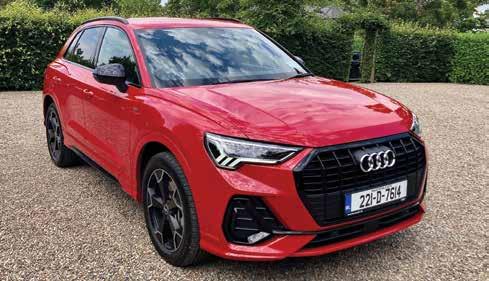
Audi envisages that its position will remain a positive one over the coming months. “At Audi, all customers are
valued regardless of whether they are private or fleet, every year we ensure a percentage of our total volume is allocated to the fleet channel and there is no proposed change to this process for 2023.”
According to Fleet Sales Manager for Kia Ireland, Maria O’Mahony, the fleet focus remains strong:“Our priorities with respect to the fleet market is to maintain the relationships that have been built over the years and to supply where possible. Kia will continue to offer demonstrations and loan cars where requested.”
Getting vehicles in preferred specifications remains a challenge according to Fergal Marron, Head of Fleet at Opel:: The ongoing supply disruption means placing orders for particular vehicle specifications, volumes and delivery timelines is risky as some or all of these vehicles may not get built exactly as requested.
Hence we tend to order vehicles in standard specifications, and offer customers vehicles as they are actually built, meaning the specifications, costs and lead times are known.”
Fergal added that the fleet side of the business remains important for the Stellantis Group brand. “Opel will continue to supply vehicles, especially vans, to large fleets, who remain key Opel customers, in addition to our retail customers.”
With manufacturers easily able to sell every new vehicle they could get hold of, offering discounts to fleet customers became less of a priority in the last two years. It’s a situation that’s likely to continue into 2023 according to representatives from the various car distributors.
“We are experiencing substantial volatility in raw material, component, labour, energy and transportation costs, meaning there is ongoing substantial price inflation, so we no longer have the margins to offer large discounts to any customers,” explained Opel’s Fergal Marron. “In overall terms all companies are experiencing increasing costs and many have lower sales volumes, meaning the revenue per unit needs to be higher to cover costs so there is unlikely to be a return to pre-Covid levels of fleet discounts in the short term.”
Kia’s Maria O’Mahony concurs: “Yes, I feel that this will continue in 2023 as manufacturers are passing on increased production costs to distributors.

Some optimism, but challenges remain for fleet sector in 2023
Increased costs are impacting on margins for vehicles which makes it increasingly difficult to offer incentives and discounts. Shortage in supply and high demand for vehicles also means that it is impractical to offer discounts in these economic times.”
Audi Ireland points to a dedicated service it offers for fleet customers: “VW Group Ireland / Audi Ireland launched the Fleet Agency Program from the 1st of Aril 2022 which offer competitive trading terms. This program is continuing throughout 2023.”
One of the big concerns for the fleet sector heading into the New Year are the revisions to the benefit-in-kind (BIK) criteria, with fears that running company cars may no longer be attractive to many employees, leading in turn to an increase in the use of older, more polluting cars that are not as well maintained. It’s a concern that the car distributors agree can have the opposite result of reducing emissions that the Government hopes to achieve.
“The feedback that we are getting from our lease customers regarding the change to BIK raises serious concerns for the company car market in 2023,” replied the spokesperson from Audi

have the opposite effect on reducing emissions.”
Maria O’Mahony sees the impact as being more gradual: “I think the impact will not be fully felt in 2023 as there are many outstanding fleet orders and pent-up demand in the fleet channels. Many larger companies have adopted a green policy which means drivers must get an electric vehicle as a company car.
Yes, I absolutely feel that the Government should be doing more to encourage the use of company cars and recent budgetary changes in reducing grants for individuals and removing grants completely for companies and increasing BIK rates have all gone against promoting greener cars. These measures will promote grey fleet where it will be more beneficial for an employee to drive their own car and claim mileage – these cars will be older and less green.”
“Like any measure that has an effect on a worker’s take-home pay, BIK is being examined closely to determine the vehicle with the lowest impact,” notes Fergal Marron. “While it is acknowledged that changes to taxation can influence behaviour and these measures are designed to push people into lower-emission vehicles, it is unfortunate that the real effect of this change is to add more cost to businesses and working people driving vehicles, especially while at the same time efforts are being made
While interest in electric vehicles continues to grow, does the industry feel that the fleet sector is keeping pace with the demand from private buyers? Fergal Marron feels that the reduction and eventual elimination of zero percent BIK on EVs could have a detrimental effect: “There was considerable uptake of EVs by company car drivers while the BIK was zero but as this advantage declines over the next few years company car drivers are looking back to ICE if that is more cost-effective for them.”
He notes the need for infrastructure to improve: “Post lockdown as people are travelling more, EV range and more relevantly charging infrastructure is becoming increasingly important, especially where drivers are not able to charge at their homes overnight. These infrastructural challenges are a barrier to more widespread uptake as relatively long charging times mean more vehicle (and employee) down time.”
Infrastructure challenges are also noted by Audi Ireland. “There is a definite move towards electric within the entire market, including the fleet sector,” the spokesperson told Fleet Car. “However, due to their business requirements fleet drivers potentially travel longer distances and the charging infrastructure will have to improve over coming years to give all drivers the confidence to switch to BEV models.”
Ireland. “With the new regulations, the benefit-in-kind tax is going to more than double for those who receive a vehicle from their employer for the purpose of business travel. This along with the increase in cost of living and continuing increase in the cost of funds (which impacts on the monthly vehicle repayments) will force some drivers to have to give up their cars. Another impact reported to us is that some employees are moving away from company vehicles and utilising car allowances to buy an older vehicle which will have higher emissions. This shift will
to reduce the cost of doing business here, and to ease the cost-of-living burdens on individuals.
Another challenge is that at a certain taxation point employees may opt out of company car schemes altogether where a cash allowance is offered instead, meaning they would then drive vehicles for their work that may not be fit for purpose and are less likely to be more modern, lower-emitting models, which could increase risk and cause higher overall emissions than if they were driving newer, safer, cleaner models,” added Fergal.
Vehicle supply is the biggest challenge that Maria O’Mahony sees preventing fleet buyers from moving to EVs in 2023. ““The move to electric vehicles has been equally adopted by company car drivers and private purchasers. We have seen several small fleet businesses buy electric vehicles. We have also noted a few leasing companies and fleets take up PHEV vehicles. However this move was partially due to shortage in available supply of vehicles where ICE diesel alternatives were not available any longer. This may change in 2023 with the changes in BIK rates and also the review of available grants in the second half of the year.
The challenges preventing fleets moving to electric vehicles are mainly due to vehicle availability, range concerns, charging infrastructure including staff home charging challenges in apartment settings.,” concluded Maria.
Text and Photos: Cathal Doyle - cathal@fleet.ie
As electric motoring becomes more and more mainstream, it’s natural that problems will arise as the new technology is introduced. Sometimes though, obstacles seem to be raised just for the sake of it, while at other times it seems that a lack of forethought and bigger picture planning create issues that could be easily avoided.
An example of the former happened when I was test-driving the Ford E-Transit reviewed elsewhere on these pages. As is the case with most electric vehicles issued to journalists for review, Ford had provided a charge card with the vehicle - in this case, one from ESB eCars - to enable those testing it to recharge at public charging stations.
Stopping to recharge, and holding the supplied card up to the fast charger unit, it verified that the card was authorised, however, the machine refused to release the cable from the charge box. Contacting ESB eCars to report the problem revealed that as I wasn’t able to confirm the name under whom the charge card was registered,
they were unable to help me resolve the issue because, I was told, of GDPR regulations. Even though the issue was clearly with the machine, not a problem with the card.
Which does seem a bit nonsensical insofar as there is no restriction or requirement to verify the card’s details to use a public charger, other than having enough credit on the card. In this case I waited for a second charge point to become available before continuing on my way, but what of a scenario where there was no other charger and you hadn’t sufficient range to travel further?
Having to recharge the E-Transit again highlighted the poor design and location of public charge points which typically seem to be just thrown up without any regard to the people and vehicles using them. Trying to fit a large panel van into a space designed for a car meant on one occasion having to give up and continue on to another location, while another time I had no choice but to partially block an exit lane as it was the only way to connect the cable.
In addition to poorly designed spaces, why are new charge points continuing to be installed in out of the way locations that are exposed to the elements and are often poorly lit? It’s

doubtful if there is a single petrol station in the country that isn’t protected by an overhead canopy, whereas is there even a single EV public charge point with one? Surely, now is the time to be investing in proper facilities to cater for the burgeoning growth in electric vehicle sales? As I write this, there are reports that the Government is set to announce a €100m nationwide EV charging plan - let’s hope that plan factors in properly designed facilities to cater for EVs of all sizes.
The price of petrol and diesel has thankfully come down from record highs in recent weeks, but the same cannot be said of electricity prices - including those applied at EV public chargers. Considering that a key selling point of electric vehicles is that they are cheap to run, comparing, insofar as one can, how much it currently costs to cover 100km in an electric vehicle compared to an ICE one is rather sobering.
Obviously there are a lot of variables, and prices are continually changing, but if you assume an average electric vehicle returns a fuel consumption figure of 19kWh/100 km, and you charge it at, for example, an ESB eCars 50kW fast charger on Pay As You Go current rates of €0.647/ kWh (one of the cheaper fast charger rates presently available), a 100km range will cost €12.29. Charging at home at the ESB’s cheapest night time rate of €0.228 will cost €4.33, while current 24 Hour Standard Rate ESB home electricity prices of €0.4327 would cost €8.22.
Compare that with a petrol car that averages 5.5l/100km (which you could reasonably expect a modern car to do), and it will cost €8.80 to cover those 100km at current petrol prices of roughly €1.60 per litre.
So with prices as they are right now, it arguably costs as much to home charge an EV on standard rate electricity as it does to run an equivalent petrol car, while charging at a fast or rapid public charger could be almost one and a half times as expensive as running an ICE vehicle. Fuel for thought….
The challenges - and costs - of being an EV driver







